




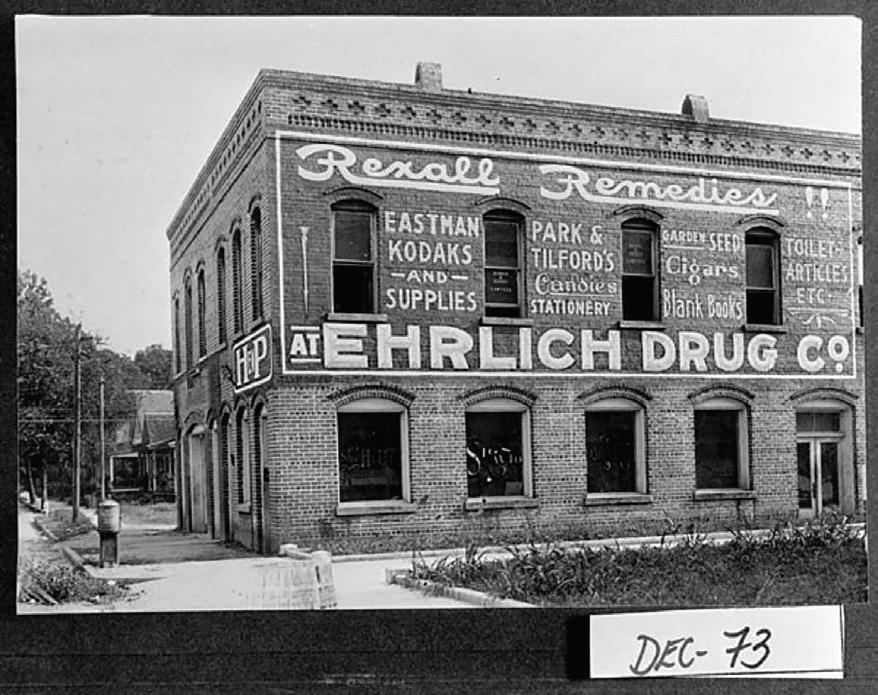
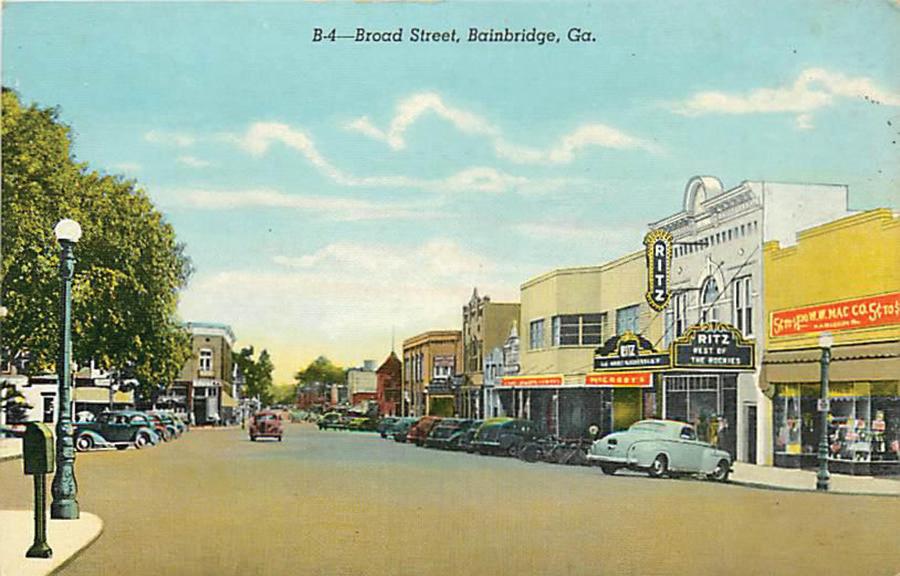








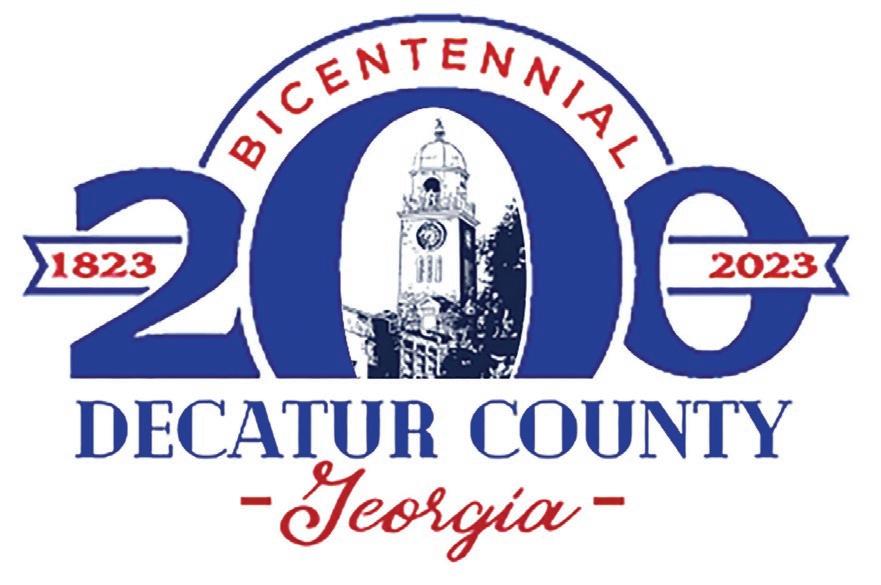
The Post-Searchlight
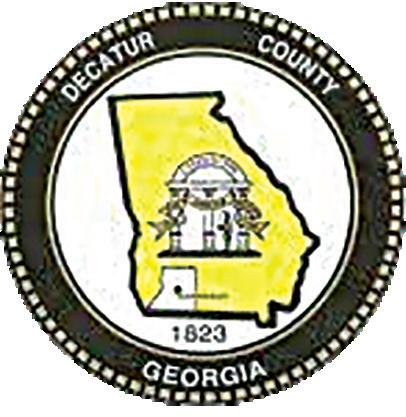
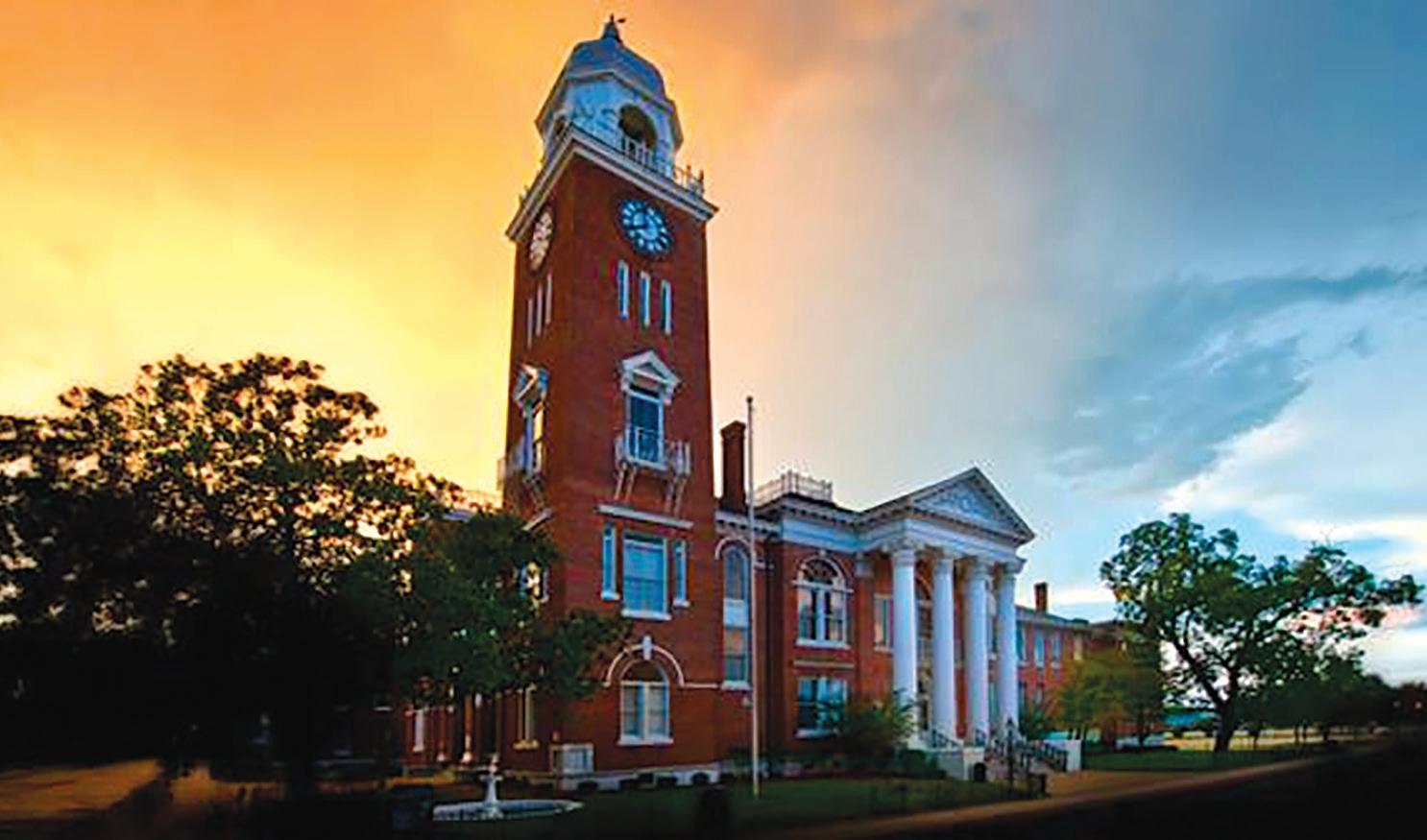

2 BICENTENNIAL EDITION


3 THE POST-SEARCHLIGHT
Table of Contents
Decatur County - Pages 6-15





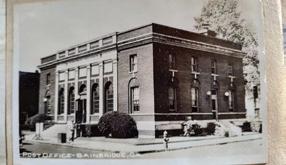

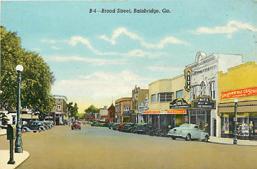

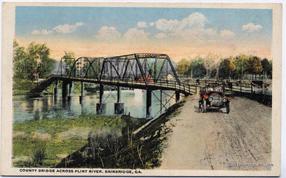

Communities - Pages 18-27
Disasters - Pages 28-37
Transportation - Pages 40-45
Medical- Pages 46-49
Hotels - Pages 52-55


Schools - Pages 56-59
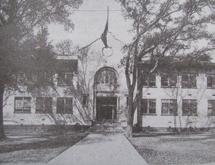
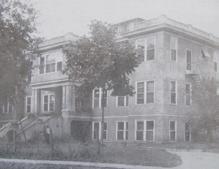

Land - Pages 62-69
Entertainment - Pages 70-73
Airfield - Pages 74-77
Newspapers - Pages 78-81

EDITORIAL
JOHN WELLS


General Manager
JOYCE KRAMER
Contributing Editor
ETHAN REDDISH
Contributing Editor
TRAVIS POLITAKIS
Contributing Editor
ALISON WELLS
Contributing Editor
4 BICENTENNIAL EDITION
THIS MAGAZINE IS A SPECIAL PUBLICATION OF


5 THE POST-SEARCHLIGHT
Decatur County formed in 1823 after legislature separates it from Early County

Although Columbus was born in Genoa, Italy, it was the Spaniards, the first explorers and settlers, who discovered the New World. Early in 1528, an expedition under Pamphilio de Narvaez landed somewhere at Tampa Bay, Fla., and proceeded north along the west coast. Narvaez reached the lake region north of Tallahassee in June 1528. On June 25, he reached a town called Apalache near the location of Tallahassee, or farther north in southwestern Georgia or near the vicinity of Chattahoochee, Fla. Here the Spaniards remained for 25 days and made excursions into the surrounding country. According to the narrative of Cabeza de Vaca, this place is thought to have been on Apalachee Bay. So possibly, men in armor visited the
hills and pine woods of Decatur County before the more renowned DeSoto.
In 1935 Congress appointed a commission headed by the Honorable John R. Swanton of the Smithsonian Institution to make a study of all written evidence of this. They examined the direct identification of topographical features of the country traversed by the Spaniards and the sites of Indian tribes and towns. Dr. Swanton spent a day in Bainbridge and Decatur Co., looking at river crossings and Indian mounds. From this kind of evidence, the commission decided on the most probable route. In Fla., the landing was placed at or near Bradenton, and the trail or route near Tampa, Ocala, Gainesville, Lake City, Live Oak, Madison, and Tallahassee, where
the winter of 1539-40 was spent.
On Wednesday, March 3, 1540, the expedition set out from the present Tallahassee vicinity and in one day, crossed the Gauca River (Ochlockonee) and two days later reached the Capachequi (Flint River) at or near the present Bainbridge. The record states that the stream was very swift. To cross it, they built a piragua (barge) and, to use the narrator’s words, “... they took the chains in which they were bringing the Indians, and with some ‘S’ hooks of iron fastened them together and made a chain of them all.” With a windlass of ropes and holding on to the chain, the crossing was affected, the horses being pulled along by long ropes, although some were half drowned. Modern cities and towns in Georgia
6 BICENTENNIAL EDITION DECATUR COUNTY
Submitted Photo
AMERICANA: A look back at Bainbridge’s historic downtown area, specifically the bustling traffic on Broad Street.
DECATUR COUNTY
on or near the route are Bainbridge, Leesburg, Abbeville, Hawkinsville, Dublin, Louisville, and Augusta.

Quoting more directly from the Commission’s report: “The Flint was probably crossed at or near the site of Bainbridge. It was here that the old Spanish Road, the so-called Camino Real, passed it as appears from the PurcellStuart Map of 1778.”
Immediately on landing, the Spaniards captured some Indians and forced them to become burden bearers. This made enemies of the natives, and continued resistance met the explorers. In winter quarters near Tallahassee, a young Indian told the Spaniards of a region abounding in gold and even described the mining and refining and agreed to act as a guide. He seemed to have simply followed Indian trails and became completely lost before reaching Augusta. So they depended upon guides from one tribe to another. At no place can it be said with final authority that DeSoto stood on “this spot,” but the weight of authority is that he went a short distance into South Carolina, touched North Carolina, into the southeast corner of Tennessee, to the northeast corner of Alabama and then almost to Mobile.
Then the route took a northwesterly course to cross Mississippi and on into Arkansas. He touched Oklahoma, went back into Arkansas, and down into Louisiana, where DeSoto died and was buried in the Mississippi River, a perfect ending of an explorer’s career, and also the end of a disillusioned and
financially ruined man. His followers tried to reach Mexico by land through Texas, but turned back and went down the Mississippi in boats strong enough to go by sea to Mexico, which they reached on September 10, 1543, with 311 of the original company and 100 Indians surviving. Thus ended four years of fruitless search for riches and power by one of the most remarkable expeditions of all time.
The Legislature Of 1823, in an act introduced by Representative Richard Spann of Early Co. and assented to by Governor Troupe, December 19, 1823, formed Decatur County out of the southern part of Early County being land Districts 14, 27, 15, 16, 17, 18, 19, 20, 21, 22, and 23; the new county being about 30 miles north to south, and 60 miles east and west, extending from the Chattahoochee River to beyond the Ochlockonee River.
The Act Of The Legislature forming Decatur County, December 8, 1823 (separating Decatur County from Early County) “From and after the passage of this act, the county of Early shall be divided as hereafter pointed out, beginning where the district line dividing the fourteenth and twenty-sixth districts strike the Chattahoochee River and continuing said district line east to the corner of districts number ten and seventeen in said county of Early on the Irwin County line. All of that tract of territory lying south of the line aforesaid, belonging in the County of Early, shall be called and known by the name of
Decatur County.
“That the balance of Early County forms one county, and retains the name of Early. That all civil and military officers that may be residing in the aforesaid counties shall continue in office. County of Decatur shall be attached to the Southern Circuit.’
Characteristics of the County
Shortly after the turn of the century, various literature was published outlining the main features of Decatur County. Some of the information from those publications follows:
“Decatur County is situated in the southwestern corner of the State of Georgia, bounded on the south by Florida and on the west by Alabama. The Chattahoochee River is the western boundary and the Flint River runs through the middle of the county. Both of these rivers are navigable for the larger river boats, and their outlet is at Apalachicola on the Gulf of Mexico, in close touch with the Panama Canal. The distance in time to Montgomery, Alabama, by rail is six hours, to Savannah and Jacksonville eight hours, to Atlanta twelve hours and to New York thirty-two hours.
The county is about forty by thirty miles and contains more than threequarter of a million acres. There is little of this that is not available for agriculture, and most of it is susceptible to a high state of cultivation, as will be seen by a casual survey of the county. This is


7 THE POST-SEARCHLIGHT
DECATUR COUNTY
brought about by both the nature of the soil, the undulating character of the lands and the many streams and rivers traversing the county that make a perfect system of drainage.
The population is approximately 35,000, about 60 percent white and 40 percent color.
The county tax rate averages from 6 to 7 mills per annum. Property is returned for taxation at about 75 percent of its valuation. The county has no bonded indebtedness. A $45,000 court house was built a few years ago by direct taxation without an increase in rate. The courts and county government are administered on an economical basis. Between $30,000 and $40,000 per annum has been and is being spent in building and maintaining a system of good roads throughout the county.
The soil is generally of a gray loam, and there is the good Norfolk sandy loam and the Gadsden sand, and much of the phenomenally rich brown pebbly land. The subsoil is of red or yellow clay with sand mixture. Almost all of the soil of this county is susceptible of a high state of cultivation, and readily responds to intelligent effort.
Good lands near the railways are selling for from $10 to $40 per acre. There is plenty of desirable land yet to be had for $10 per acre, but the tendency of the price is upward and lands will not be as cheap as they are now for a great while longer. There is still a large acreage in the hands of the turpentine and saw mill men, but this is gradually being released for farming purposes.
Bainbridge is the county seat of Decatur County, situated upon the Flint River and three railroad lines. It is one of the most charming little cities of the South, with a steadily growing
population of 7,500. Its streets and parks are the most beautifully shaded of any in all this lovely Southland.
Bainbridge is destined to become the most important Sumatra tobacco market in the world, for Decatur County has now the largest tobacco plantation on earth. The lands of this county produce from 1,000 to 1,500 pounds of the finest Sumatra wrappers per acre, which is today selling for $1.00 per pound in the barns, and yet these lands, unimproved, can be bought for $100 per acre. The tobacco product alone of this section will bring this year (1907) between five and six million dollars, and the industry is only in its infancy.
For the sportsman we have the finest quail shooting in the entire South, and almost at our very corporate limits, while along the banks of Flint River turkeys and other large game abound.
‘Tis the ideal spot for the hunter
from November 1st to March 15th. The Hotel Wainman is especially arranged for the comfort of its guests, and is a lovely hotel, new and with all modern conveniences.
Bainbridge...a little city of 5,000 inhabitants..
Its industries are railroad shops, foundry and iron works, oil mill, merchant mills, cooperage factory, bottling works, ice plant, syrup refinery, saw and planning mills, variety works, brick yards, cigar factories, tobacco packing houses, and other smaller industries. A fertilizer factory and cotton mills are the new industries that are practically assured.
The mercantile interests of Bainbridge are in a flourishing condition. Especially is this true in the wholesale grocery line. Four houses are supplying river points and a large territory in the three States contiguous to Bainbridge. The Standard Oil and the Gulf Refining Co. use Bainbridge as a
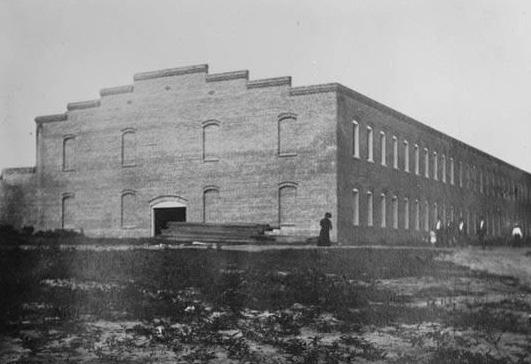
8 BICENTENNIAL EDITION
Submitted Photo
A PROFITABLE INDUSTRY: Tobacco packing houses were a popular industry at the time. One of the tobacco packing houses was located inside Decatur County in a small community known as Amsterdam.
DECATUR COUNTY
distributing point for this territory. There is now a splendid opening for jobbing in other lines.
All the leading churches have congregations and handsome places of worship here. The city schools keep pace with the most progressive cities of this class, affording excellent educational advantages. Its three banking institutions are financially strong and accommodating. The spirit of progress dominates the town.
Agriculture is becoming to be the chief industry, for with the passing of the timber interests, for which the land was at one time supposed to be mainly valuable, the lands are being and have been put into cultivation with marvelous results. They will produce from one-half to a bale and one-half to the acre. Mr. E.A.J.
Rich, a reliable farmer, gathered and ginned from 20 acres of ordinary land 20 bales of cotton by the first of October, and estimated that there were 5 bales more in the field. And this, too, was when cotton was hovering around thirteen cents. Corn will make from 15 to 40 bushels per acre, oats 20 to 30, sweet potatoes from 200 to 400 bushels, tobacco (leaf) from 1,000 to 1,500, hay and all forage crops in the greatest abundance, rice, peanuts, pumpkins, velvet beans, peas, in fact all the fruits and vegetables and almost anything that can be grown in any climate.
Cane is one of the most important and remunerative crops in this county. Its Sapallonast. From one acre enough cane can be grown to make 450 gallons of syrup, which put in barrels, is staple, and will readily sell to the buyers or to the refinery from 28 to 35 cents per gallon. If made with care and put in case or bottles it brings 75 cents or more. These
estimates are conservative. Individual farmers are making more per acre on all crops than the estimates set out above. It pays to farm in Decatur County. This is evident from the fact that our farmers are reaching out and improving lands and getting more independent every year.
Labor conditions here are good. It can be had at reasonable prices.
The rainfall is regular. There are no undue wet or dry seasons. The temperature in winter is that of a semitropical climate. Snowfall is unknown and freezes occur but few times during the winter. The heat of summer is tempered by the constant breezes in circulation, occasioned by the proximity to the gulf. Neither the heat nor the cold interferes with outdoor work here-it can go all year around.
The ease with which artesian water can be obtained has revolutionized the health of this county. These wells can be sunk at a small cost and absolutely pure water obtained within 150 to 200 feet of the surface, and that in the greatest abundance.
Consequently fevers have been reduced to the minimum in occurrence, and their type is said to be not as severe as those of the higher latitudes.
For years the people of this section have utilized the ranges for raising the common breeds of cattle, sheep and hogs, and some of them have become comfortably rich. Anyone purchasing a large tract of land from which the timber has been cut is in a position, with improved breeds, to reap a fortune as the result of one’s efforts. Native cattle are being improved, with marvelous results, by breeding with the beef varieties, likewise is the razorback hog being improved and makes the best bacon in the world.
Poultry has become quite an item in this section, and eggs bring in the local market from twenty to thirty cents, with chickens from twenty-five to sixty cents according to age.
The people of this section know little of trucking, though the lands and climate make this locality especially adapted to gardening. This section is located so that the truck grower gets his products into market just behind the Florida producer, thereby receiving a stable price for his produce. The staple crops can be raised here in profusion and with little effort. There is a great field here for the truck farmer.
Donalsonville is a growing town, 21 miles west of Bainbridge on the Atlantic Coast Line, having a population of about 1,000. It has a flourishing public school, a bank and the leading churches.
It has two large ginneries, and a new oil mill and fertilizer works.
The mercantile business thrives here. The lands around Donalsonville and Iron City are some of the best in the county, and farming is being developed on the latest and most improved methods. Iron City lies five miles east of Donalsonville on the same line of the railway. It has about 500 inhabitants and a good banking house.
Here is one of the best public schools in the county. The merchants are live and progressive. The farming lands around Iron City are equal to those of Donalsonville in fertility and are being intelligently improved.
Brinson is on the A.C.L. railway 10 miles west of Bainbridge, on Spring Creek, the most beautiful little stream of clear water to be found anywhere. It has a population of about 500. It has the largest sawmill in the county. A number of mercantile houses
9 THE POST-SEARCHLIGHT
cater to the trade of the good farming territory surrounding it. The public schools here are exceedingly good.
Climax is 10 miles east of Bainbridge at the highest point on the A.C.L. railroad between Savannah and Montgomery hence its name. Also the branch line of the railroad runs from here to River Junction, Fla. The population is about 250. The merchants are progressive and are doing much to aid the farmers in developing the fine agricultural section contiguous to it.
Fowlstown, Faceville and Recovery are smaller towns on the branch line between Climax and River Junction, in the southern section of the county. They are each wide-awake little towns, having good schools and an intelligent citizenship. They are in what is known as the tobacco growing section of the county, and rate their lands as of the best, and they are.
Attapulgus is located on the G.F. & A. railroad 12 miles south of Bainbridge, near the Florida line, and has a population of about 200. It is in the center of the tobacco growing section. The lands are high and rolling and productive of all crops. This is one of the prettiest towns in the county. Eldorendo and Strickland are small towns on the G.F. & A. north of Bainbridge. This is also a good section and these are desirable towns in which to live.
Besides the railroad towns which have been named there are numerous populous communities in the county, provided with stores, post office and schools, rural delivery and physicians, where life is pleasant and profitable to the agriculturist. Among them are Vada, McReaville, Bingen, Fairchilds, Miriam, Reynoldsville,
Boyettville Steam Mill, Lela and Amsterdam.
The public school system of the county is skillfully managed, and is effective and growing more so every year. There are 85 or 90 schools and about 150 teachers, with an enrollment of about 6,000 pupils in the public schools, outside of Bainbridge schools. Bainbridge schools have an enrollment of 1,100.
The appropriation from the State maintains the common schools for six months. In 25 or 30 districts they are supplemented locally for nine months. The opportunity for good common and high school education in this county, and the accessibility of pupils to the schools, is equal to that of any county in the State.
The Crvene Institute This new school, under the dominion of the Bowen Missionary Baptist Association and kindred association of this section in Georgia, Florida and Alabama, has just been established at Cyrene, Ga., eight miles west of Bainbridge on the A.C.L. railroad, and is attached to the Mercer system of schools. In effect it is destined to be far reaching, affording to this section, as it will, education advantages hitherto not within the reach of a vast majority of pupils. All branches, from the industrial to the classical, will be embraced in its curriculum-$30,000 having already been spent in buildings and equipment. More money will be spent to carry out the purposes of the institution until it is perfect.
The Commissioners of this county have been building good roads for six years. When they began the roads were little better than rugged trails through the woods- and there were close on to 1,000 miles of them. Now about half of them have been built with sand-clay 30 feet wide, present-
ing a smooth, durable surface, and are the pride of the people of the county and the envy of other counties. All main roads, about 400 miles, have been built by this method, and at the same time most of the other roads have been improved.
The county is spending from $30,000 to $40,000 per year on its roads, using convicts and improved road machinery. The convict force varies from 60 to 90. The county owns a farm of 1,100 acres on which enough is produced to feed all its men and mules.
Experts who have seen the roads of this county and those of other counties of the State say that there are only two other counties that are building as good roads as Decatur, but none can equal this county in the mileage built and maintained.”
The First Seminole War and Construction of Forts
Historians generally agree that there were two Seminole Wars. The First Seminole War (1816-1818) occurred after 36 Indian chiefs ceded the southern fifth of Georgia to the federal government, but the Seminoles under Chief Enemehautby not only would not move out, they raided and massacred Georgia settlers over a wide area. He was aided and abetted by British traders and soldiers operating out of Spanish Florida, a mixed-up international situation.
During this period, Fort Scott in Decatur County was the spearhead of the U.S. offensive. It was a log fort located on the west side of the Flint River on the first high bluff upstream from the junction of the Flint and Chattahoochee. Several crystal clear springs were nearby.
DECATUR COUNTY 10 BICENTENNIAL EDITION
The 4th and 7th Infantry Regiments were stationed there at times. Gen. Andrew Jackson spent the night in the fort on Feb. 9, 1818. Another future president, Zachary Taylor, was a junior officer there for a while.
Being of log and palisade construction, nothing remains and the site is partially inundated by Lake Seminole. Several thousand Indians laid siege to the fort after the battles of Fowlstown without success except to reduce the supplies to a nearstarvation level just before Jackson arrived.
We get a word picture of the fort from an Inspector General’s report to the War Department dated Apr. 30, 1817: “... nothing more than a temporary work of logs, with a small magazine, two twenty-four pounders, mounted on seacoast carriages, together with some smaller caliber. The bank of the river is so high and perpendicular... impossible for the enemy to do injury on that part. The men’s barracks of squared logs, laid close together; all in one line parallel with... river back about one hundred years; put up so as by closing doors and windows makes them secure in front from small arms; and by closing the flank with a picket work would secure 300 men... as long as supplies and ammunition would hold out. Officers’ quarters.. between the men’s barracks and the river.”
While there is no record that the

Indians ever killed a man at Fort Scott, disease and pestilence certainly did, mostly malaria, yellow fever and dysentery. Man had not discovered that the first two were carried from man to man by mosquitoes, but some believed it was healthier on high ground than low swamp.
Although Fort Scott was on a bluff it was surrounded by swamp, across the river the hills were higher, so after the Indians were fully defeated, the sick who were able to travel were moved there, and Camp Recovery was established. It still did not work very well. An early Bainbridge newspaper (1882) said 300 were buried there. More accurate, however, must be the Surgeon General’s report Jan. 1, 1821. He said 70 sick men “capable of enduring the fatigue” were moved on Sept. 15, 1820, but scarcely were tents pitched before a heavy rain lasting five days “produced irreparable injury to all the sick.”

Later the colony revived, “one or two dropping off occasionally until the 22nd of Oct., when the sudden fall of the thermometer laid all prostrate, some of them never more to rise.” On Nov. 23 the camp was abandoned and the surviving sick returned to Fort Scott.
The site is owned by N.L. Sellers and is marked with an upright cannon monument, but no graves were permanently marked and have disappeared.
While the U.S. soldiers were based at Fort Scott, Chief Enemehautby was based at his village of Fowlstown somewhere along the Four Mile Creek across the Flint and about 12 miles further upstream. He sent word to Major David E. Twiggs “not to cut a stick of wood on the East side of the Flint,” saying the land was his, that he was “directed by the Powers above AND BELOW to defend it and would do so.” Gen. Edmund P. Gaines, the commandant, sent Maj. Twiggs with 250 men to bring the chief to him to “ascertain whether or not his hostile temper had abated.” Gaines’ supplies were very low and he needed Indian corn and other provisions.
On Nov. 20, 1817, Twiggs attacked Fowlstown and killed four warriors, while the rest fled into the swamp. He apologized to Gaines and hence up the chain of command for also killing an Indian woman. He explained that they all had blankets about them and his men could not tell men from women.
A few days later the Second Battle of Fowlstown occurred. This time Gaines sent Lt. Col. Matthew Arbuckle with 300 men.
Approximately 60 warriors attacked the approaching Americans. Indian losses were estimated at six or eight. The American musician (described in some reports at Bugler Aaron Hughes and in other reports as a fifer) was killed and two men were wounded.
DECATUR COUNTY 11 THE POST-SEARCHLIGHT
DECATUR COUNTY
In going and returning from Fort Scott to Fowlstown, the Americans came all the way up the river and crossed at present-day Bainbridge. It had been the Indian village of Puckanawithla and, later, the trading post of James Burgess, who died in 1799.
In returning after the second battle, Arbuckle built a small “picket fort” of logs. There they buried Bugler Hughes and nursed the two wounded men before returning to Fort Scott with two wagon loads of Indian food. Later Capt. John McIntosh and 40 men were stationed at Fort Hughes for about three weeks. It was never used after that and disintegrated within a few years, but still existed when the streets of Bainbridge were laid out.
In 1882 Congressman Henry G. Turner persuaded Secretary of War Robert T. Lincoln (son of Abraham) to provide Decatur County with three cannons from Fort Clinch at Fernandina, Florida, and mark the sites of Fort Scott, Camp Recovery, and Fort Hughes. After Jim Woodruff Dam created Lake Seminole, the Fort Scott marker was moved to Fort Hughes, where the two stand side-byside in Chason Park on West Jackson Street.
Stephen Decatur
Stephen Decatur, for whom the county was named, was born Jan 5, 1779, in Sinnepuxent, MD. When he was only a few months old, his parents moved to Philadelphia, their former home. In 1798, he entered the Navy as a midshipman and saw some service against the French. In 1801 he served as first lieutenant of the Essex. Sometime after, he was appointed to command the brig Argus and

joined the squadron of Commodore Preble, then lying before Tripoli. It was here that he engaged in the dangerous enterprise of recapturing or destroying the Philadelphia, which had been taken by the enemy. He boarded and burned the vessel without losing a man and escaped under the fire of 141 guns. Nelson pronounced this “the most daring act of the age.”
Congress voted him their thanks and a sword and promoted him to the rank of post captain. In the War of 1812, Decatur captured the British ship Macedonian, one of the enemy’s best vessels. The whole country resounded with his name, and cities vied with each other to do him honor.
Replying to a toast at a dinner in Norfolk in 1816, Decatur exclaimed:
“Our country, in her intercourse with foreign nations may she always be in the right, but our country, right or wrong.”
After the War of 1812, a squadron was sent to Algiers to demand satisfaction for many injuries to the commerce of the United States. With some reluctance, the Dey consented to giving up his long custom of being paid tribute. “Even a little powder,” said the negotiator, “would answer.” “If,” replied Decatur, “you insist upon receiving powder as tribute, you must expect to receive the balls with it.”
The treaty was signed. Decatur then went to Tunis and Tripoli and obtained a redress for wrongs to commerce. On returning home, he was appointed one of the members of the Board of Navy Commissioners. While in the discharge of his duty, he was challenged to single combat
12 BICENTENNIAL EDITION
Submitted Photo
THE MAN BEHIND DECATUR COUNTY: Pictured above is Stephen Decatur, for whom the county was named after.
DECATUR COUNTY
with pistols by Commodore James Barron and was mortally wounded. His death produced a great sensation. Commodore Stephen Decatur was buried in St. Peters Church lot in Philadelphia, PA.
Bainbridge named in 1824
“Among the many who have distinguished themselves in the youthful noon of the Navy of our country, few have ranked higher than Commodore Bainbridge. By his own merit and exertion, he raised himself from the rank of a common sailor, to a merchantman, to the highest rank in the Navy.”
“William Bainbridge was born at Princeton, NJ, May 7, 1774, being descended from ancestors of high standing, who had for several generations resided in NJ. At the age of fifteen, he was seized with a sudden desire to go to sea, and his importunities prevailing upon his parents, he was placed on board a merchantman sailing from Philadelphia. When only eighteen years of age, he was promoted to the rank of first mate of a vessel in the Folland trade; during the voyage he suppressed a mutiny among the crew, and saved the life of the commander by his own intrepidity and energy of character. For this act of manly conduct, and his great nautical skill, he was appointed captain of the same vessel, at the age of nineteen.”
The Dey of Algiers commanded him to carry the tribute to the Dey to the Sultan of Constantinople, and to haul down his own flag and run up that of Algiers. Bainbridge angrily refused. “You are my slaves, for you pay me tribute,” said the Dey. “You must do as I tell you.” The castle guns were trained on the vessel, and Bainbridge was compelled to obey. On his return, he wrote to the Secretary of the Navy, saying that, “I hope I shall never again be sent to Algiers with tribute, unless I am authorized to deliver it from the mouth of our cannon.” In 1815 a war started with Algiers and the other Barbary powers and resulted in a discontinuance of payment of tribute money by the United States.
In the War of 1812, Captain Bainbridge commanded the Constitution, and in a fight with the British ship Java, the name “Old Ironsides” was bestowed on the Constitution. For this record with the Constitution, Captain Bainbridge was given the freedom of the city by New York and by Albany, NY, each letter being in a gold box. Philadelphia gave the gallant officer a plate service, and Congress distributed $50,000.00 among him and his crew.
members of Congress and for Senate and House of Representatives in the State Legislature, and for all County officers, so far as respects the County of Decatur, may, and shall hereafter be held at the house of William Forsons, in the eighteenth (district), and at the Court House of said county.”
By using the word “permanent”, the grave legislators determined there should be no more change in name to confuse travelers and the mailman. The site is located on the east side of the Flint River, upon a high bluff, about 75 feet above the ordinary water level of the river, and the sea level at the southwest corner of the post office is 135 feet. The Flint River, at its highest, has never invaded the city limits, but 2 miles north and south, it has covered the lowlands, completely surrounding the city and leaving it an island.
This circumstance explains why the Indians, then Burges, and then the U.S. Army selected the site for habitation. It also makes it more probable that DeSoto crossed the river at a point north of the A.C.L. Railway bridge which is opposite “Honey Bee Bluft.” At these places have been found broken pottery of Indian origin.
(From
Frost’s Pictorial History of the American Navy.)
The United States, along with other countries, had been paying tribute to the Barbary States of Northern Africa to secure immunity for merchant vessels. Captain William Bainbridge took the tribute to Algiers in 1800, in the frigate George Washington.
The present site of Bainbridge was an Indian village in 1765 with James Burgess as a trader. It began being known as Burges at least as early as 1778, and was called Fort Hughes from 1817-1824, when the legislature enacted the following law:
“That from and after the passing of this act, the present site of the public buildings in the County of Decatur be, and the same is hereby made permanent, and shall be called and known by the name of Bainbridge,” “And it was further enacted that all elections for
The original survey of Early County by one Clem Powers, dated Jan. 10, 1820, shows four houses on lot 224, the “Old Brick Yard” and both here and around Fort Hughes occur the notations “Old Fields.”
The name Fort Hughes continued to be used for some time by the Inferior Court records after 1824. According to a sketch by Daniel McGill, published in 1877, in a booklet entitled “City of Bainbridge and County of Decatur, Homes for Emigrants and Invalids” there was
13 THE POST-SEARCHLIGHT
but one resident prior to 1824. This was a man named Moody, who had been a soldier in the command of General Jackson in his campaign of 1818 against the Seminole Indians. When the Army withdrew, Mr. Moody built a cabin near the fort and kept a ferry at a point near the first bridge for several years. The main army of General Jackson withdrew in the summer of 1818, but at least two companies of infantry were kept at Fort Scott until 1821, with the exception of a few months in the early part of 1820. So Mr. Moody could have settled in 1818.
In the Ordinary’s office is a complete file of the early tax digests and they shed interesting light on the
property and the values of those early days. Also, they reflect the low cost of government. Polls of voters were listed as 130, defaulters 14, and slaves 271. Poll tax and tax on each slave was 31-1 / 4c. Land was divided as to quality as follows: 250 acres of first quality $1.06-1/4 for lot. 7975 acres of second quality tax 62-1/2c for a lot of 250 acres. 810 acres third quality tax 31-1/4c for a lot of 250 acres. 125 acres swamp land and 13340 acres pine land tax 18-3/4c for a lot of 250 acres.
A two-wheel carriage was taxed 50c and one of four wheels $1.00. Tax on a stallion was $5.00. Town lots were taxed at 31-1/ 4c per $100.00. John Donalson, Sr. and James Brown
each owned two-wheel carriages and Martin Harden one of four wheels, the only ones returned. It was the custom to return for taxes real estate where the owner lived. The taxpayers of Decatur Co. returned 4225-3/4 acres of second quality land, 1154 acres of third quality and 19926-1/4 acres of pine land located in other counties of Georgia. These counties were principally Tatnall, Screven, Henry, Pulaski, Wilkinson, Irwin, Appling, Houston and Monroe. So probably the bulk of the first settlers came from these counties. No livestock, household goods or merchandise were on this first digest. John Donalson and Martin Harden returned town lots in Hartford and
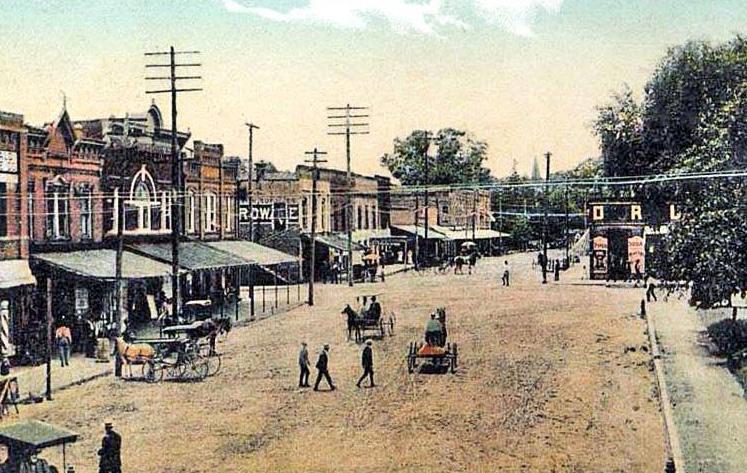
14 BICENTENNIAL EDITION DECATUR COUNTY
Photo
Submitted
CARTING DOWN THE STREET: Two- wheel carriages, which were taxed 50 cent at the time could be found on Broad Street heading south.
DECATUR COUNTY


Daniel O’Neal one in Hughborough.
The largest taxpayers were: John Donalson, with 50 slaves, 1000 acres of land in Decatur Co., 1628-1/2 acres in Pulaski Co. and one lot in Hartford, GA, worth $560.00, two two-wheel carriages. His taxes were $24.93-3/4. George Gaines with 23 slaves, 500 acres of land in Decatur Co. and 2192-3/4 in Pulaski and Laurens and his tax was $11.41. The total amount of taxes collected was $210.18-3/4.

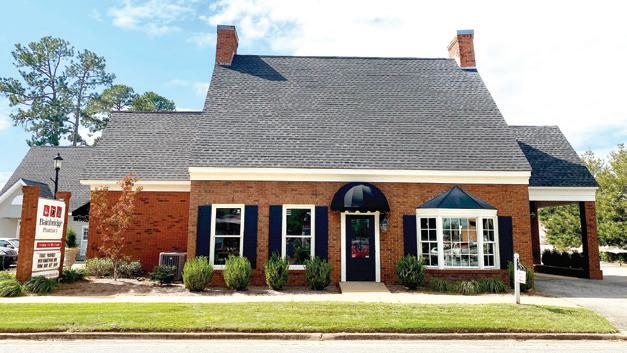
In a turn-of-the-century pamphlet, real estate prices are listed at between $8 and $40 per acre for farm acreage under fence, cleared and under cultivation, to woodland located on two-auto (two-lane) highways, 2-1/2 miles from Bainbridge in populated communities.


15 THE POST-SEARCHLIGHT





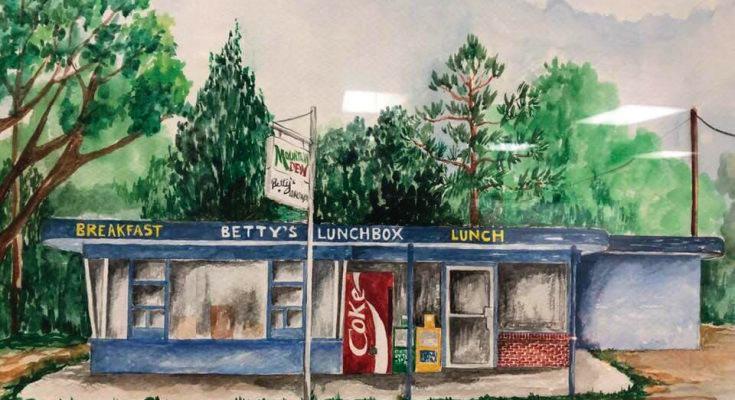

16 BICENTENNIAL EDITION













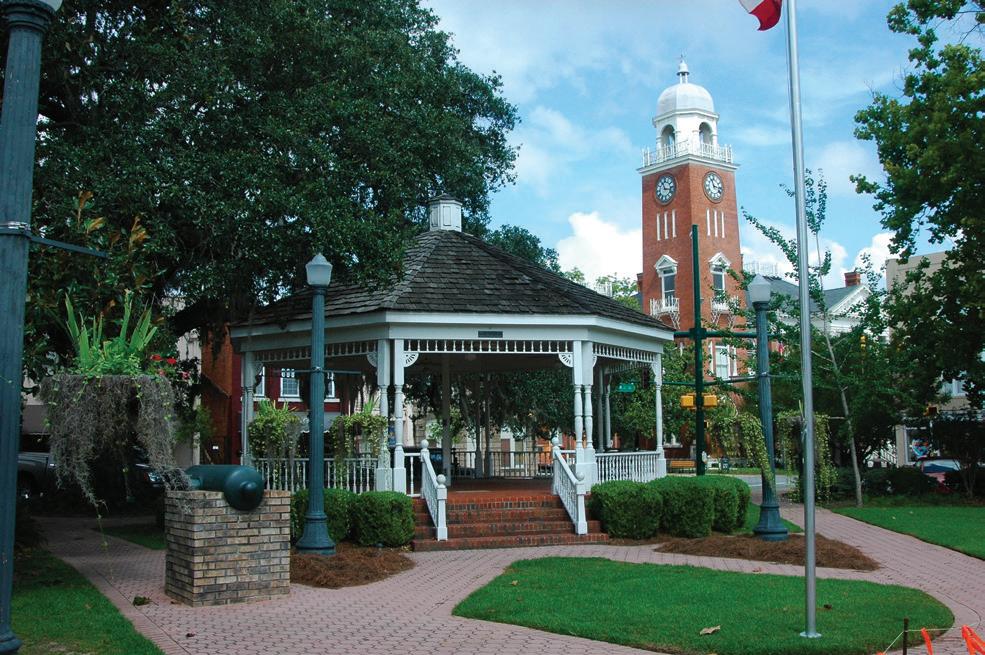

17 THE POST-SEARCHLIGHT
History of Decatur County showcases several surrounding communities
The history of this area would not be possible without the writings of such dedicated local citizens as Frank S. Jones, “The History of Decatur County”, and Maston O’ Neal, Jr., “Prologue”, along with the photographs by Andrew Avery and Bertram Ehrlich.

Much of this brief history of Bainbridge is based on their material, and readers are encouraged to review it at the Southwest Georgia Regional Library.
Indians had occupied the bluffs along the river where Bainbridge is now located, long before the white man arrived in this hemisphere. In 1765, the settlement here was known as Pucknawhitla, but later changed to Burgess Town when a trader by then established a trading post here. After Fort
Hughes was built, however, it went by that name until 1823, when acts of the legislature created Decatur County from the southern portion of Early County, and in 1824 stipulated that its county seat should be called Bainbridge, in honor of Commodore William Bainbridge, who had commanded the U.S. Constitution (Old Ironsides) in the War of 1812.
The original 50 acres, in the northwest corner of Lot No. 222, were deeded to the justices of the Inferior Court by Daniel Odom Neel, who had moved with his family to acreage west of Fowlstown in 1822. According to Dan McGill, a local historian who published in 1877, there was only one resident in the area at the time, others having left following the Indian War of 1818. William Moody, a
soldier under Andrew Jackson, built a cabin near Fort Hughes and kept a ferry there for several years. By 1829, however, there were 140 inhabitants. The original plot was bounded by the present streets of Shotwell, Clay, Planters and an extension of Washington Street to the north.
Towns in this section of the country grew largely around bridges spanning rivers, railroads, and roads. History indicates that Bainbridge would have been a much larger settlement if a more adequate bridge over the Flint River had been built at an earlier date. The earliest ferry of record associated with the Flint River was at Fort Scott, and belonged to John Griffin. In 1824 Mr. Moody had a ferry in operation in Bainbridge at Fort Hughes. The first bridge was a wooden
18 BICENTENNIAL EDITION DECATUR COUNTY COMMUNITIES
Photo GET YOUR GOODS:
Submitted
Attapulgus Commissary Co. General Merchandise is one of the first few stores that was built in Attapulgus.
DECATUR COUNTY COMMUNITIES
structure, privately owned, located just north of the present concrete structure. “About 1878 the United States notified the owners of the bridge to put in a draw to allow the passage of boats and twelve months were allowed. Nothing being done to comply with this order, a government boat came along and cut a passage through the bridge.” The second bridge was made of iron and was built by the County in 1880 and located just south of the present bridge. It was washed away by high water in 1925, and a temporary structure was built. The third bridge (Memorial Bridge) was started in 1922 and completed in 1926. The Brooklyn Bridge in New York owes its existence to Bainbridge/Decatur County, in that all the heavy timber needed for its construction was cut at Red Bluff (9 miles north of Bainbridge) and floated down the Flint River to Apalachicola for shipping to New York.
Since Bainbridge was the county seat, courthouses were constructed at various times, with the first being made of logs, and erected in 1816, and costing $110. “This courthouse was torn down and thrown in the river by friends of a man accused of forgery, this incident to the building occurring the night before the regular day for court.” The second courthouse was erected in 1832, costing $3,122. The third courthouse was two stories of brick construction, and built on the northwest corner of the square (Willis Park), and cost $6,700. In the yard of this courthouse was a fire alarm bell on a 40-foot tower. Cisterns were located at each corner of the courthouse. The fourth and present courthouse was built after the county bought the lot on the northeast corner of West and Water Streets. It was constructed in 1901 at a cost of $32,500.
Bainbridge had at various times in its early life five opera houses, two theaters, a horse racing track, and at
the same time, 10-12 saloons. Since passengers from the steamboats, train terminal and stagecoach lines spent the night in Bainbridge, numerous hotels were constructed. The first hotel was M.R. Moore’s Tavern-its location and construction date are unknown but, “an early newspaper stated that Moore furnished food and drink for a July 4, 1829, festival dinner for $1 per person.” The second was Lester’s Hotel, of which a visitor wrote in 1834: “The town had one hotel, Lester’s Hotel, which had very few borders and very little to eat.” The third
hotel was William W. Harrell’s Hotel, built by William Washington Harrell. Mr. Harrell was born near Climax in a covered wagon in 1822, and was the first white child born in Decatur County. His hotel later became the Decatur House, and in 1859 street lights were placed in front of it. Cook’s Hotel was in operation in 1854, and was later sold to John Hibberd, who operated it as Hibberd’s Hotel and Stage Depot. Charles Smith Daniel’s Stage Depot and Inn was on River Street. It was demolished about 1963. The Sharon House was a three-
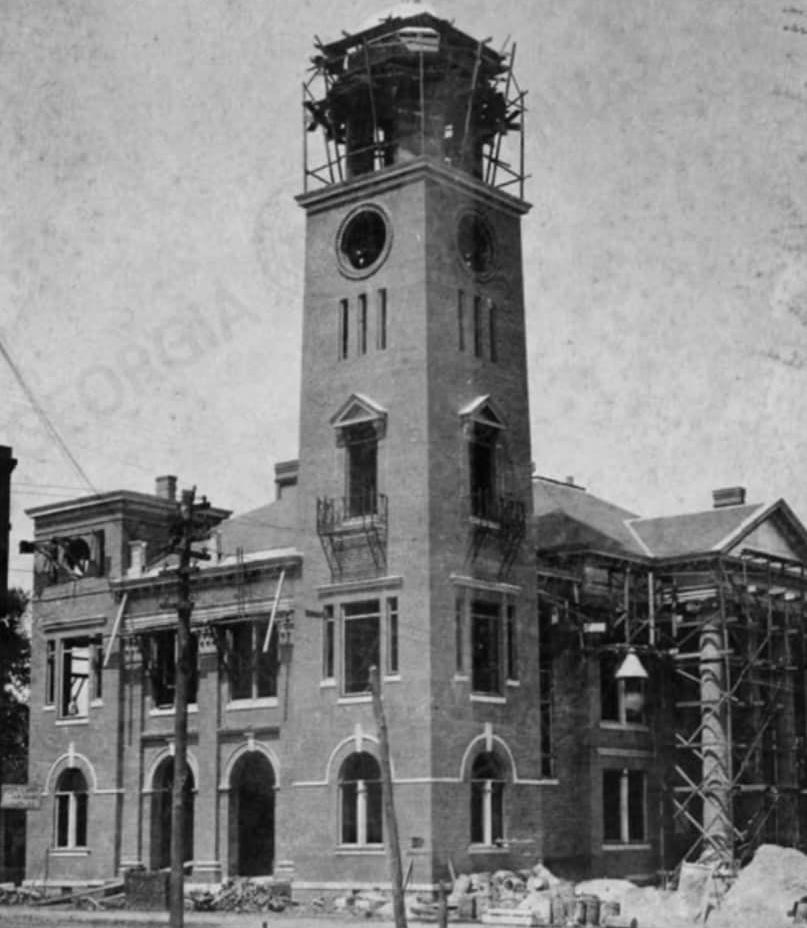
19 THE POST-SEARCHLIGHT
Submitted Photo
CONSTRUCTING THE COURTHOUSE: The courthouse has been reconstructed four times. It was constructed in 1901 for $32,500.
DECATUR COUNTY COMMUNITIES
story building completed in November 1869 on the north side of the square. It probably replaced a wooden building known as the Oakland Hotel operated by Captain Des Vergers. For a time the Sharon House was known as the Artesian Well House because of the artesian well on the northeast corner of the square. In 1901 the Bon Air Hotel came into existence and included part of the Sharon House. This hotel was three stories and had 53 guest rooms. The Wainman Hotel was constructed in 1900. Located on the site of the present Citizens & Southern Bank, it was built of brick, and boasted four stories with wide first- and secondstory verandas, and 50 guest rooms. Partially destroyed by fire, it was repaired and became the Stephen Decatur.
According to Maston O’Neal, Jr.: “The Chattahoochee River and the Flint River, together with their product, the Apalachicola River to the Gulf of Mexico, made the equivalent of a pretty big ready-made highway system. As a result Bainbridge got the earliest start of any town in Southwest Georgia-long before Albany, Moultrie, Tifton, Valdosta, Camilla, Cairo, Thomasville, etc. The Fannie was the first boat on the rivers. It came in 1828 and before the unrelenting pressures of railroads and motor vehicles the list of these craft had exceeded two hundred!” Railroads came to Bainbridge during the railroad building boom which swept the country in the late 1800’s. Bainbridge was fortunate to have two major rail crossings here, the ACL which connected Montgomery, Ala., to Savannah, Ga., and the G.F. & A. which ran from Tallahassee northward to join the Central of Georgia into Atlanta. Like the railroads, two major U.S. highways (27 and 84) also cross in Bainbridge.
The church history of Bainbridge was both exciting and full of disasters. Methodists, Baptists and Presbyterians had fires that destroyed their early church
buildings. Then the Episcopal church was destroyed by a hurricane in 1873 just as it was being completed.
Your attention is invited to other sections of this book for more information on the churches of Bainbridge. Early schools in Bainbridge consisted of the following:
• Decatur County Academy 1824 (Private)
• Bainbridge Female Academy 1840 (Private)
• Bainbridge Male & Female Academy 1854 (Private)
• Female High School 1857 (Private)
• Bainbridge Female College 1857 (Private) The Tallahassee Florida
• Bainbridge Academy 1858 (Private)
• Bainbridge Masonic Institute 1861 (Private)
• South Georgia Military College 1900 (Private)
• Georgia State Military College later became Bainbridge’s first public school. It was located on Green Street where it now intersects with Potter.
The second public school building, constructed in 1913, contained 14 standard classrooms, an office, restrooms, music rooms, basement lavatories and a beautiful auditorium. It was located on the east side of Potter Street between Green and Pine. For many years it housed grades three through eleven, the first two grades remaining in the wooden structure which faced north on Green.
In 1922 the third public school building was constructed on the west side of Potter Street. It housed the upper grades only, and the second building was used for elementary classes.
In 1940 the City Schools were merged with the County School System. Visitors to the city have always been impressed with the beauty of its mighty oaks and other vegetation. Known as Oak City, its
cemetery was bestowed that name by the city fathers in the early years. A Mr. R. Johnson, secretary of the Decatur County Immigration Society, writing in a publication entitled “Homes for Emigrants and Invalids”, said the following about Bainbridge:
“Enjoying, as it does, the advantages of almost uninterrupted health; in a country possessing the richest natural resources that nature can bestow; with an atmosphere as dry, but as soft and balmy, and as pure, as ever wafted over the plains of Italy, tempered daily by breezes from the sea; and nestling on its high bluff by the deep and beautiful river, under the shade of its gigantic oaks, Bainbridge offers a safe, as well as pleasant, retreat, in winter and in summer, to the seeker of health and pleasure. Here the man of health feels assured that his health will be preserved, and the man whose health has been wrecked by corroding consumption feels warranted, by the experience of others, in the belief that his health will be much improved, if not fully restored. With these advantages, may its friends not hope that, many decades before the next centennial, the eighteen hundred inhabitants of Bainbridge may be increased to more than as many thousands.” -July 4, 1876
No doubt he would be amazed to know that 124 years later this lovely town now covers 24.6 square miles, on both sides of the Flint, and its population has grown to 12,500.
Brinson
Brinson is located on the west side of Decatur County. Spring Creek forms its boundary. Brinson started as a small farming settlement. The soil is lightcolored, sandy loam of moderate fertility, and derives its character from the fact that the whole area was once a sea floor. Often rocks with fossil or sea shells are to be found. Brinson is basically level land
20 BICENTENNIAL EDITION
DECATUR COUNTY COMMUNITIES
sloping slightly west.
Over the years the people of Brinson have been proud of their churches, the oldest being the Methodist. The Baptist church was organized in 1900. In the early days, churches for black Baptists and Methodists were built and are still active.
The Brinson school district was established as early as 1890. The first school was a wooden frame building in the corner of the grounds where the present school building is. The nice brick building was completed in 1923. The first class to graduate in the new building had 14 members. This accredited high school sent out many young people who have made good in their chosen professions. In 1970 a private school, The Oaks Academy, opened in the schoolhouse, since the public school had been moved to Bainbridge as part of the Decatur County school system.
The architectural history of Brinson begins with the oldest house, which is the log house built by Joshua W. Hodges. Another structure which predates the actual founding of Brinson is a small frame store building, a few feet west of the Hodges’ log cabin. This one-room building probably dates from the early 1870’s and was used as a store and post office by Simeon Brinson, who had moved into the log house soon after the death of Joshua Hodges in 1868. At the time that Hodges built this log house there was probably only one other family living within the future town limits of Brinson. This was the Sivan family who later sold out to Samuel G. O’Neal.
Simple one-story frame houses set the pace for most of the houses built in the early days of Brinson. Most were set on brick piers with brick chimneys and large porches. Several of these houses which fit this basic description still exist in Brinson. These houses were typical of small mill townhouses in the South in the late
Victorian period.
One major exception was the Simeon Brinson house, which is an excellent example of Victorian frame houses built by the upper classes in the late 19th century. The Brinson house is two stories on brick piers. The first story has a wrap-around porch which follows the irregular plan of the building. Notable features include the two three-sided bay projections on the north and east sides of the house, elaborate “gingerbread” trim on the porch roof and banisters, and a second-story sleeping porch in the front ell, narrow weatherboard siding with shingles in the gables and around the base of the sleeping porch. The gable roof retains its original pressed metal shingles. Without exception, the Brinson house is the finest example of Victorian architecture in
Brinson.
The Dr. H.H. Brinson house and the Dr. R.L.Z. Bridges house are fine examples of 20th century classical revival. Only a few examples of Bungalow architecture exist in Brinson. The Hodges’ house and the Methodist parsonage are two of these.
The Jones-Powell house represents the cottage style built between 1920 and 1930.
The commercial buildings of the early 1900s have been torn down. There were a few brick stores, and one brick bank, but most stores were of frame construction.
In the early years of Brinson, nearly everyone had a garden and a few pecan trees. Most yards were landscaped with shrubs and trees typical of South GA. Although the town of Brinson had been in existence since 1889, it was not until
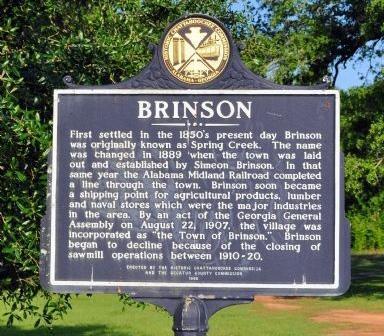
21 THE POST-SEARCHLIGHT
Submitted Photo
BACK HOME IN BRINSON: The historical marker showcases Brinson’s roots, when the town was originally known as Spring Creek.
DECATUR COUNTY COMMUNITIES

1907 that it had a municipal government. The town was incorporated under the name of Brinson. The legislature appointed Simeon Brinson as the first mayor, and H.M. Graham, R.L.Z. Bridges, J.D. Murphy and R.B. Webster as councilmen. Despite its size, Brinson is unique in two ways. It is the only town in South GA that owns, operates and controls its own water plant and light distribution. It also considers a minority of one so important that the Town Charter states that no alcohol of any kind can ever be sold as long as there is one dissenting vote. Brinson reached its zenith in 1910. In that year the population was 707. From then on, every census has reported a drop in population. It was not until 1925 that Brinson had electric current. Before then, current was available only from Delco systems owned by individuals. Other improvements over the years were in 1928 when building permits were required, and in 1982 when some streets were paved and a zoning ordinance was adopted.Then throughout the last 80 years, Brinson has managed to retain its identity and municipal government.
Climax
The town of Climax received its name because it is the highest point of elevation on the railroad between Savannah and the Chattahoochee River. The town was established after the Civil War. Duncan Curry, the earliest known settler, came to the area in 1824. His family came from

Scotland and settled in North Carolina. Next, they moved to Telfair County, Georgia, and finally on to Decatur County.

Curry settled 2 miles north of presentday Climax. He had three sons and one daughter- Calvin, Duncan Jr., Archie, and Sarah Jane. When they were grown, Calvin lived at home, Archie settled in Climax, Duncan Jr. settled in the area of what is known as Curry Hill, and Sarah Jane settled in the area of Attapulgus.
Around 1850, the Curry brothers built the first Presbyterian church in the area. The church was organized in 1852, the same time as the Bainbridge Presbyterian Church. They received their commissions from the Old Philadelphia Church of Quincy, Florida. It is said that the Bainbridge church was commissioned one day and the Climax church the next.
Another early settler to the area was Sutton Trulock. According to family history, Mr. Trulock settled in this area
BICENTENNIAL EDITION 22
Submitted Photo
COME TO VISIT CLIMAX: The historical marker showcases Climax’s roots, which indicate it was the highest point on the railroad between Savannah, Ga. and the Chattahoochee River.
DECATUR COUNTY COMMUNITIES
in 1840, but a census taken in 1830 lists a Sutton Trulock. The Trulock family came from England to Maryland. Then they moved to North Carolina and on to South Carolina. Finally, they settled in Decatur County, Georgia. Mr. Trulock settled 5 miles north of Climax.
Sutton Trulock was an orphan. His parents died when he was young, and he was given to someone to be raised. He was 60 years old when he came to Decatur County with his wife Mary Hines. She was very aristocratic, and it was said that she requested tea in bed every morning.
In 1867, the Atlantic and Gulf Railroad bought the present Climax depot site from Archie S. Curry. In those days the railroad built a link from Thomasville to Bainbridge and sold stocks in it. About 1880, the railroad wanted to build a branch line from Bainbridge to River Junction--the junction of the Flint and Chattahoochee Rivers. It was decided that the best place to build the line was on the Fowlstown ridge 8 miles east of Bainbridge. The Fowlstown ridge is a high ridge that runs the length of Decatur County. In 1883 the town of Climax was laid out along this ridge. The first deed of land sold in Climax was from Mary Jane Peabody to J.G. and C.H. Curry for 1/4 of an acre for $25. Mary Jane Peabody sold the second deed to A.J. Trulock for 1/2 an acre for $25.

Climax was incorporated in 1905. People began to settle and lots of land were laid out. The main street of the town was Front Street, which ran along the railroad track. Traveling salesmen, who were called drummers, traveled by rail and went through Climax to make connections down the line. They would have to spend the night in Climax, thus creating the need for hotels. There were two hotels in Climax-one was made of brick and the other of wood. Two passenger trains, many freight
trains and several mixed trains passed through Climax. One mixed train, the mid-morning “Josh,” was named after a fireman who rode it. During the night, this same train went down to Port St. Joe to bring back fish and oysters from the Gulf, but on the return trip it was known as the Apalachicola Northern.
Climax also had an impressive business district. It had the Farmer’s Bank, Trulock Supply Company, Brinson Meat Market, Mr. Moseley’s drug store, a barber shop, a post office, and Dr. Bailey’s office. Stores stayed open until 8:30. It is interesting to note that Climax was on Central time. The town had a Delco plant, which supplied electricity from 6 p.m. until 12 a.m. Black citizens had their own cafes, and every Saturday they would come to town and stay until 11 or 11:30 p.m. Climax reached its zenith as a community from the time it was incorporated until cars, trucks, and highways made it easy for people to go to
town.
The Climax area had several churches and a schoolhouse. In 1859, Curry Presbyterian Church was renamed Mineral Springs Church. In 1884, it was moved to Climax. The church is now in Westville, a replica of a pioneer town, in Lumpkin Co., Georgia. In 1890, the Baptist church was built. Before members had the church, they worshiped in a warehouse. Two miles south of town was the Methodist church. The Cedar Grove Cemetery was here. When the church was moved, the cemetery was renamed the Climax Cemetery. The town had a one-room schoolhouse, but it is no longer standing. Later, the school was moved to a house in town. The school was consolidated in the 1920s, but it burned in 1929. It was rebuilt in its present building.
Today in Climax, there is not as much as there once was. Passenger trains no longer run through the town. Now the
THE POST-SEARCHLIGHT 23
Submitted Photo
THE FIRST STORE IN FOWLSTOWN: The Fowlstown General Store also served as their US Post Office and can still be seen today in the community.
DECATUR COUNTY COMMUNITIES
dren and great-grandchildren live today in the area near Lynn Station.
Uncle Billy began buying, trading and selling land, and soon owned several lots of forested land. He farmed and continued trading, buying and selling land.
The G.F. & A. Railway wanted to come through the area and go on down into Florida, so he gave them a 200-foot rightof-way through his property. When they started building the railroad Uncle Billy built himself a nice, large frame house and moved his family close to the railroad, just across the highway and railroad from where the Amoco Fabric Plant is currently located. He gave some land for Mt. Zion Church was formed, and sold land on both sides of the railroad to Tom Rich, a young businessman and farmer.
Tom built a general store and started buying and selling land, mules and horses. He soon had a large farm opened up, and then he built and operated a sawmill. The government opened up a post office in his general store which was named Strickland for the Strickland family, relatives of Mr. and Mrs. Rich, but the small village town that had now grown up along the railroad and highway was named Lynn Station, for the Billy Lynn family.
The post office and store prospered, so Mr. Rich hired Maurice Valentine to run the store and post office. He was very energetic and efficient, and the volume of business continued to increase. Mr. Lynn and his wife had died. Mr. Valentine and his mother and wife, Minnie (Dean), lived in the old Lynn home, and it was there their first son was born.
The railroad also prospered and built a good-sized depot and freight station near the tracks. Three passenger trains a day came through-one at 11 in the morning going south, one at 5 in the evening going north, and another at 8 in the evening going south.
They put on a full-time passenger and freight agent. Arthur B. Roberts was the first depot agent. He was 17 when he was hired at $40 a month. That was good pay for a young man back in 1917. Arthur was soon promoted to agent at Eldorendo, a station 4 miles up the line. You could buy a ticket for the nearest stop, White’s Mill, a mile and a half away, or to the end of the line, Richmond, Ga., 100 miles to the north, or Carrabelle, FL, 100 miles south, or any stop anywhere in between. The freight business was goodlivestock, cotton, cottonseed, lumber, watermelons, fertilizer and anything you could move by box car, flat car, or tank car.
Tom Rich’s business continued to grow and he opened a grist mill and a cotton gin. He built large barns and warehouses and sold corn, peanuts, hay, cotton, cottonseed and fertilizer. There was now a line of tenant houses on each side of the

railroad, and along the highway which is now 27 North of Bainbridge.
Anyone who lived in the area could get a post office box at the Strickland Post Office. Its patrons lived over a large area of what is now the Pine Hill community. People walked in, rode bicycles or horses, came in buggies and wagons, and a few in autos to pick up their mail and buy what they were running short of at the general store -anything from plows and horse collars to kerosene oil for lamps and lanterns.
Mr. Rich, his wife Rosa, and children T.E, Pauline and Alee lived in a large white frame house with a porch around two sides which sat on a lawn just south of the post office and general store. He spent most of his time in the office which was in the back of the fore. It was there he smoked big cigars, leaned back in his chair, bought, sold and traded, hired and fired, and carried on his business. He
THE POST-SEARCHLIGHT 25
Submitted Photo
STOPPING IN AT LYNN STATION: This historical marker showcases the roots of William Belk “Bill” Lynn and Lynn Station. Lynn was instrumental in founding the community of Lynn Station.
DECATUR COUNTY COMMUNITIES
made decisions about the people, the community, the schools, the politics of the day, and especially the young people of the area. He wanted them to get a good education and a job.
Mr. Rich would occasionally give a gopher supper. His hands would capture a large number of gophers, clean and then cook them with rice in large cast-iron wash pots. He invited white and black friends to come and eat gopher and rice.
Wiley Griffin operated the cotton gin several months in the fall of each year. He lost an arm while operating the gin, but was very efficient and a skilled worker even with one arm. He was Sunday school superintendent and song leader at Mt. Zion Baptist Church.
Mr. Roberts, Arthur’s father, was over several of the business enterprises which he kept going smoothly. He lived in the old Billy Lynn house with his wife and family.
When the Roberts family moved to West Bainbridge, Mr. Larkin Culbreath and his family moved to Lynn Station where he operated the large sawmill and soon made a success of it. They used large carts with two heavy wooden wheels which were pulled with teams of mules or oxen to straddle the big virgin pine logs, and haul them from the nearby forests to the sawmill close by the railroad track.
Mr. Culbreath traded with Tom Rich for a lot of land heavily forested with big pines which he cut. He sawed them up at the sawmill, planed the lumber, and built himself and his family a large frame house across the road from Mt. Zion Church. The house still stands there today.
Charlie Adams ran the grist mill for years for Mr. Rich. He was known by everyone in the area. He wore a widebrimmed, black felt hat which was always covered with corn dust and weevil webs. He was always there to greet you and to
measure the toll and grind the corn into meal or grits. When Pine Hill School consolidated, Mr. Rich let the school have two frame houses on the highway to conduct classes while the contractor was building the new brick Pine Hill Consolidated School House about a mile and a half north of Lynn Station.
Lynn Station grew and prospered for close to 30 years. Mr. Rich then got into the real estate business in Bainbridge, and moved his family into town. He sold the farm and businesses at Lynn Station to Mr. Henry Shanks from Greenville, Ala. The railroad freight and passenger business began declining. Mr. Shanks was a really good farmer, but the depression hit and Lynn Station’s hayday was over. It surely made a difference in the lives and the outlook of the people of the community for two generations. It will long be remembered as a landmark in this area.
Recovery
In the early 1800s, 36 Indian chiefs ceded the southern fifth of Georgia to the federal government, but the Seminoles, under Chief Enemehautby, not only would not move out, they raided and massacred Georgia settlers over a wide area. During this period Fort Scott in Decatur County was the spearhead of the U.S. offensive. It was a log fort located on the west side of the Flint River on the first high bluff upstream from the junction of the Flint and Chattahoochee Rivers.
While there is no record that the Indians ever killed a man at Fort Scott, disease certainly did--mainly malaria and yellow fever. Man had not discovered that these diseases were carried by mosquitoes, but intuition told him it was healthier on high ground than low swamp. Although Fort Scott was on a bluff, it was surrounded by swamp.
The hills across the river were higher
than Fort Scott. After the Indians had been fully defeated, and with more than 70 of the 300 men stationed at Fort Scott ill with malaria or yellow fever, the Surgeon General requested permission to move his sick men to a high and dry place in hopes that they would recover. On September 18, 1820, the 70 bedridden men were moved across the river to a high knoll. This was the establishment of Camp Recovery.
This move did not work very well. The tents had scarcely been secured when it began to rain. The heavy rain continued for 5 days. A few of the men recovered sufficiently to be returned to duty at Fort Scott. Of the others, one or two passed away occasionally, until October 22, when the temperature dropped dramatically, and more of the men died. On November 23, 1820, the camp was abandoned, and the remaining sick were returned to Fort Scott.
The dead were buried at Camp Recovery, and the graves marked with wooden markers. However, through the years the markers rotted, so that there are no longer any marked graves. In October 1882, a monument consisting of a 32-pound gun with barrel on end and a granite block from Georgia’s Stone Mountain was erected, with the inscription “Erected on the site of Camp Recovery near which are buried officers and soldiers of the United States Army who died during the Indian Wars in the Flint and Chattahoochee River Country, 1817 to 1821.”
The town of Recovery once had a turpentine still, one or two stores, a depot, a courthouse, and a number of dwellings. Included in this district is the original Whiddon Land Grant of 1795, and property granted to John Hutchinson, first cousin of Andrew Jackson, who lived here and operated the Hutchinson Ferry across Flint River.
BICENTENNIAL EDITION 26

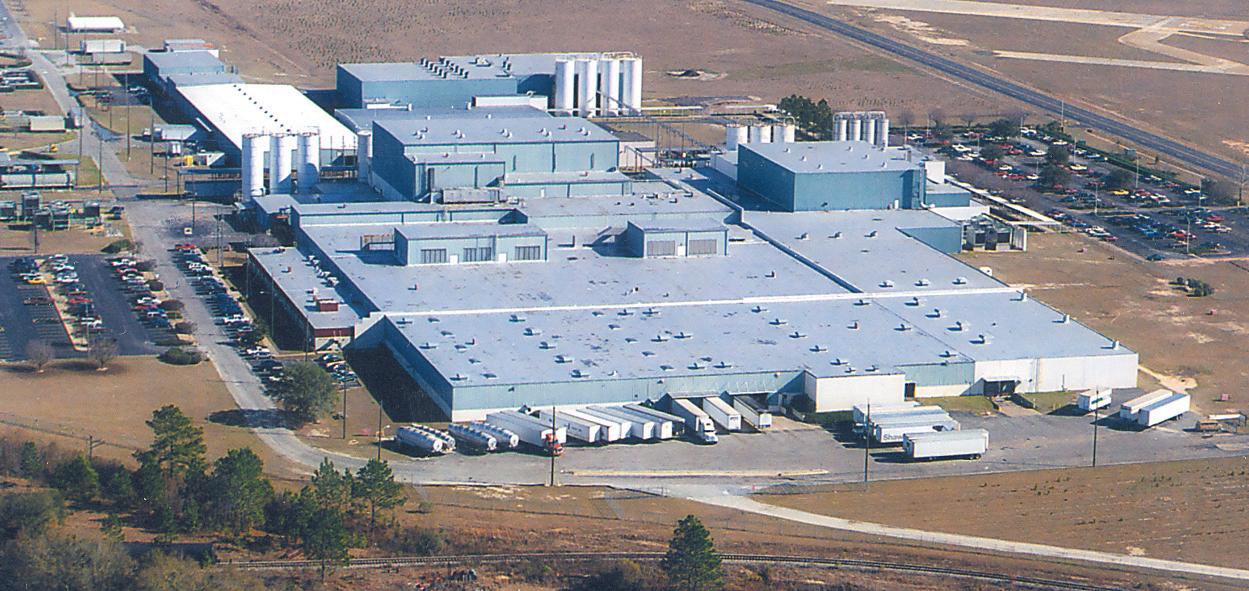

THE POST-SEARCHLIGHT 27 Bainbridge Filament Plants #70 and #86 200 Industrial Blvd. - Bainbridge, Georgia 39817 Shaw values diversity & inclusion. We are an Afrmative Action and Equal Opportunity Employer. BAINBRIDGE-DECATUR COUNTY INDUSTRIAL PARK 229-243-7789
Disasters change the course of Decatur County’s long-standing landscape
What a way for a year to start!
Right at the beginning, January 22, 1925, a flood came down the Flint River that ended up setting records that lasted for several decades. This flood did not start out to be devastating to all of the towns along the Flint River, it just evolved into a monster somewhere along the way.
When the Flood of 1925 hit the city, there was untold damage everywhere.

To begin with, it had been raining for days. The river was rising and gaining in force as it made its way down towards Bainbridge. No one knew for sure how high the river would rise or when it would reach its crest.
The only way that residents could get an idea of what was going on was from
getting updates on what was happening up river that were provided by those who came down and told them. When the water began to rise at an alarming rate, people began to make the move to higher ground.
The Flint River usually has a sweet temper, but when excessive rains come, it becomes a raging torrent. This will give you some idea of the strength of the current that is now racing to our town. The people had been moving to higher ground now for several days. They would move out and go up, to a place that in the past was safe. Then, the flood waters would rise and this would force them to go ever further away. By now, most had lost all they had, except what they could carry.
This must have been hard for them. This was January and there was cold weather. People were struggling to move their household goods, one piece at a time into row boats and then paddle on cold water to an unknown destination. Then, before they could get half of their belongings to higher ground, the flood waters would sweep in and cut them off again.
Those in government thought that there would be no shortage of food for the flood victims, unless the railroad tracks became submerged. If that happens, the trains would be unable to reach Bainbridge with supplies. No one knew yet that the railroad tracks of the Gulf, Florida & Atlantic Railroad had already began washing out a mile or so away
BICENTENNIAL EDITION 28 DECATUR COUNTY DISASTERS
Submitted Photo
OVERTAKEN BY WATER: Photo of McDaniel Barber Shop during one of the floods.
from the Flint. A crew of men were working hard on this railroad line, trying to save it. Everyone knew that if it goes, the last means of residents communicating with the outside world would go to, leaving the only means of transportation out of the flood zone, a boat. Bainbridge did become cut off from the outside world. Taking any means available, residents tried to leave, but now there was nothing but wreck and ruin.
Meanwhile, the Flint River was still raging and it was reported to have risen even higher every day. Everyone prayed that it would soon crest. However, the river had rose another 18 inches during one night and had begun to undercut the banks where the Atlantic Coast Line Railroad passed over the water. Now, there was very little hope and a scared population began to search for shelter from the flood.
Another problem was that practically all of the industrial businesses in the city were located in West Bainbridge. They were becoming flooded at an alarming rate. Those that had not yet gone under were now in a most terrifying condition.
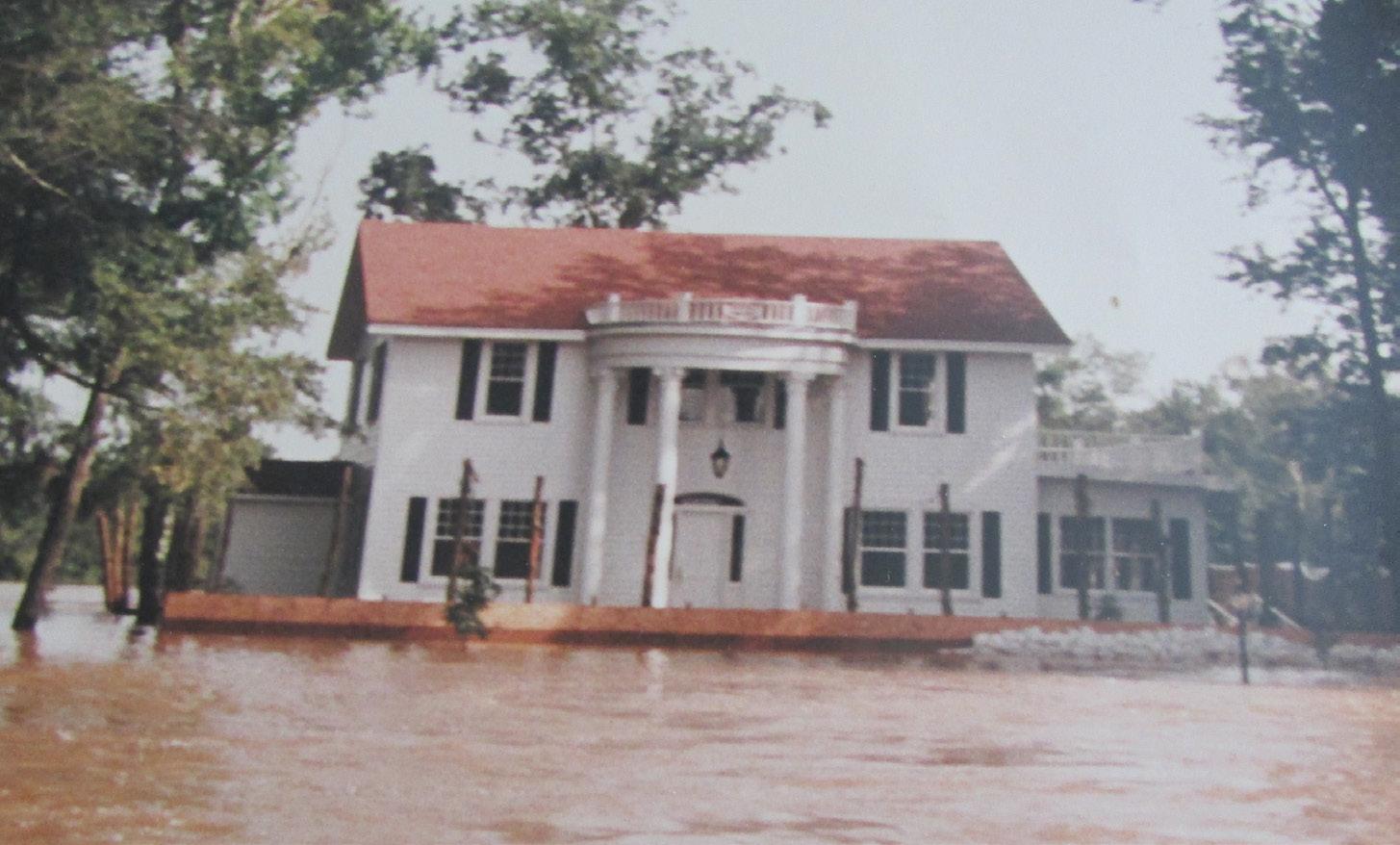
The Flint River now measured thirtytwo feet at Bainbridge. This lacked something like four feet from being up to what was known as the McKinley freshet which happened several years ago, in 1897. At that time, the Flint River registered 36 feet above the normal water pool.
Reports from damage kept coming in from various parts of Decatur County and others that surrounded Bainbridge. Many bridges all over southwest Georgia had been swept away. Locally, hundreds of people went over to the still standing County Bridge to see the raging waters, even though it was feared that the abutments on the west side of the structure would be swept away. Nearly every man, woman, and child in Bainbridge visited the river.
Then, the long-feared event happened. On Tuesday night, the 20th, the aging wooden bridge gave up the fight to the high waters which now swept away a part of the County Bridge. This calamity had long been expected. Citizens were scared and outraged, because it had been years since the last flood, and the city council had had plenty of time to prepare against such a tragedy. Now, the town had lost this most important bridge. Now, Bainbridge would suffer untold losses, from human to financial, because of this.
For three days, the rest of the bridge hung in the balance. Years ago, during other times of high water, it was held up by ropes tied to trees, but that was not done this time, and it probably would not have helped anyway. The water was much too strong and much too high. Then, on Tuesday night, the unthinkable happened. The rest of the bridge fell and the city was now cut in half. The headlines in the Post-Searchlight on Thursday, January 22nd read, “Highway Bridge out in Bainbridge – West Bainbridge under water.”
On Wednesday morning, the early
risers learned that now the west span of the highway bridge was gone, and a huge chunk of it had fallen down on the workmen. Still, the waters continued to rise, and the Flint River raged on. Next, came the reality that the flood water was now pouring into the factories, stores, and homes in West Bainbridge. It was unstoppable.
Then, on Saturday morning, the waters had turned a redder hue, and a oneinch rise during the night was reported. All day that Saturday, there seemed no changes. Then, late in the evening, the anxious watchers noticed a line of foam on trees. Folks began to hope and pray that the worst was over and that the river had stopped its upward rise. On Sunday, Bainbridge residents took time to thank God. On Monday, they took stock of the positives and the negatives. Positives were: no deaths, no hunger, and the weather had been mild, helping those that were exposed to the elements while moving from house to house on the west side.
However, unimaginable damage had occurred. The amount was terrific, and
THE POST-SEARCHLIGHT 29
DECATUR COUNTY DISASTERS
Submitted Photo
HEAD FOR HIGH GROUND: The current Chamber of Commerce was flooded all the way up to their front porch.
DECATUR COUNTY DISASTERS
no one had any idea as to what the cost would be until the waters had completely receded and the residents could look and see what was salvageable.
One pillar of the new railroad bridge for the Atlantic Coast Railroad that was near the cemetery, became undermined and two spans fell into the raging torrent. Practically every dwelling and store in West Bainbridge was invaded by the water. The Elberta Crate Co sustained severe damage, and the town’s gas station had been swept away. All the stores had been flooded, and in West Bainbridge, every home was under water. Devastation was everywhere.
As for the bridge, the county issued bonds, and all bridges were replaced by strong and sturdy iron ones. They were built to be high enough above the water that no conceivable flood could reach them.
In the past, the height of the flood waters had been marked on the stove chimney in the Callahan River Warehouse. Soon, what was up to this time, the high-water mark of 1912 (which was 35 feet) disappeared under the rushing flood waters of 1925(determined to be 41 feet).
Flood of 1994
In the hot days leading up to July 4th, 1994, everyone in southwest Georgia was keeping eyes and ears open, constantly checking the depth of the swollen Flint River. Unlike the Flood of 1925, the size of the area that was covered by the sprawling waters was known, and it was as big as Rhode Island and Massachusetts combined. This meant that along with Bainbridge - Americus, Macon, Albany and Newton were all in the cross hairs too.
The stage had been set for this unusually high water in June when over nine inches of rain fell. Now, Tropical Storm Alberto came on the scene. Meteorolo-
gists were describing its track as a freak occurrence. Alberto had traveled up from the Gulf of Mexico to Atlanta. Then suddenly, on July 3rd, it stopped and stalled over Georgia and Florida. Then, it began to relieve itself of its burden of heavy moisture in the form of torrential rains. Tropical Storm Alberto was now adding to the eminent problem, and the area along the Flint River, starting near Atlanta and then going down south into Lake Seminole at the Georgia - Florida border, would sustain the greatest devastation in the flood that followed. Bainbridge was in danger.
Then the muddy waters of the Flint River began to slip into homes, churches and businesses all along its route. Experts were offering their opinions, trying to predict what the up and coming days would bring. On Tuesday morning, July 5th, the Flint was at 17 feet above normal pool and by 2:30 pm, the depth had increased to over 20 feet, an increase of 3 feet in just a half a day. The National Weather Service predicted the river depth to rise up as high as 45 feet over the normal pool. A record river level at Bainbridge.
The television news media continued predicting a flood of Biblical proportions. However, if what they were talking about came true, this flood would earn the dubious distinction of being one of the worst to hit the southeastern United States.
By July 9th, Emergency Services were getting ready to be able to handle the impact of flood waters that still could be well at 45 feet or over. That is 103 feet above sea level! This exceeds the previous record level of 95 feet ASL by eight feet. Now, city engineers were getting ready for a possible 116 feet above sea level, eight feet above the previously predicted water level.
If this happened, these extraordinary water levels would invade areas that never
flooded before. Door to door notifications began in places that were believed to be threatened, for most of those living in the expanded flood area were below the 103 foot level.
Despite the rumors of higher water, the Mobile Office of the Corps. Of Engineers felt that the prediction of the National Weather Service (about the Flint River to be 45 feet above normal pool) was too high. Many engineers in Bainbridge felt that those who did not know our area as well as they did, had not taken into consideration the effects of the Big Slough/ Twin Lakes canal.
Every day, the residents of Bainbridge who lived on the northern tip of Lake Seminole, braced for the worst as the flood waters continued to rise. The National Weather Service predicted that the Flint River would crest at 45 feet sometime on Thursday, July 14th. At least a thousand residents evacuated the city on Wednesday, July 13th. Now, the streets were crowded with people moving their most valued possessions to higher ground. Some residents were going to the grocery stores, where bread and water were quickly disappearing.
North of the city, in the West Bainbridge area, precautions for the upcoming flood had also begun. Many employers set aside storage room for their workers. Truck and trailer rental agencies were swamped, and truck drivers in Bainbridge donated their time to haul families and furniture away from the flood waters. Bainbridge residents pulled together and helped each other. Some worked for days at shelters providing food, personal items, and safety to those who had already lost their homes.
The Post Searchlight helped residents by providing a list of shelters information on how to get medical assistance, numbers for emergency contacts, where to buy emergency items, how to be safe when dealing with electrical power, what
BICENTENNIAL EDITION 30
DECATUR COUNTY DISASTERS
roads were still open, and where volunteers were needed.
The anxiously awaited crest did begin on the 14th, with the depth of 37 feet above normal pool. However, the National Weather Service’s prediction remained at 45 feet with Big Slough and West Bainbridge to be affected the most. Fortunately, as was predicted by local engineers, the Big Slough area absorbed most of the flood waters keeping the river at a lower level.
More good news for Bainbridge residents came when more heavy rains were not expected, and flooding in the higher elevations was also not expected. The scattered thunder showers that did happen on the next several days produced only normal flash flooding. However, this went practically unnoticed in an area where there was already such devastation.
One place that could have caused a huge problem was the ammonia storage tank at Vigaro’s fertilizer plant. If it leaked, the river water would mix with the ammonia. However, this would not cause it to explode. Also, rising water splashing against the tank would not cause it to rupture. The biggest threat would be the noxious fumes. Therefore, National Guardsmen filled sandbags and built an earthen berm around the tank. If worse came to worse, evacuation of a 20 mile radius would be necessary. Thankfully, nothing happened.
Finally, on late Thursday, July 14th, the Flint River crested at 37.2 feet and now began a quick decline. Bainbridge breathed a sigh of relief. Now, the flood waters came down towards the Woodruff Dam, and it had water going over the cement wall and through its gates at an enormous rate. However, this area is so large that the water had room to spread out and did not go over 90 feet above sea level.
Now that the crest had come, by the
next morning, the river had fallen to 30 feet. Many of the evacuated areas were now seeing residents return home even though many streets like Newton Road, Spring Creek Road and Ten Mile Still Road were closed, as well as many city streets. However, at first, permission had to be obtained, and the curfew that was imposed during the flood continued.
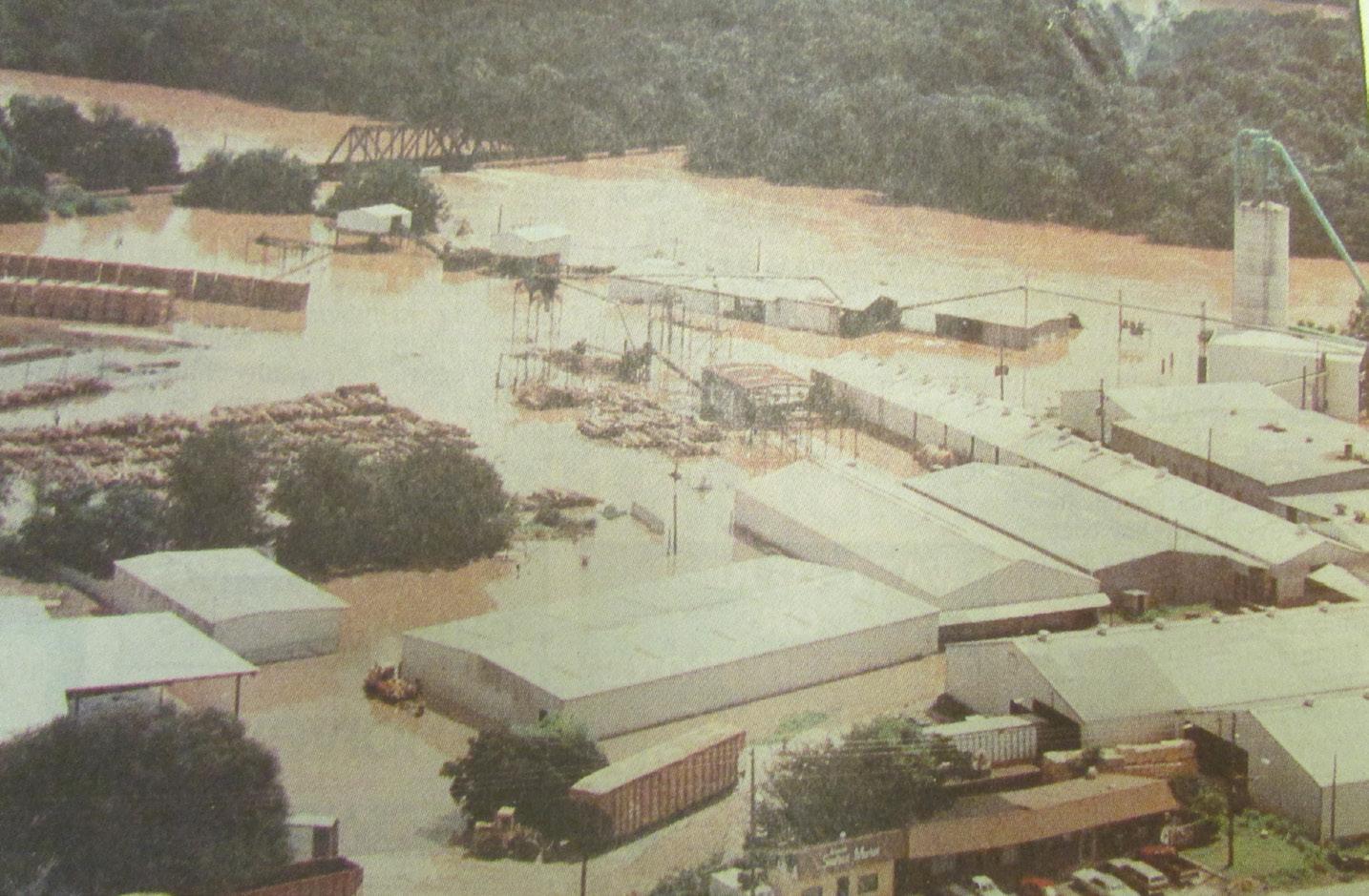
On the West side, folks were shuttled to their homes, but this was not a very happy occasion ,for they were greeted by the unmistakable smell of rot. They were stunned to see the ruined swimming pools and lawns, broken fences and decks and docks in pieces, carried away, victims of the river. Some homes needed major structural work, while others needed a good scrubbing.
On the east side, standing pools of putrid water remained in yards while an unhealthy layer of sand covered the grass, choking it out. Fallen and mangled trees were helping to protect the scoured river banks. The Red Cross estimated that 158 homes were damaged in and around
Bainbridge.
The flood waters also brought with them hidden dangers like leeches and mosquitos that transmit encephalitis, poisonous snakes and other wild animal like rats and raccoons that have been displaced by the water. Septic tanks become problem sinkholes. There also was food and water contamination to deal with.
Home owners had begun scheduling inspections to be sure that their dwellings were safe. These included checking for structural damage, water contamination, electrical and dangerous animals.
Over at Oak City Cemetery, relatives had placed sand bags on about thirty graves. These were also found in other cemeteries near flood zones. Relatives feared that the strong current on the river would uncover caskets like had happened in the 1925 flood. Fortunately, no gravesites in Oak City Cemetery were threatened.
Most heavily damaged was the city park from Cheney-Griffin down to the Earle May Boat Basin. This landscape
THE POST-SEARCHLIGHT 31
Submitted Photo
UNTOLD DAMAGE: Elberta Crate sustained severe damage during the floods. Devastation was everywhere.
DECATUR COUNTY DISASTERS
was barely recognizable. The road between the parks looked like a dump site. Part of the old train that was in the park was barely hanging on, as it teetered on a broken track.
As flood waters dissipated, Georgians were working at recovering from one of the worst floods in American history. The destruction caused in our state by the Flood of 1994, had been compared to the destruction of Sherman’s fiery march to the sea.
August brought us a scare when Tropical Storm Beryl came our way. However, our prayers were answered when only four and a half inches of rain fell in Bainbridge. The only obvious damage was brought about by strong wind gusts that knocked down tree limbs.
However, the surprises brought about by the flood were not over yet. There was a startling discovery when the water was receding of two human skeletons, about ten feet apart, partially exposed and nearly complete. Erosion had caused a wash out by a collapsed picnic shelter, along the roadway between Cheney –Griffin Park and Earle May Boat Basin. These skeletons of unknown age and origin, and seemed to be decades old, were discovered by a sheriff’s deputy and an amateur archeologist who were searching for artifacts in a place that once was a camp site.
In another gully farther down, numerous bone fragments, both human and canine, were found. Unsure of how old these bones were, the sheriff’s department contacted the coroner. Soon, they realized that these were probably not victims of recent crimes. The site was cordoned off so no one would disturb the remains.
A team of forensic specialists from the Florida Department of Law Enforcement and the Anthropology Department at Florida State University arrived the next
morning to examine the bones and determine their age. At this time, Georgia’s specialists were busy up river trying to identify more recent remains that the flood waters had caused by dislodging coffins from cemeteries. These were now floating through the city streets of Albany.
The scientists carefully excavated the park site and took pictures. Dirt from around the bones was put through a sifter to capture fragments and artifacts. Because of the condition of the bones and the depth at which they were found, it was guessed that they might date back to the 19th century or earlier.
Officers also found a 19th century bullet that had apparently hit something. It was not yet known if it was a body. When investigated, it was found that the bullet definitely came from the 19th century, was fired, and impacted an object.
Other artifacts turned up by the flood were numerous relics, arrowheads, and antique appliances. This area was well known to archeologists and artifact collectors because whenever heavy rains occurred, such items appeared. However, it took the Flood of the Century to turn up the skeletons.
Eventually, the Georgia Bureau of Investigation and anthropologists from the University of Georgia determined the skeletons to be male. However, they could not be certain of their race without having a complete skeleton. However, they could tell that they were not Indians. One man was 25-40 years old, the other 30-50 years old. Also, the actual time in which they lived could not be determined but they were definitely historical. The men were reinterred as unidentified persons. Despite many hardships and heartaches, Georgians continue to show courage, persevere, and improve beyond their prior state. Though such disasters, they have rebuilt and joined together as one,helping each other as family.
Epic fires
Bainbridge has suffered several large fires in her past, mostly around the late 1800s to early 1900s. At this time, fire was a main concern for our community, because so many buildings and houses were made of wood and the fact that there was a lack of readily available water to fight the fires.
Starting with the history of our fire departments, Stonewall Fire Engine Company No. 1 was incorporated and chartered on May 27, 1868. Its main purpose was to protect the property which was located in Bainbridge from fire.
Another fire department was the Oak City Hook and Ladder Company, which was in existence in 1870 and incorporated before 1875. In a book which contained the minutes of one of their early meetings, the type of uniform that they wore was described. It consisted of dark blue, flannel shirts with sailor collars, trimmed with two rows of narrow red braid. This same braid was also used around the cuffs. Buttons were white pearl and the size of a five-cent piece. Officer’s shirts were to be the same as privates. Also, they had caps that were made of red leather, with a blue band. On the front was the company’s name, printed in red letters on a white shield. Officers also had badges with the engraved insignia of their office and “OCH & L. Co. of Bainbridge, Ga.” on a silver shield.
In 1892, the Oak City Hook and Ladder Co. had 40 men and the Stonewall Engine Company also had 40. The newly formed Morgan Engine Company had 50 men. All three fire departments were trained and ready to keep the city of Bainbridge safe. However, with cisterns the only water source, getting enough water on to the fires was the main problem.
The first fire on record took place in a boarding house, which was a large, two-
BICENTENNIAL EDITION 32
story building at the northwest corner of Water and West Streets. This occurred on April 8, 1871. Along with the boarding house, a small dwelling on the north side also burned. Farther down, and to the north, there was another house that was used as a school and also as the Episcopal Church that was destroyed by this same fire. Four buildings burned that day. The main problem was not being able to have access to enough water.
A small fire was reported in the “Southern Spy” newspaper on March 2, 1872. This time a building containing three stores on the southeast corner of Broad and Water Streets burned down. The day was September 24th, and the year 1874. This was one of the largest fires in Bainbridge. The building that was destroyed was the original Presbyterian Church.
The church burned along with stores and stables that were on both sides of
West Street, from Troupe to Broughton Streets. Then, on down Broughton, one third of the buildings facing the square were also lost. All in all, this fire which began in a stable in downtown, destroyed the Presbyterian Church and thirteen other downtown businesses.

An article that was in the “Bainbridge Democrat” described the fire as the saddest loss for Bainbridge. The old Presbyterian Church was a commanding structure, with its deep-toned bell that everyone loved to hear calling them to the church services. However, this bell also served as the regular fire alarm. When it rang that last alarm on September 24th, the belfry was on fire. In a way, it rang its own death knell.
After the fire, the Presbyterian Church was rebuilt on northeast corner of Broad and Evans. It was a wooden structure painted grey with white trim, plus a painted steeple which eventually had to
be removed because it kept getting hit by lightning. The east and west sides had five windows each. The building also featured Gothic arches at the top of the windows. Their glass was red, blue, and gold, except for the middle pane which was made of embossed white glass. This church was dismantled in 1899, and the present building was built on the corner of Shotwell and Broad Streets.
Today all that remains of the first Presbyterian Church building are three valuable objects – silver communion chalice, the pulpit Bible saved from the fire in 1874, and the minutes of the meetings of the churches’ ruling body.
The next most destructive fire took place on July 14, 1887. This one almost destroyed the whole north side of the square. The fire started at around 4 pm and originated at the rear of the old, wooden livery stable, situated near the Sharon House which was owned then by
THE POST-SEARCHLIGHT 33 DECATUR COUNTY DISASTERS
Submitted Photo
HERE TO HELP: Pictured above is the Hook and Ladder Fire Brigade of 1867.
DECATUR COUNTY DISASTERS
Captain J. S. Desverges.
It was first discovered by some boys who were playing in the yard by the hotel. Next, about five seconds later, a news writer for the “Bainbridge Democrat”, saw the flames just beginning to come through the roof. In a few moments, the fire alarm sounded and every man rushed to the scene. It was amazing how fast the flames went from rear to front. The intensity of heat became terrific and quickly was intolerable. Doors, shutters, windows and blinds were used by the hose men so they could bring water in as close as they could. Hook and Ladder men covered nearby buildings by bringing water in buckets. However, now eleven other buildings were on fire, mostly from sparks from burning shingles that were sent up in the air from the roof of the stable.
Axe men pulled and cut away at the connecting buildings and fences. Forty brave men manned the pumps of the Stonewall Fire Engine and sent a steady stream of water into the intersection of Broad and Water Streets. For a half hour the fight against the fire was fierce. Men took turns to keep water constantly going until the flames were beaten down. When the fire was out, the men were greeted by shouts of triumph from the crowd that had gathered.
The next fire occurred on April 26th, 1888. It was a Sunday afternoon, at about 4 pm when a home, in the east part of town that was owned by Caroline Donelson, was suddenly – gone. It only took a few moments for this large house to succumb to fire.
When it was first discovered, it could have been extinguished had there been a ladder to reach the roof of the adjoining stove room, which was in the L part of the house. However, the roof was dry, and a brisk breeze, which fanned the flames,
was no help. The fire soon spread. The alarm brought both the Stonewall and Oak City fire departments to the house. Even though they were only a half a mile away, nothing could be done. The firemen then focused on saving the out buildings and the adjacent house of Mr. H. Nussbaum. This was done by throwing buckets of water on the flames and applying wet blankets. What did not help was that there was a lack of water.
Neighbors joined in, and with all of this help, most of the furniture and house hold effects were removed. The source of the fire was determined to be a defective stove flue.
Another destructive house fire occurred on October 18, 1888. This was when the J. D. Dollar home burned down. It happened when Mr. Dollar returned home and found that his family had gone out to visit his wife’s father, which was a half a mile away. This is when he built a small fire in the fireplace and left to go to his father in-law’s. It was
just less than an hour afterwards that the house and its entire contents were consumed by fire. The light from the flames attracted the attention of Mr. Dollar, who arrived home in time to save a few kitchen furnishings. All and all, it was a heavy loss.
Sunday, on August 29th, 1889, at 1:00 a.m. the fire bell was heard along with the thundering hooves of horses and mules and the screams of the fire trucks. The Bainbridge sky, lit up by fire, resembled daylight. It didn’t take long for almost the whole town to wake up and be on the alert. The cause of these flames came from the home of W. C. Jones, whose two-year-old house was opposite the Methodist Church.
Fire blazed all over the structure as flames were licking at its walls. Inside were five little children, Mr. Jones, and his niece, Ms. McLauchlin. All were sleeping on the second floor. No one in the Jones’ house knew it was on fire until a neighbor from next door came and woke them up.
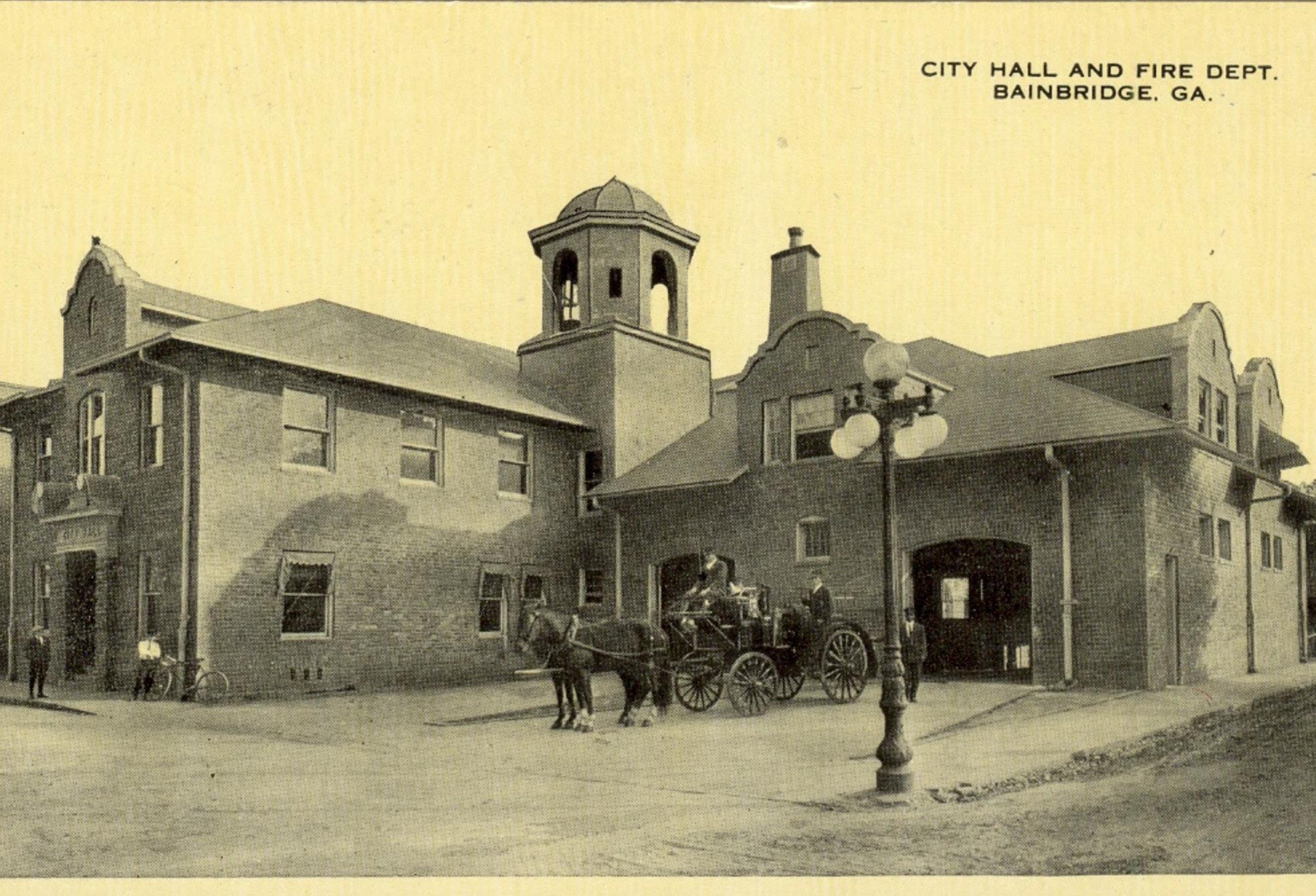
BICENTENNIAL EDITION 34
Submitted Photo
ONTHEWAYTOSAVETHEDAY: The fire department and City Hall were formerly housed at what became the Fire-houseArts Center.
DECATUR COUNTY DISASTERS
The fire seemed to have started in the stove room on the outside of the house, under the kitchen which was attached to the main building by a short platform. The stove room, set on the north side of the house, and the kitchen had been vacant since Saturday at 2 pm.
With a stiff breeze blowing towards the south and the fire having plenty of fuel, the fire to spread rapidly. Danger was so great, that everyone had to evacuate immediately. Mr. Jones grabbed the children and his niece, who had a narrow escape from suffocation. No one had time to change and came out in their night clothes with only one outer garment thrown over their shoulders.
For a short time, the flames endangered all of the adjacent buildings. There was a constant train of water buckets to save the residence of Mr. John O’Donnell next door. Fortunately, a hard rain began to fall around 9 am. That thoroughly wet down the shingles and calmed the flames.
Ms. McLauchlin managed to save one trunk which contained valuable papers. However, all clothing and jewels were lost. All the silver, china, and glassware was destroyed. A few pieces of furniture were also saved, but a treasured piano was not. However, most importantly, no one was hurt.
Finally, to conclude historical accounts of fire devastations, the great city wall was destroyed by fire on Sept 24,1925. This happened on a Friday night when the city was threatened not only with the burning of the city offices, but for a time, it looked like the fire would spread into other sections of downtown as well. However, the evening was calm and this danger was averted. If there was any type of wind, the entire block would have been destroyed. Unfortunately, the stores that were above city hall did not escape and were burned, and the water that was used to put out the fire damaged the library. It
was thought that the fire started in a wire connection that also served the fire department, which was in the same building. The insurance company started work immediately. Meanwhile, the library, city offices, and the fire department had temporary quarters.
Snow
Throughout history Decatur County has experienced extreme temperatures ranging from a low of -17 degrees, which was recorded on January 27, 1940, to a high of 113 degrees which was recorded on May 17, 1978.
Here in Southwest Georgia, snow is typically found along the side of the road and is caused by cotton blowing out of those big wagons that are transporting the white, fluffy stuff. However, despite her Deep South roots, Decatur County does not escape the wrath of winter all of the time. Available records reveal that in February and March, 1835, in Bainbridge, there were several snows, the heaviest being 8 inches deep. Similar snows followed in 1854, 1885, 1945, 1946, 1947 and on into more modern times.
Research reports show that one of our first major snows was on on February 20, 1899. It told of a typical family that lived in a log house which had a fireplace constructed with a stick and dirt chimney.
Naturally, it being cold weather, they had a glowing fire in the fireplace. However, during the night the snowflakes began to fall, which gradually became much heavier and much thicker. Later, that snow began falling very hard. As the wind picked up and blew with very strong gusts, the snow started coming down the chimney and through the cracks in the house. The situation became so intense that the Daddy had to put out the fire. He then took the oil cloth off the kitchen table and covered the chimney to
keep the snow out.
Meanwhile, the Momma put the children to bed and stacked all the quilts and bed covers the family owned on top of them. As she did this, she stuffed newspapers between the covers for this made a great insulator. This made the covers very heavy, making it difficult to role over.
When the family awoke the next morning, the snow was piled in drifts in their yard that were three to four feet deep. Sadly, most of their farm animals, including calves, sheep, goats, hogs, chickens and ducks were found lying in the snow, frozen.
The snowfall of 1899, brought about some other stories that were passed on by word of mouth by the older residents of the day. One recalled how Dr. Waddell, a pharmacist whose business was located on Water Street, took the wheels off his carriage and rode the children around town.
A more modern snowfall of measure occurred on February 12, 1958. Bainbridge and all of southwest Georgia became an overnight winter wonderland during this stormy night. The white stuff started to come down on Wednesday at 7:10 pm as a mixture of sleet and light snow flakes. As the night went on, the flakes grew heavier and wetter, begging around 9:00 pm, and maintaining a steady pace until 2:30 am on Thursday. The storm resulted in an accumulation of 2 inches.
When the residents awoke that morning, they were in awe at what they saw. Some said it was a, “rapture of whiteness such as the majority of the citizens had never seen before”.
Children, as well as their parents, rushed outside into the snowy yards and within seconds were building snowmen or throwing snowballs. Others were walking all around and were snapping pictures of this unusual site. At noon on
THE POST-SEARCHLIGHT 35
DECATUR COUNTY DISASTERS
Friday, it was still so cold that in spite of the brilliant sun that had been shining all morning, snow could still be seen in many areas. This added immensely to the beauty of the Christmas card-like midwinter scene, but did not warm your feet.
The next significant snowfall occurred on Fri, Feb 9th, 1973. It began after midnight and continued to around 11 am on Saturday. This storm brought an accumulation of 9 inches. Residents became excited and everyone was in a festive mood. At Jake’s Pawn Shop, there was an ample supply of snow boots, because he had ordered them during the snow storm of 1958. Those that did not sell were put in storage. Now, these sold quickly to thankful customers.
A couple of families were the envy of the town since they had sleds. However, many were very inventive and slid down the snow-covered banks over at the by-pass on pieces of card board. Perhaps, parents had the best time, because they were free to act like kids again.
The prize for the “Most Beautiful Show in the Snow”, went to the broad-leafed magnolia trees which put on a most stunning display with their shiny, brilliant, dark green leaves against the background of white. Someone documented this in their diary: At 8:15, Saturday morning, two sparrows were spotted walking across Willis Park into the shrubbery, their heads were bobbing and their short legs straining for speed. Their expressions seemed to say that they wanted to know who, exactly, was responsible for this condition!
There were so many snow men that you could not even count them. Of course, everyone was claiming that theirs was the biggest. Snow fights were also popular as they were taking place throughout the town. Local gas stations turned out to be the most popular locations for these to take place.
An even more modern snow storm occurred in 1993, known as the Great Blizzard of 93. It hit the southeast, then went up the entire eastern seaboard dragging with it, record breaking low temperatures, snow, and howling, hurricane force winds. Some places called it the “Storm of the Century” and others called it The Superstorm. There is even a movie about it called: “The Perfect Storm”.
This Great Blizzard began in the mountains of New York and New England, early in the morning on March 12. It then picked up intensity as it moved down through the Mid-Atlantic States and took its frustrations out on Washington DC. It buried the North Carolina Mountains in an unheard of 50 to 60 inches of snow and ice before moving into Georgia and putting Atlanta in the cross hairs. Television weather forecasters, who predicted flurries and light accumulations had to eat crow, when an official 10 inches fell over this city, making it look like a giant,
cold marshmallow from outer space.
Panicked shoppers stripped supermarket shelves of milk and bread. The city’s hilly streets were like a car ride at the county fair, as drivers with no chains or snow tires hydroplaned and collided with each other in the snow, then advancing to sliding on black ice.
Travelers on the snowbound Interstate 75, between Atlanta and Chattanooga, Tennessee, abandoned their cars and took refuge, some for nearly a week in motels, churches, schools, and also relied upon the kindness of strangers.
Atlanta and other Southern cities where average, mid-March temperatures are in the 50s and 60s, and once or twice a year, snow falls of an inch or less make for a brief day off, became paralyzed by a foot deep snowfall accompanied by Artic cold.
Southward, the storm continued on and went to dusting Macon, Augusta, Valdosta, Savannah’s picturesque squares and fountains, as well as the gators in

BICENTENNIAL EDITION 36
Submitted Photo
A RARE SNOWFALL: Joyce Kramer captured a picture of the snowfall at her house and at Lake Seminole during the few instances of snow.
DECATUR COUNTY DISASTERS

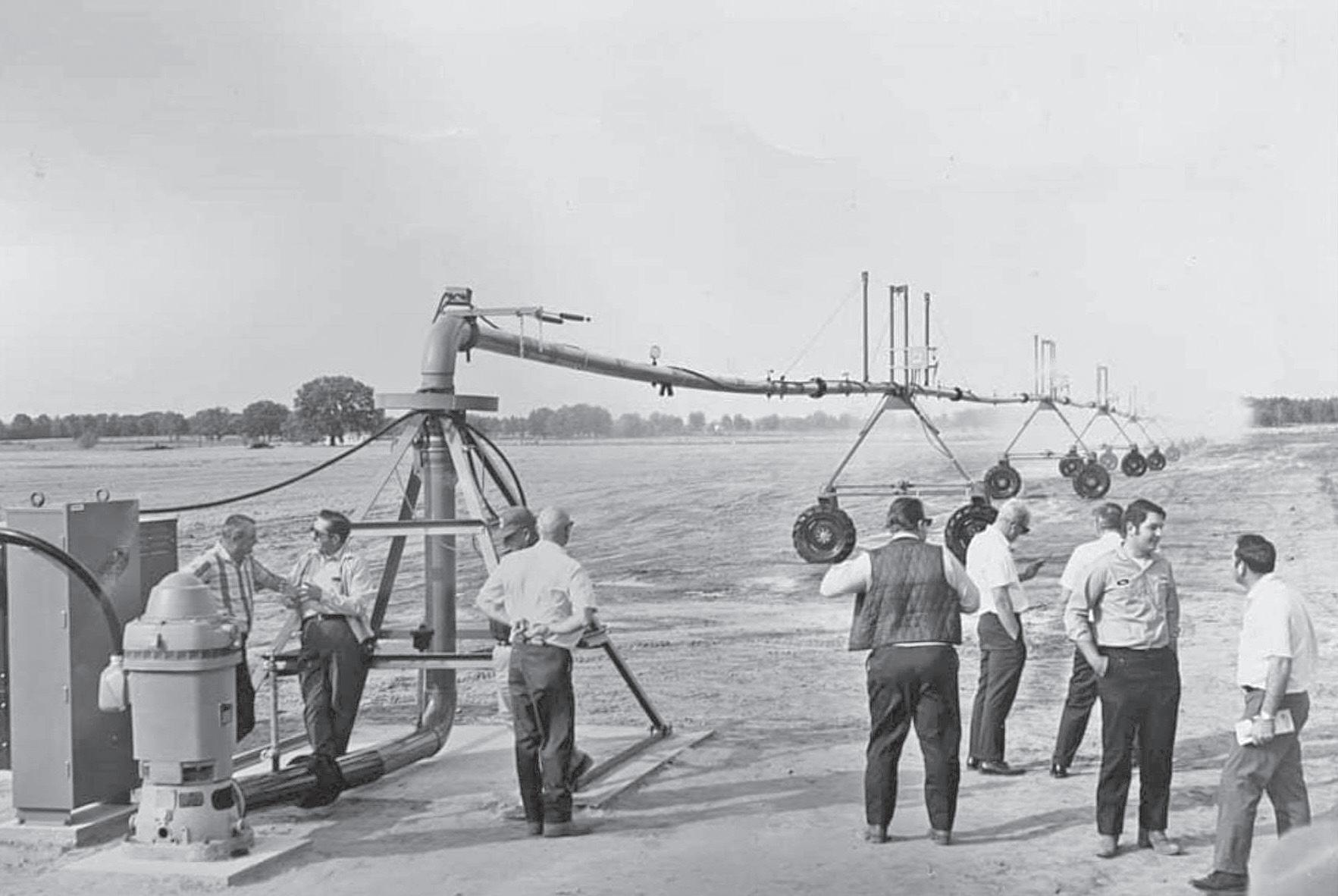
Okefenokee. In Bainbridge, dogwoods and azaleas, and camellias, seduced into bloom by balmy spring like temperatures before the storm, were cruelly ambushed. They became crusted with a light dusting of snow which was enough to hurt the blooms. Those who had left their sprinklers on during the night found that they had created a wondrous waterfall. The accumulation of an inch was enough to cause havoc on the roads for drivers unaccustomed to driving in this type of weather.
Even though Bainbridge had its share of the blizzard, luckily it was nothing compared to what some others received. And, when the storm blew itself out, refugees came out of hiding and swapped their war stories.


THE POST-SEARCHLIGHT 37
Submitted Photo
FROSTY THE SNOWMAN: Joyce Kramer captured a picture of the snowmen her children built during the same rare snowfall.





BICENTENNIAL EDITION 38




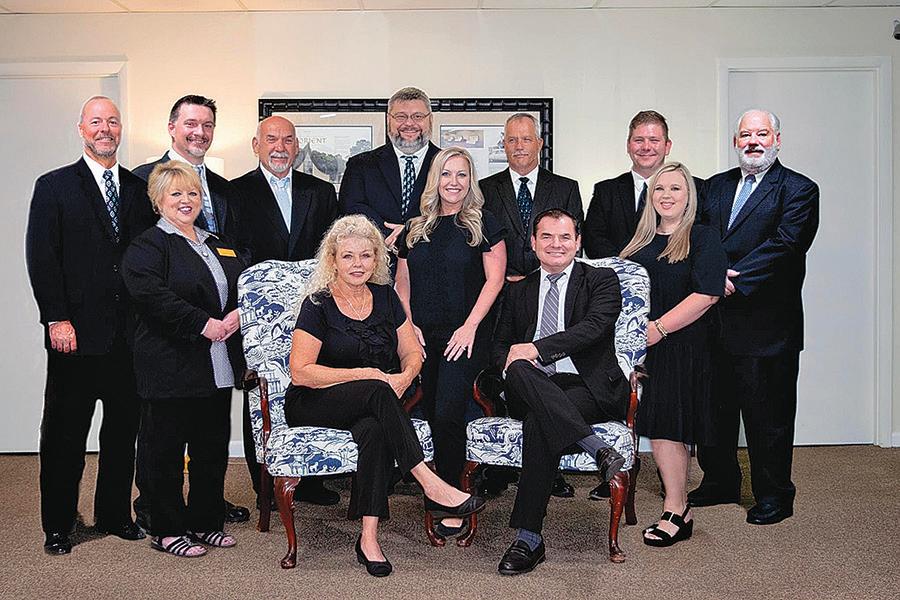
THE POST-SEARCHLIGHT 39
Steamboats pick up speed as mode of transporting goods and services
The Alligator Stage Line, which was the first to come to what is now Decatur County, started out as the Brunswick and Florida Stage Line. When it was bought out by another group of businessmen, they changed the name to the “Alligator Stage Line”, a name that was chosen not because of the animal that is our “pet”, but because this route was an amphibious one. Like the alligator, it traveled over land and water, making use of the steamboats and coaches.
The Alligator Stage Line worked closely with several steamboats. The “Champion” and the “Kingston”, which came out of Mobile, Alabama, were two very popular boats. Also, the steamboats, “Rebecca Everingham”, the “Newton”, the “G. Gumby Jordan” and the “John W.
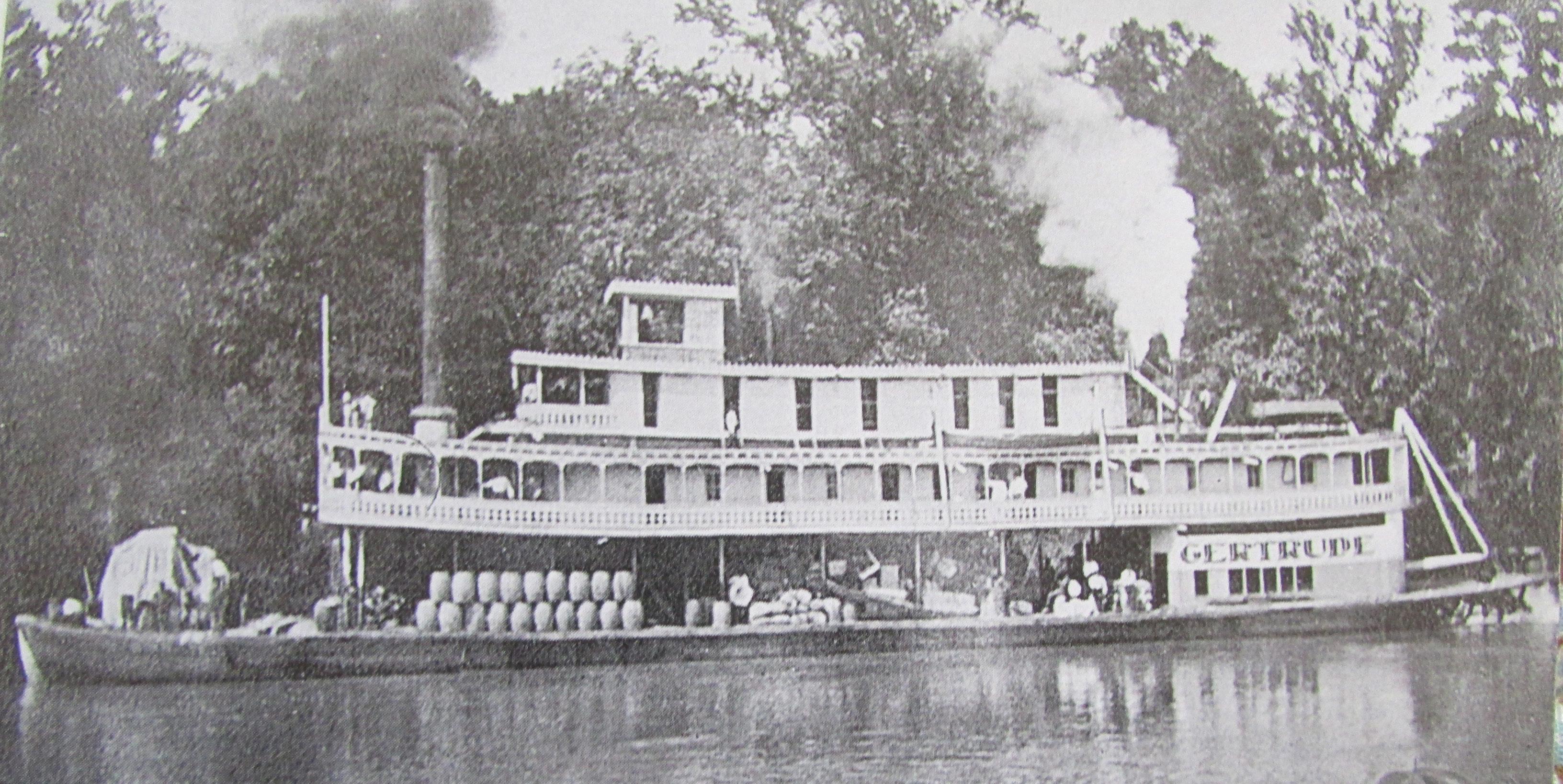
Callahan”, were just a few that dropped off and picked up passengers, mail, and cargo at Bainbridge. Bainbridge was a very popular destination, with so many steamboats stopping there since 1821. The wharves were constantly loaded with bales of cotton and other cargo, as well as passengers. In 1843, Bainbridge acquired a mail route, which was a big boost in business for the Alligator Stage Line.
The average coach was drawn by four horses, and could carry sixteen passengers while traveling ten miles every hour. At this time, it was mandatory that the horses be changed. The average coach fare was ten cents per mile.
A typical schedule from 1887 found in one of the old newspapers tells of the routes of some of the stages that came
and went at Bainbridge. For instance, you could travel from Tallahassee, Florida, by way of Quincy, Florida, and come into Bainbridge three times a week. To do this, you would start out in a four horse - drawn stage and continue on up to the area. Another sample of transportation available from Bainbridge was the opportunity to go to La Grange, Georgia, three times a week in a two horse - drawn stage. Additionally, a two horse - drawn stage would travel from Bainbridge to Pensacola, Florida, three times a week.
In 1851, the Alligator Stage Line advertised a coach that left Oglethorpe, Georgia every day except Sunday. This stage went through Bainbridge on Mondays, Wednesdays, and Fridays. At Bainbridge, it would take on and drop off passengers,
BICENTENNIAL EDITION 40
COUNTY
DECATUR
TRANSPORTATION
Submitted Photo
FLOATING DOWN THE RIVER: The Gertrude makes it way down the river carrying goods for the masses.
DECATUR COUNTY TRANSPORTATION
then proceed to Thomasville. Not only important to southwest Georgia, the Alligator Stage Line also represented hope for the people of Port St. Joe, Florida. According to newspaper accounts at the time, the city boasted about the great prospects of success, as the population size grew in hopes to exceed that of Apalachicola, Florida.
A typical Alligator Stage Line schedule for this area showed that it left Port St. Joe for Mobile, Alabama, every Sunday, Tuesday, and Friday at 6 pm. If you were traveling from Port St. Joe to Greensboro, South Carolina, that stage left at 1 pm, every Sunday, Tuesday and Friday. Every Monday, Wednesday, and Saturday, you could travel to Apalachicola from Port St. Joe by leaving at 8 am.
Here is a sample of a travel itinerary from 1840. As you will see, it is quite a grueling schedule. This will take you from Mobile to Charleston. First, you traveled by steam packet, (a small steamboat) from Mobile to Port St. Joe, a distance of 200 miles. Then, you went from Port St. Joe to Iola, Florida, by railroad, a distance of 30 miles. Now, leaving from Iola, you would go to Bainbridge via steamboat for 100 miles. You would then leave Bainbridge and go to Greensboro by mail coach, changing routes and horses many times along the way. This was a distance of 213 miles. Finally, you would go from Greensboro to Charleston by railroad, 210 miles.
Despite the fact that some of these stretches were long and very hard to travel, the Alligator Stage Line gained in popularity and in public confidence. It pretty much stayed on schedule, as much as anything in those days could. It became a very popular way to travel up to the north and out to the east from our area. The stage line boasted that the stations were kept up in a way to give general satisfaction to the public. They
also stated that the roads were better than any of the other roads at this time.
A newspaper article from 1842 stated that, “the Alligator was running smoothly having made recent improvements such as new coaches, horses, and drivers. This rendered traveling upon the stage line exceedingly comfortable”. They also bragged that the coaches were neat and clean. “No expense was too much to have the travelers happy”.
When it came to accommodations along the way, they said that, “theirs were not surpassed by any others, even better than many places that were offered by other stage lines in the whole United States.”
However, despite all of the advertisements, stage travel was considered rough and tough. Most stages were small and drawn by two horses. Most accommodations were very poor. One letter in a newspaper told of a hotel that had window frames but no glass in them.
Note that stage travel did not consist of a conveyance that had springs or shocks to make the ride go easier over bumps. Nor was there air conditioning to cool the coach in the stifling heat. Try to imagine being in a wooden box, in the woods, surrounded by foliage and insects and no way to get the air to circulate. An unwelcomed stench - people did not bathe that often- fills the air.
The dirt roads of this era were not kept up like those of current day. Some were monotonous. Most were covered with potholes you could lose a cow in. The dirt was slimy and muddy when it rained and dusty all of the other times. Sometimes, they were covered with thick grass and underbrush. So much so, that they had to be cleared before the stage could continue on. In another article, it stated that the roads the stage traveled were so poor in some parts that they could not raise sufficient fodder to feed the horses. Also,
they had to contend with the Indians and highwaymen. Despite these rough conditions, the old stagecoach roads covered a lot of territory. Some of them had lots of unknown hazards, but others had places with some beautiful scenery.
For instance, on the old coach road that led from Albany, Georgia, to Tallahassee, after traveling four miles south, the trail crossed over the Flint River, and you would find yourself passing a most beautiful place called Blue Springs, now known as Radium Springs. Here, the coach would stop and get fresh horses, either two or four, depending on the coach.
After leaving Dougherty County, the trail crossed the northwest corner of Mitchell County and followed the beautiful Flint River. Today, this road is called the Old Albany Road.
About twelve miles north of Bainbridge, there once stood the Pryor place. Dr. Pryor was the local postmaster. The stage paused here daily to deliver mail and spread the gossip. The doctor’s daughter Ida, who married A. B. Cliett, a resident of Bainbridge, remembered the stagecoach days and shared many interesting recollections. Rocking on her front porch, she stated:
“Three quarters of a mile below my home stands a lone pine tree at Mule Bottom. A stage coach on the trail passed so close to that tree that once a man, looking out of the window, was instantly killed as his head hit the pine tree when the stage passed.”
Ida continued with her story, telling her listeners that one mile north of Bainbridge, if you look to the right, you would see an avenue of trees. These led to the home of Samuel Davis Tonge, owner of the Tonge Cotton Mills. During the War Between the States, they were the best cotton mills of the 1860s, as they provided many uniforms for the Confederate soldiers, benefiting the county greatly.
THE POST-SEARCHLIGHT 41
DECATUR COUNTY TRANSPORTATION
The old stage coach trail would cross at the ACL passenger depot, then sweeping from northwest to southwest, it went through a residential and business section, until it reached the corner of Shotwell and West Streets. This was just behind the Callahan Hotel, where the old Singleton Stables were located. Here, a change of horses took place before the stage coach went on.
On the corner of Shotwell and West Streets, looking north, stood the home of Captain Charles G. Campbell, who in July of 1850, organized the first military company. This company camped on the banks of the Flint River, northeast of Oak City Cemetery. While the Captain and Mrs. Campbell lived there, they entertained with a military banquet - talked about by old time residents for a long time, and described as a “brilliant affair”. Years later, this home was moved back to make room for the brick home of T. C. Wainman, owner of the Wainman Hotel.
More previously existing stage depots in downtown Bainbridge are noted in a record written on April 16, 1858, which states that the Alligator Stage Line stopped at the Hibberd Hotel and Stage Depot, at the corner of Water Street and Crawford Street. Another popular stop on the north side of the square included the Sharon House, where breakfast and supper were considered to be very tasty.
Now, following the SAL railroad you would reach the intersection at the crossing on West College Street. This street was laid out by Captain Campbell while he was serving as mayor of Bainbridge. It was named in honor of the ruins of a female college that was started by the Methodist Conference, but failed to reach completion due to the outbreak of the War Between the States.
Setting far back from the street is another old home of Captain Campbell’s. This became the Willis Russell home. The
western boundary of the old stagecoach road lay behind a hedge at the back of the home. It then continued through the field at the rear and ran into the Bainbridge - Quincy Road, which paralleled what is now Faceville Highway (State Route 97). Nine miles down this road, you came to the antebellum estates of the Kensingtons and the Munnerlyns, known as the “Refuge”. Both have been destroyed by fire. Just a mile south, there was a stable with fresh horses available. Others contend that the Wright (Griffin) house, located a little north of the “Refuge”, was also a station. However, many long-time, local residents agree that the buildings conjoined with the station are now gone. From here, the trail continues into Florida.
Even with all of its popularity, the Alligator Stage Line succumbed to other industrial progress. The dawn of the railroad changed everything, and the iron horse took over the cargo, as well as the passengers from the steamboats and stagecoaches, especially after the War Between the States. Pioneer workers, theatrical troupes, circuses and carnivals, along with many men, women, and families once travelled over these old stagecoach roads. Confederate soldiers, carrying their muskets, also traveled these routes, making their way home. In order to keep these routes alive, stage companies tried to keep up by improving the roads and adding routes, but it was not meant to be. Eventually, the stage roads became highways, and the growth of towns along the way made a large impact on the route. In some instances, this obliterated many sections of the original route. Subsequently, most of the depots and hotels remain only a memory cherished by older residents
Steamboat yards
Bainbridge has long played an important part of Flint River history. As a major port city, it contributed much to the development of this area. Perhaps, one of its main contributions included the several shipyards used for building steamboats that went into business on the high bluffs that run along the river.
Many different types of boats were built in Bainbridge, to include: the regular steamboats of the late 1800s and early 1900s, as well as the dredge boats, snag boats, and barges, most of which were ordered by the Army Corps of Engineers. Some of the locally manufactured steamboats became famous for having good reputations, while some were known for other things.
Beginning in the early 1900s, the steamboat still relished in its golden age. More were needed to haul an increasing amount of cargo for an ever increasing amount of demand. These boats also made connections to markets all along the area’s waterways. Not only did they furnish this service, but they also offered transportation for many travelers. The life of a steamboat was precarious. Some were getting old and worn. Some, for various reasons, were sinking.
Steamboats were also an exciting and romantic part of our rivers’ histories. The sounds, the smells, the vibrations which preceded their arrival brought absolute thrill! People would gather just to watch their approach as the efficient Captains, while in complete control, brought these behemoths to shore, barely kissing the dock. Then, the stevedores would unload the boats while putting on their own particular show, singing, and portraying feats of strength as they unloaded the various cargos.
Despite the glamor and dramatic entrances, steamboat companies maintained a competitive edge, as this particular business remained risky. Like the
BICENTENNIAL EDITION 42
steamboats themselves, companies would disappear. There was tremendous pressure to keep running on schedule, to have the best fares, and to get the most cargo on board. In fact, boats were painted with a cargo line along their side, and when the boat sat in the water and the line became just covered, that meant it was loaded to capacity. This was the goal for each transport.
Subject to the tantrums of the water, sometimes things went well, and the rivers were on their best behavior. However, there were many times when there was not enough water to float a steamboat, or there was too much water and they could not get under the bridges which passed overhead. Another potential issue: the water could rise so high that the boat was above its dock. Then as the water subsided, they could be stranded on the dock or on the shore.
The steamboats themselves were prone to accidents like running aground, receiving hull damage from snags, and the most dreaded, the ever-present danger of fire. After all, they were powered by fire and boiler explosions happened frequently, causing the loss of life, cargo, and the boat itself.
Because of the need and the challenge, in September of 1901, Bainbridge saw its first shipyard, called the “Oak City Navigation Company”. However, by November, the name was changed to the “Bainbridge Navigation Company”. This company set the bar for competitive prices in the hauling of freight. Cotton was set at 40 to 50 cents a bale, fertilizer was at $1.00 to $1.40 per ton, and grain was 40 to 70 cents per ton. Generally, people felt that these were the lowest rates around, bringing in many customers for the new company.
The Bainbridge Navigation Company built the following steamboats: the “Maud Alma” and the “John R. Sharpe”. The
company also purchased and rebuilt the notorious steamboat, “Three States”.
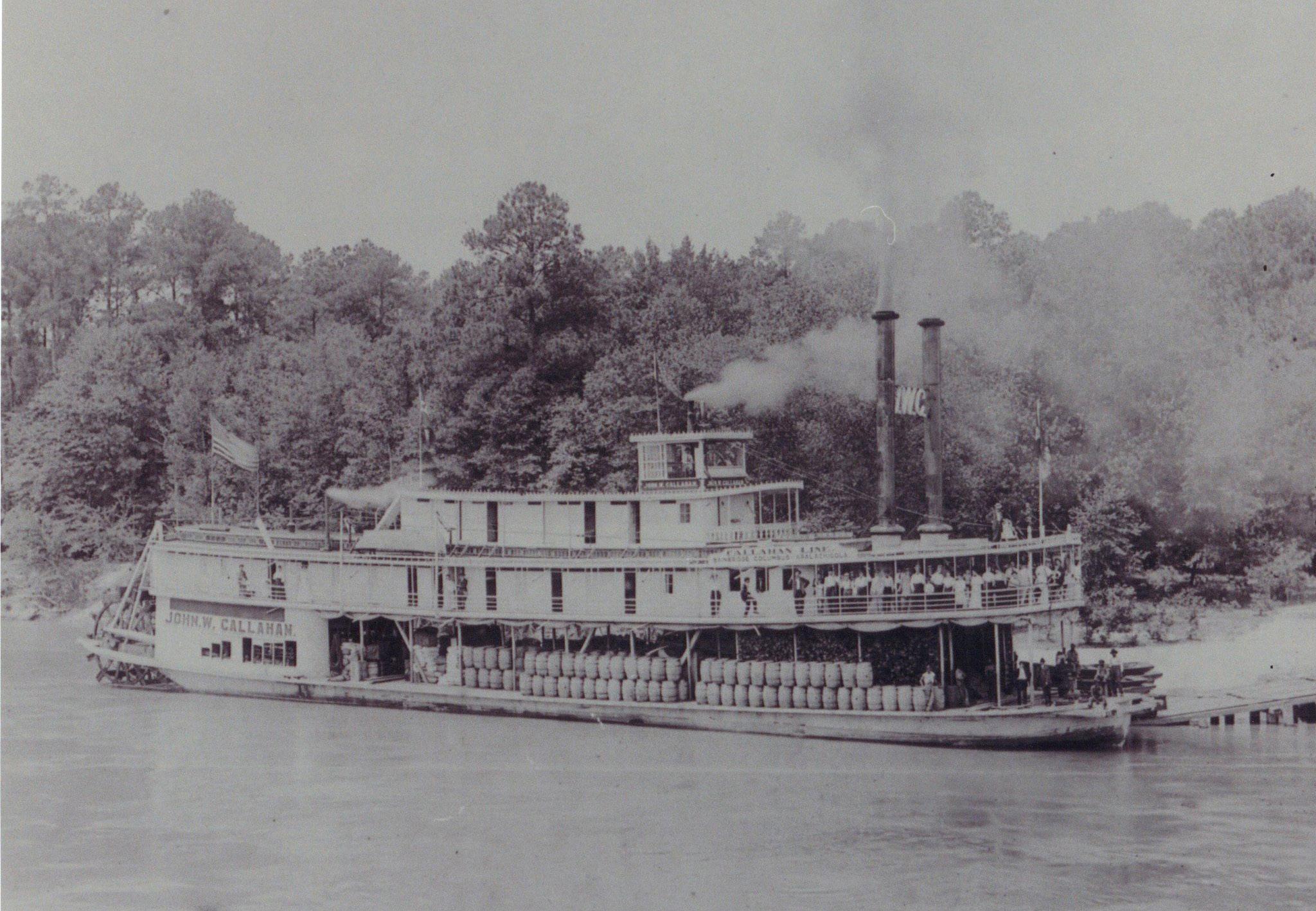
The Maud Alma was a stern wheeler built in 1901, specifically for the Flint River. This meant she had a shallow draft of only 3 feet. Her weight equaled only 23 tons, and she had small dimensions, 70 feet long and 16 feet wide. At this size, the Maud Alma had the capability of floating in shallow water. This was a plus, because the Bainbridge Navigation Company wanted to go farther up the Flint River to the town of Newton. Additionally, her hull was designed like that of a barge, also allowing for float in shallow water. The Maud Alma worked the Flint for about a year and half before being purchased by Ira Sanborn, who put her to work on the very shallow Ochlocknee River. This shortened her career, as the river claimed her on March 12, 1902. Her Captain and crew did survive the ordeal.
The John R. Sharpe was another boat built by the Bainbridge Navigation Company. She was larger, measuring in at 90 feet long, with a 16 foot wide hull and a 4
foot draft. All of this brought her weight to 91 tons. Primarily a freight vessel, she had a crew of six. She was reputable for her ability to handle large amounts of cargo. Her muscles did not even strain as she towed a barge that weighed fifty tons. Nobody paid attention to the amount or weight of the freight that was on the barge. A typical cargo load was about 1,000 bales of cotton, 12,000 sacks of cotton seed, 16,000 sacks of fertilizer, 31,200 bales of hay, 60,000 staves, 50,000 bricks, and 200,000 shingles. So you see, the John R. Sharpe may have been on the small side, but she was powerful.
The John R. Sharpe worked the Flint River for seven years before she hit a snag and sank at A. Clarke’s Landing, on the dangerous upper Flint River, between Newton and Bainbridge. After this, the John R. Sharpe then faded into history, as she was last mentioned in a recording of the sinking in 1908. About ten years later, she did come back to life and is mentioned once more, but as a member of the Thronateeska Navigation Company’s
THE POST-SEARCHLIGHT 43
TRANSPORTATION
DECATUR COUNTY
Submitted Photo
ALL ABOARD: The Callahan Steamboat can be pictured above on the Flint River.
DECATUR COUNTY TRANSPORTATION
fleet, also located in Bainbridge. No records of the John R. Sharpe was found after 1918. Her eventual fate remains unknown.
As mentioned before, the Bainbridge Navigation Company also purchased the notorious steamboat, the Three States. She had quite a reputation for being a death ship and even perhaps haunted. She had a rather interesting history, and it was said that at one time, she harbored a bad luck spirit that proved to cause a ton of trouble.
Built in 1889 in Apalachicola, she was the scene of murders, sank several times, and was prone to burning. She did just that at her wharf in Columbus. Apparently not superstitious, when the Bainbridge Navigation Company heard about this, they put in a bid for her. Another company wanted the machinery from the steamboat, but they did not arrive to claim it, so everything was sold to Bainbridge. The Three States was the first ship that they purchased.
She was a moderate draft boat with a tonnage of 124 pounds, 140 feet in length, and 26 feet in width, rather wide for the Flint River. However, when she was repaired, she was outfitted in style. Now she could accommodate 75 passengers in comfort, with carpeting and fine furniture in the cabins. Passengers could even arrange for hot baths. Known as one of the best on the rivers, her Captain was T. B. Whiteside. However, he only navigated the Three States for a month before he died of pneumonia. After this, the Bainbridge Navigation Company decided
to sell the boat to the Georgia and Florida Navigation Company.
In February of 1903, the government announced that Bainbridge would be the building site for dredges, snag boats, and barges, specifically by the company,

M. A. Sweeney Shipyard and Foundry. Captain M. A. Sweeney, founder of the Shipyard and Foundry Company of Jeffersonville, Indiana, operated the site. He came to Bainbridge and chose a site for his company, located on the high bluff above the Flint River between the Georgia, Florida, and Alabama Railroad depot and Flint River Mills, which is now Elberta Crate and Box Co. This place was chosen due to the proximal availability of suitable timber, mainly found up river at Red Bluff. This ship builder eventually constructed eight boats and one barge, all for the government.
In October of 1903, the Army Corps of Engineers ordered the Sweeney shipyard to build three boats. One of these was the Columbus. Completed in 1904, she was a towboat, 134 feet long, 26 feet wide, and needed 28 inches of water to float. A very large boat for such a shallow draft. The Columbus had a proud career, serving faithfully for 21 years. Her demise came while working at Hurricane Reach, 40 miles north of Apalachicola, when she hit a snag and sank.
Sometime around 1908, the Thronateeska Navigation Company came into existence. It was owned by three men, who were said to have been very experienced in the steamboat business: C. N. Ledwith, Conrad N. Buchanan, and
T. N. Buckner. The main route for this company was also the Flint River. They built two steamboats, the Flint and the T C. Drake Jr., and bought the Mary, as well as salvaging several other boats, including the wreck of the John R. Sharpe. They bought her, raised her, and put her back in service.
The Flint had a special design to her hull, drawn up by master shipbuilder Sam Johnson. The 21 foot wide bow had a rounded front. This innovation made it possible to push away any vegetation that formed an obstruction by allowing it to slip around the smooth bow. This hull was launched on May 11, 1920. A few days later, the crew began construction on the cabins and the pilot house.
The Flint’s main purpose was to venture down the Apalachicola River, thus adding to the markets that the company served. In 1925, the Flint was sold to Captain Roy Connell and his brother, Ralph, both from Wewahitchka, Florida. She ran for many years, eventually sinking on the Flint River.

Her machinery was salvaged and used in Elberta, which was built in Bainbridge in 1927. This boat was a sternwheeler, 59 tons and 80 feet by 20 feet, with 3 feet of water needed to float. She hauled mostly timber products on the Flint River for many years for the Elberta Crate Company.
The T. C. Drake Jr., built in 1908, was launched in November of that year. Being 95 feet long and 23 feet wide, her dimensions were perfect for running the Flint River. She also ran on Spring Creek as far
SERVING OUR COMMUNITIES FOR 49 YEARS

44 BICENTENNIAL EDITION
as Oil Still Springs. Eventually, the T. C. Drake Jr. replaced the John R. Sharpe on that river.
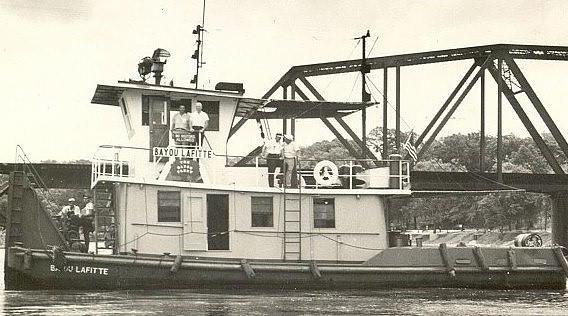
However, the T. C. Drake Jr. sank and the Thronateeska Company had to salvage it. When ready for the river, she was renamed the Conrad N. Buchanan, after one of the company’s owners. Her dimensions remained the same as before. However, the Conrad N. Buchanan, eventually met with fate and ran into a snag on the Flint in December of 1918. She went down after almost ten years of service. However, revitalized, she continued to run the rivers for several more years. because it was rumored that she carried one hundred barrels of whiskey in her cargo. This sunken treasure was much sought
after, especially during Prohibition.
The Mary did not rest in peace. Stories say that people from as far away as Chicago came to salvage the supposed whiskey onboard. Some even built a cofferdam to get the water away from the sunken boat, making it easier to search. However, this did not work. It seemed like the Mary whispered, “If you want my prize, I dare you to come and get it.” Her cargo evaded all efforts to retrieve it from the river bottom. For decades, the remains were visible, but they are now gone. No one knows what happened to her cargo of fire water.
The Bainbridge Navigation Company, the M. A. Sweeney Boatworks and Foundry, and the Thronateeska
Navigation Company lasted a few more years, but few new boats were built. The railroads now had a stronghold on transportation and the romantic, magical steamboat disappeared.
THE POST-SEARCHLIGHT 45
DECATUR COUNTY TRANSPORTATION
Submitted Photo
JUST FLOATING BY: The Bayou Lafitte often traveled through Bainbridge to export their goods.
Doctors provide remedies to early patients, help during epidemics
In the early 1800s, even simple illness imposed a more severe threat than that of today. The frontier area housed only a few log cabins, scattered throughout the vast countryside. Due to the terrain and time constraint, folks mostly relied on home remedies. However, when a doctor was needed, the sick person had to go to the office by horseback, ox and wagon, or horse and buggy. Therefore, people seeking medical help went to see a doctor only if they were very ill. If they were too sick to go to the doctor, he visited their home. Emergency rooms did not exist either, so the doctor’s office also treated these types of cases. Archibald in Thomasville was the only public hospital in the area, and therefore, very little patient transfer
occurred. In fact, there were no public facilities in Albany or Tallahassee until after World War II.
Early newspaper advertisements promoted the work of local Doctor Ridley. He practiced medicine in a log cabin office on the extreme western border of Decatur County, located two miles south of Porter Landing on the banks of the Chattahoochee River. A copy of his ad reads from the June 23, 1829, edition of the “Southern Spy” newspaper:
“Dr. Ridley has located himself in Decatur County, eight miles above Major M. Hardin’s Ferry and two miles below Porter’s Ferry on the Chattahoochee River. Those requiring his services will find him at his residence. His fees for advice and personal attendance will, in every
instance be discretionary with himself, no detail of rates, therefore will be stated.
He will in every instance charge what he may deem an equivalent for his services. In all cases a note will be required for the amount due. Those who do not feel disposed to submit to the terms proposed in this notice are particularly requested not to call on him.”
As with most physicians at this time, it is not known whether Dr. Ridley actually had a medical degree. However, folklore tells us that if he had one, he would have been the first to say so. He also advertised that he could cure diabetes, then known as “dropsy”.
Eventually, a large number of doctors opened their offices in Decatur County. During the early 1830s, Dr. William N.

BICENTENNIAL EDITION 46 DECATUR COUNTY MEDICAL
Submitted Photo
HELPING THOSE WHO ARE SICK: Bainbridge Hospital (property of Dr.A.E.Alford, surgeon) in Bainbridge, Ga.
DECATUR COUNTY MEDICAL
Bruce began his practice in Bainbridge. Dr. John B. Saunders also opened an office at the corner of Broughton and Crawford Streets in 1831.
Necessity required that most of the physicians be general practitioners, but there were a few specialists. Doctor T. R. Browne specialized in treating the diseases of women and children. Doctor Ennis was an optician. Bainbridge also had a dentist, whose name was not found.
Dr. Jacob J. Subers, who advertised in 1859, stated that he was the only representative of the Reformed School of Physicians in Decatur County. The next year Dr. D. H. Wilmot advertised that he was a Botanic Reform Physician.
Those who made medicine their life’s work often had additional incomes. Most of these men were often farmers. Some opened pharmacies to sell the medicines that they prescribed.
By 1860, a total of eight doctors resided in Bainbridge and thirteen others lived in the county. Bainbridge then had two dentists. One of them, Dr. C. W. Powers, practiced dental surgery out of an office in Dickinson’s Drugstore. Powers’ services included from one to an entire set of teeth: “inserted and costing a reasonable amount”.
When a series of epidemics came to the area, many quarantines were prescribed. At the discovery of vaccines, Dr. James A. Butts often specialized in giving these shots.
Even though Decatur County did not have a hospital before the War Between the States, neither did the other vast areas in southwest Georgia, northwest Florida, and southeast Alabama. Then, Decatur County emerged as the center for this service.
The first private hospital to erect was the original Bainbridge Hospital, built in 1916, by Doctor A. E. B. Alford. Born May 18, 1876, Dr. Alford was a surgeon who moved to Bainbridge in 1914, from
Greensboro, North Carolina. In 1916, he located his first hospital in a large, twostory house at 711 East Shotwell Street.
For two years, Dr. Alford operated the hospital from his home before opening a new facility in 1918. The new Bainbridge Hospital was a three-story, gray, stucco building on the northwest corner of Evans and West Streets. The hospital spanned almost one square block that extended from West to McNair Streets.
The hospital displayed beautiful grounds, including two fish ponds, one on the north, and the other on the south. The yards had a variety of fruit trees and bushes, and pecan trees lined the back drive. The hospital featured an enormous stairway leading up to the front porch.
The staff entered through the back of the ground floor through the kitchen. Gertrude and Sadie were the cooks at this time. At the end of the kitchen stood a dining room with a long table where the nurses and doctors ate.
Also located on the ground floor, was a wing used to house the nurses, as well as the laundry room, which often smelled of bleach. For over thirty years, Dr. Alford hired and trained his own nurses. He also had several requirements for them: that they live there, on the ground floor of the hospital, and that they not marry, because he wanted them to focus on the patients only.
The second floor, the main floor, housed admitting, registration, and the waiting area. There was also a sun porch with windows that lined three of the walls - Dr. Alford’s favorite place. Also, on this floor, existed a doctor’s study, located next to the examination room, used for treating patients and sterilizing medical instruments. Everything ( like needles, syringes, and forceps) had to be sterilized, for at this time, there were no “throw away” items. The operating room was located on the third floor. Dr. Alford personally managed the hospital until 1946,
when he leased it to Drs. George Epps, Charles Belleville, and Henry Bridges.
Dr. Alford’s wife, Marian Charlotte, was also a doctor and the Countess de Pau. The two met in 1906, when both served as aid workers during the San Francisco earthquake. Unfortunately, they had a short marriage, as she died in 1918. Dr. Alford never remarried. He died at Bainbridge Hospital on January 14, 1948, at seventy-two years old, after having been sick for several months. He is buried by Marian in Oak City Cemetery.
A longtime resident shared her memory of Bainbridge Hospital, formerly known as Alford Hospital, in her diary. She remembered the delivery room, where she gave birth to two of her children. She stated that, “The people were so kind, but the delivery room was very barren. There was little else in the room except for the delivery table and a single, 100-watt bulb, that hung from the ceiling”.
Another care center, the Riverside Hospital, had an unusual beginning. It started in Dr. Gordon Chason’s home, where for two years he and his brother, Dr. Jefferson Chason, operated a hospital out of his house on 315 West Shotwell Street.
Historical accounts from the memories of Dr. Gordon’s daughter, Mary Cornelia Chason Miller, allows for a detailed description of life during the start-up of the hospital in their home.
Mrs. Miller was eleven or twelve at the time, and remembered when her father and uncle brought the first patient into their home. The man, Leonard Brown, needed an emergency appendectomy. However, there was not enough room to perform the operation in her uncles’ home. Her father and uncle asked her mother if they could bring him into the house, where they then performed the surgery in an upstairs bedroom. Mr. Brown remained in their house for two weeks, treated like a guest with utmost
THE POST-SEARCHLIGHT 47
hospitality. Her mother put embroidered sheets on the bed and served him afternoon tea in her china cups.
At first, it was supposed to remain a single occurrence, but the day before Brown was released, three more patients came into the house. From then on, the house was constantly filled with patients.
Throughout the next two years, the Chason house continued to serve as a hospital, as well as a home. During this time, the Chason brothers, at the “urging” of Mrs. Chason, began building a new hospital. Mrs. Chason picked out the place for the hospital, and she told the Chason brothers to start building, “Right away! I want my house back!”
On November 9, 1918, about two years after the first patient arrived at the Chason home, the Riverside Hospital opened its doors. It was a beautiful, two-story
brick building on Donalson Street. Situated in a beautiful oak grove on the high banks of the Flint River, by a large, graceful bend, Riverside was appropriately named and known for its quiet, peaceful atmosphere.
Up-to-date and equipped with the latest medical machines at the time, it provided preventative health care for Bainbridge and Decatur County, but it was ready at all times to treat patients for almost any kind of ailment. Some of the physicians and surgeons on the hospital staff included: Drs. Gordon Chason, R. Wheat who moved to Bainbridge from Amsterdam, Georgia, and W. Wilkerson. Unfortunately, Dr. Jefferson Chason, born in 1861, passed away in October of 1918, just one month before the hospital opened.
Other doctors at Riverside include Dr.
J. Pierce Tucker, who joined the staff in 1946. With the retirement of Dr. Wheat in 1951, several more physicians were added to the staff: Drs. Frank Gibson along with T. Dupree. When. Dr Wilkerson passed away in 1952, another doctor joined the staff, Davis J. Griffin.
In 1947, an expansion took place, and the Riverside Clinic was built and operated along-side the hospital. The Hospital and Clinic served Bainbridge and Decatur County until 1960, when the current, Bainbridge Memorial Hospital, opened its doors. For several years after closing, the Riverside Hospital became the Fidelis Nursing Home.
After some time, when Memorial Manor was complete, the Riverside Hospital building was torn down. However, the Riverside Clinic building remained standing and used by the City of Bain-

BICENTENNIAL EDITION 48 DECATUR COUNTY MEDICAL
bridge.
In 1935, Dr. E. A. R. Lord came to Bainbridge. He established a small hospital, known as St. Luke’s Infirmary, which had 8 beds. It had a kitchen, an operating room, an anesthesiologist, two practical nurses, and an orderly. Dr. Lord served as the medical director and surgeon.
Also in 1935, another man came to Bainbridge, making a big difference in the available health care in the city. Dr. Joseph H. Griffin, a prominent African-American physician and surgeon, set up his general practice in a twelve-bed hospital and clinic over a store on the northside of Water Street, near where it intersects with Clay Street. Dr. Joseph Griffin and his brother Dr. Davis Griffin, along with Drs. Cooper and Hutto, a dentist, treated patients out of this clinic.
Dr. Griffin’s clinic was so popular that
in three years, he had to enlarge it to eighteen beds. The need for health care kept increasing and in 1950, he built a brick structure on the corner of Broad and Planter Streets, which now became the Griffin Hospital. It had a fifty-bed capacity and was fully equipped with modern medical equipment.
The staff consisted of Drs. Joseph H. Griffin and Cooper. Mary L. Griffin Perry served as secretary, T. Jan Perry as administrator, and Blanch Campbell as the superintendent and dietician. He also had a full staff of student nurses from the community, who were always on call to assist the patients.
In 1960, when Bainbridge Memorial Hospital opened, the doors to both Riverside and Griffin Hospitals closed. The Griffin Hospital building still stands, and today it serves as the offices for PX Print-
ing. The outside has changed very little from the days when it served as one of the best centers for health care in Georgia. While the other hospitals are long gone, thankfully, this one historical building still stands, fully intact.
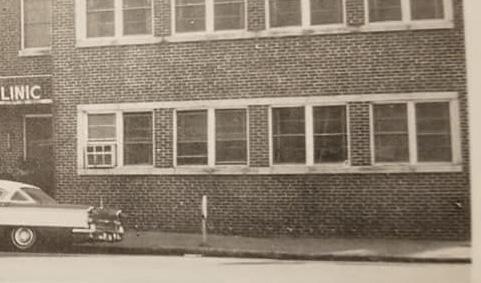
THE POST-SEARCHLIGHT 49 DECATUR COUNTY MEDICAL




BICENTENNIAL EDITION 50


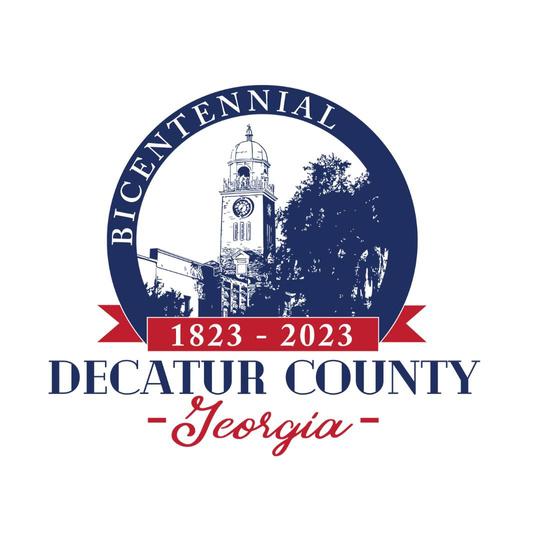





THE POST-SEARCHLIGHT 51 Celebrating the community we love.
Local hotels become favorite gathering place of residents & citizens
Mr. Maxwell Moore owned and operated the county’s first hotel and tavern. The construction date and exact location are unknown. However, in the “Southern Spy” newspaper, on January 5, 1830, it was said that Moore, “furnished food and drink for a July 4, 1829, festival dinner for one dollar per person, for the Meridian Masonic Lodge,” indicating that this particular hotel existed at this time. Also, in the “Southern Spy”, an article stated: “a plentiful feast of good foods and as much spirits and wine as is necessary for the occasion.” This same article mentioned a ball, to be held in July at 7 o’clock in the evening, for three dollars per ticket.
An early resident, who had moved away, wrote in his recollections of
Bainbridge, that in 1834, the town had one hotel, Lester’s Hotel. He continues in his journal saying that it had, “very few boarders and very little to eat”.
Cook’s Hotel operated in 1854. This establishment was described as “bordered on the north by Water Street, on the east by Crawford, the south by Broughton, and west by Florida Street. Later in the year, it was sold to John Hibberd, along with all of the furniture for the rooms. This was mentioned to have included sixteen bedsteads, one suspended lamp, and three square glass lamps. Hibberd also bought the livery stable. A record written on April 16, 1858, states that the Alligator Stage Line stopped there regularly. As seen in the “Argus” newspaper, on March 4, 1859, the Hibberd Hotel was bought
by B. M. Griffin, and then renamed the “Bainbridge Hotel”.
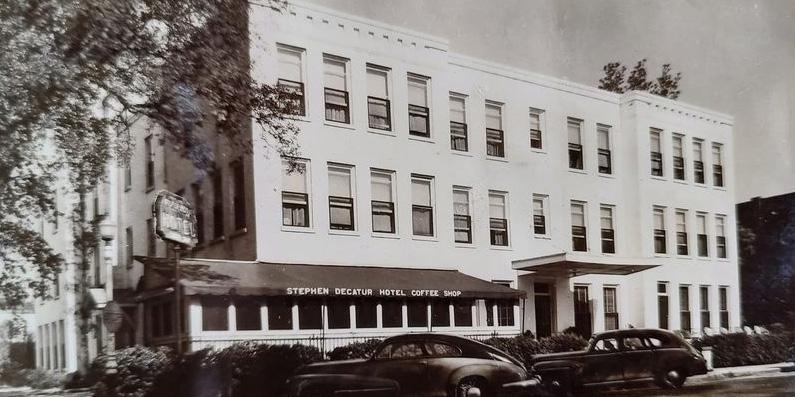
In 1856, William Washington Harrell built his hotel on land north of the square. It was bounded by Market Street, Broad Street, Water Street, and West Street. The owner and builder, Harrell, was born near Climax, in a covered wagon, in 1822. His hotel later became the Decatur House. The newspaper, “Argus”, reported on March 18, 1859, that street lights had been placed in front of the Decatur House, and that there were twenty-two arrivals.
The oldest known stagecoach station and inn, once located on River Street, believed to be the oldest house in Bainbridge, and whose name remains unknown is worth mentioning. Built in
BICENTENNIAL EDITION 52 DECATUR COUNTY HOTELS
Submitted Photo
A PLACE TO REST YOUR HEAD: The Stephen Decatur Hotel and Coffee Shop was a great place to stay in Downtown Bainbridge.
DECATUR COUNTY HOTELS
the 1820s, it was a two story house constructed of handmade, sun-dried bricks. This old house was still standing in 1958 and was occupied as a private residence. Through the years, it had been remodeled with the latest safety devices and all modern appliances. The Decatur House also had a stable and restaurant along with other amenities and beautiful gardens.
In 1857, Charles Smith Daniels built a large brick home on River Street, which later became a stage depot and inn, accommodating both stage passengers and those from steamboats docking on the Flint River, which was practically at his back door. This building was demolished in the early 1960s.
Another boarding house, known as the Waverly House, was advertised in the “Argus” in its December, 1868, edition. It reports that the Waverly House resided on Planters Street. One source recalled the boarding house as the home of J. E. Dickenson.
On June 26, 1869, the “Southern Georgian” reported about a new hotel, the Sharon House, built on the northside of Water Street and west of the Decatur House.
The “Bainbridge Democrat” of November 16, 1870, says that the Sharon House, “a brick building of thirty-five to forty rooms, newly furnished, is almost finished.” This replaced a wooden structure located on the north side of the square.
The three-story Sharon House was not completed, however, until November 1872. Its builder, John Sharon, came to Bainbridge after the War Between the States. The structure, containing from 35 to 40 rooms, added the Oakland Hotel onto the new building. The Oakland was a wooden building located on the north side of the square and was operated by Captain des Vergers. Previously mentioned as a stagecoach stop in the “Bainbridge Democrat” newspaper, the
Sharon House now became a stagecoach stop too.
In August of 1885, the Sharon House became known as the “Artesian Well House”. Presumably, this was due to its proximity to the artesian well that existed on the northeast corner of the square and was in use for a long time. However, it soon reverted back to its original name. The Sharon House occupied a prominent place in the civic and social life of the community, and it even opened its parlors to the Episcopalians for service until they completed the building of their church.
In 1901, the Sharon House, almost completely torn down, was then replaced by the Bon Air Hotel, a brick structure of 53 guest rooms and five store rooms on the first floor. The three-story Bon Air was a venture of Dr. J.D. Chason and his brothers: Middleton and Erasmus Powell. Later, it was sold to John W. Callahan, and it operated under the management
of Mrs. B. D. Fudge. Bon Air became famous because of this lady’s Cream Pear Pie. People came from miles around to enjoy this scrumptious dessert, along with the delicious regular meal offerings. In the 1930s and 1940s, the long second story porch (which overlooks Willis Park) was used in warm weather as a delightful and charming open dining area, in addition to the main dining room.
Another name change took place in 1938, when the Bon Air became the “Gilbert Hotel” under new management. It operated under this name until 1951, when Mrs. Henry J. Maddox and Mrs. R. Y. Howell, who had become the owners upon the death of their father, John W. Callahan in 1929, took over the operation and restored its former name, Bon Air.
This remained until 1965, when Rueben M. Reynolds, owner since 1962, ceased its operation as a hotel. This brought to a close the long, colorful, and historical background of this very old

THE POST-SEARCHLIGHT 53
Submitted Photo
THE BEST DESSERT IN TOWN: The Bon Air Hotel became famous for Mrs. B.D. Fudge’s Cream Pear Pie and offered regular meals.
DECATUR COUNTY HOTELS

hotel. Now, apartments take up a large portion of the building and shops exist on the lower level.
In 1900, T. C. Wainman built a hotel on the northwest corner of Broad and Shotwell Streets. The Wainman Hotel was a handsome, four-story structure with charming porches, and it contained approximately 50 guest rooms.
The Wainman was later bought by John W. Callahan, and it was operated under his ownership and then subsequently the ownership of his son, John Wesley Callahan Jr. At this time, the name changed from the Wainman Hotel to the Callahan Hotel. However, in late 1941, fire damaged a portion of the building. It was now sold to the Bainbridge Hotel Corporation, headed by Julian G. Kwilecki. Partially remodeled, removing the fourth floor, it became a three-story building with 44 guest rooms. The name was changed to the “Stephen Decatur Hotel”, honoring Commodore Stephen Decatur, for whom our county is named.
In May, 1971, the Stephen Decatur Hotel closed its doors. During its entire lifetime, this hotel was a favorite gathering place for citizens of Bainbridge and Decatur County. Its reputation was that of a gay and friendly spot on almost any given day of the week. Frequently used for various affairs like weddings and family reunions, it was especially famous for its fantastic dining room and enclosed dining porch.
Sadly, in July, 1973, a demolition crew reduced its 73 years of hotel history to a
pile of nostalgic rubble, making way for a bank building, the property having been sold to the First State National Bank earlier in the year. The large oak on the corner remained a single landmark, which as a younger tree, shaded the porches of the old Wainman. The handsome portrait of Commodore Stephen Decatur, its last namesake which had hung in the parlor of the hotel, now hangs in the lobby of the bank.
Many other hotels were located outside the town of Bainbridge. Nine miles to the east in Climax, Freeman A. Mize built a two story, brick hotel in 1902, at the southwest corner of Main and Railroad Streets. The site is directly across the street from what was once the Allen Mercantile Store building, and, now, a vacant lot. It was known as the “English Hotel”, operated by Mrs. Mamie English, widow of Dock English, and her daughter Rosebud. Before its closure, the hotel was under the management of Mrs. Bert Cliatt and operated as the Cliatt Hotel.
While not strictly classed as a hotel, the Harrell House in Climax is worthy of mention. Built in approximately 1908 by Charles P. Evans, the large, two story, and white frame building operated as a boarding house.
Some years later, the T. J. Harrell family bought the property and Mrs. Harrell continued the boarding house operation, frequently renting rooms to people awaiting the late arrival of trains at the station across the street, or to other travelers desiring a room. Her fried chicken din-

ners became famous, and train passengers soon longed for her infamous, tasty boxed lunches. Often, orders were called in for when the trains arrived, so that the passengers could disembark and have a hot, tasty meal waiting inside the large dining room. Mrs. Wallace Grover, Mrs. Harrell’s daughter and assistanat, continued the call-in service of meals after her mother’s death in 1972, using the same dining room.
Judge Perry D. Rich built the first motel in Decatur County in 1934. It was situated in West Bainbridge on the north side of State Highway 84 west, in front of Flint River Mills. Named “Dixie Pines”, it began with eight units, some of which were individual cottages. With his business flourishing, Rich eventually increased the number of units to sixteen. Judge and Mrs. Rich successfully operated the Dixie Pines for 24 years, closing it when the construction on the State Highway 27 bypass began in the late 1950s.
The county’s second motel was built by O. S. Kitchings in 1947, on Highway 84 west, at the junction of Highway 27, in west Bainbridge. This was called the Four Acre Motor Court. It was operated by Mr. Kitchings and his two sons, O. A. Jr. and Sherwood. This motel had eight units with a total of thirty rooms. In 1967, the business was sold to a variety of persons in Atlanta and since then, has changed hands several times, with the latest known change occurring in 1973, to three Bainbridge businessmen who bought it as a land development oppor-
BICENTENNIAL EDITION 54
tunity.
Beginning in 1954, the motel business began to expand rapidly. Below is a compiled list and brief description of them:
1954 – Bainbridge Motel and Restaurant on the west side of south Scott Street. G. Harvey Dollar and James A. Overton were the original builders and owners. It had twenty-six units and a swimming pool.
1955 – Seminole Motel was built by L. B. Ritch at the junction of Highway 84 and Spring Creek Road in west Bainbridge with fourteen units. Closed in 1966, it was then converted into apartments.
1957 – Franelgo Motel and Restaurant,
built by Sam Richards, was on the north side of Highway 84 west. It received its unusual name by combining the names of his daughters: Frances, Nell, and Margo. Once opened, it had eight units and was later expanded to twelve. A restaurant was added two years before its sale to Thomas Day.
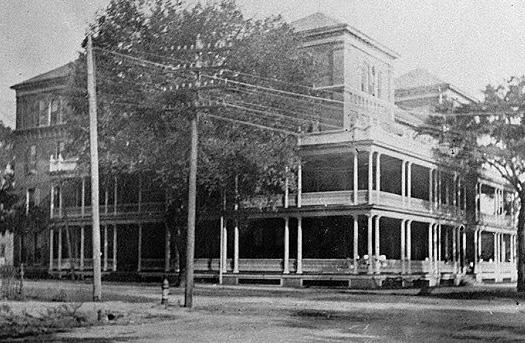
1960 – Palmer Motel was built, owned, and operated by Lloyd Palmer. The motel had thirty-five units and a swimming pool. It was on the east side of Highway 27 south.
1961 – Glen Oaks Motel was on the west side of Highway 27 south. Its owner, J. W. Sumner, began construction in 1960, completing and opening the business in 1961. Glen Oaks had 24 units.
1961 – Dixie Rest, on the east side of Highway 27 south, contained 22 units. Its builder and first owner was William Norris.
1961 – Cherokee Motel on the west side of Highway 27 north was built by L. B. Ritch with fifteen units. It closed in 1972.
1969 – Holiday Inn and Restaurant was built and situated on Highway 2.
THE POST-SEARCHLIGHT 55 DECATUR COUNTY HOTELS
Submitted Photo
SHARPEST PLACE TO STAY: The Wainman Hotel was a handsome, four-story structure with charming porches and approximately 50 guest rooms. It was later purchased by John W. Callahan, who changed the name.
DECATUR COUNTY SCHOOLS
men assisted by women.
The first record of a lot sold for the building of a school did not contain a specific date. This was sold to A. A. Allen for $200, by Alex W. Sneed, Johnathon Dickenson, and William Peabody. It was described as the, “Old Male Academy lot on Quincy Road”.
Sometime after, another parcel of land was sold for the construction of a school. It was described as: “a lot that was west of Washington Street and south of what was then Church Street, north of the Methodist Church, and also included a part of Shotwell Street”. The construction site spanned 3 and a quarter acres, but the school did not receive a name.
Alexander Shotwell was very interested in education in Bainbridge. Therefore, on February 13, 1840, for the cost of one dollar, he deeded a lot on the south side of what is now Shotwell Street for the building of the Bainbridge Male Academy. The trustees were Bennet Crawford, Dempsey Harrell, Fowler Holt, Littleberry Mills, and William Peabody. This lot was: “One hundred yards along the fronting, and extending south one hundred twenty-two yards”.
Decatur County covered much more territory back then and transportation was not available. Therefore, parents had to provide this. Students from the more rural areas surrounding the city often stayed with friends in Bainbridge during the school year, with an average of twenty dollars per month for room and board.
Two years later, in 1842, the Female Academy was constructed on a lot which the Presbyterian Church now occupies, and it extended out to include part of what is now South Broad Street. On December 22, 1842, the name was changed to Bainbridge Female Academy.
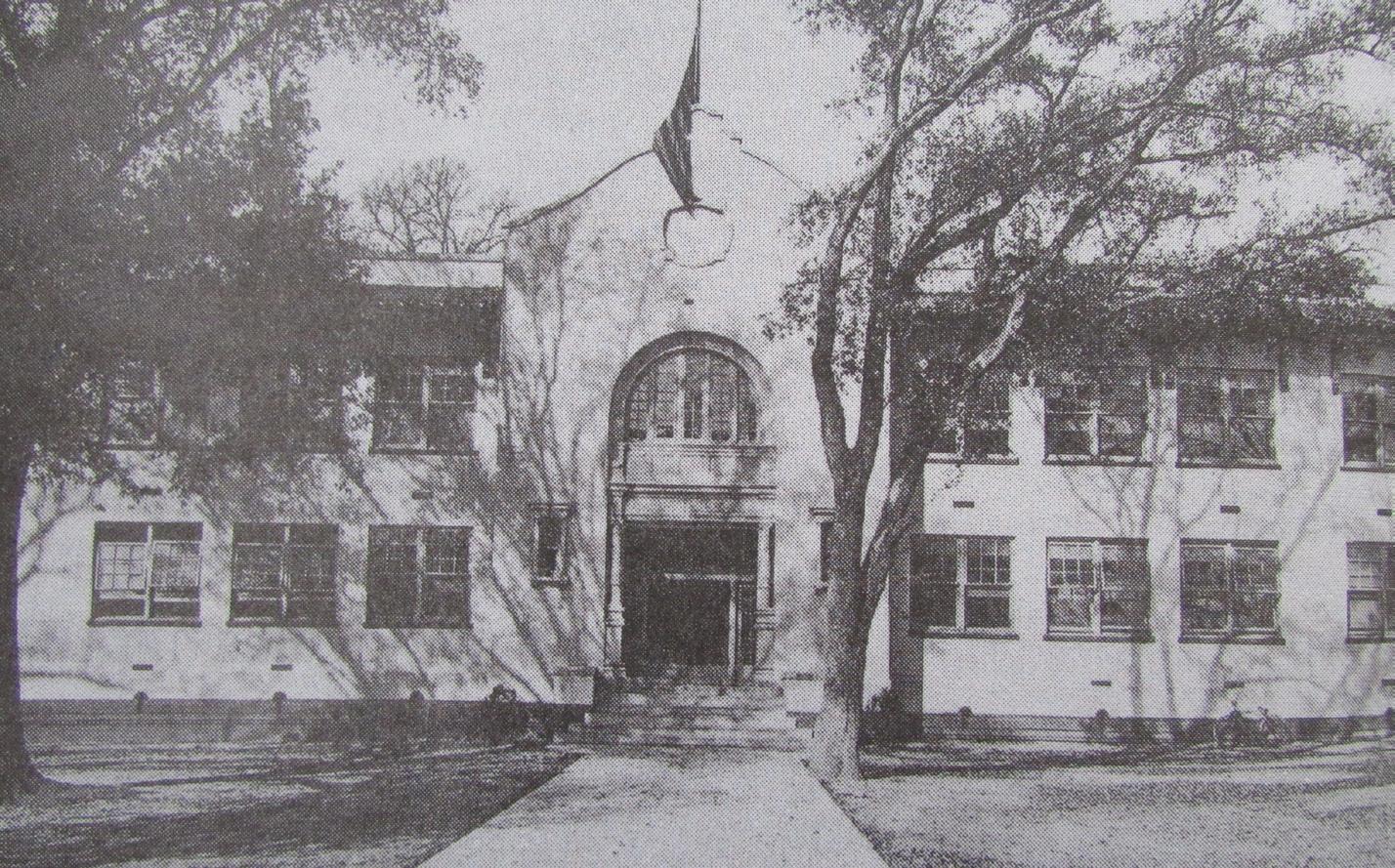
According to the January 19, 1857 issue of the “Bainbridge Argus” newspaper, a Female High School opened. Virginia E. Baughn was president, assisted by Emma Hines. The Bainbridge Male Academy of 1858 had J. R. Farrish as principal. They also established a five-month term for school. The prices were as follows: Primary Students paid $10.00, Higher Branches of English $12.50, Greek, Latin and other languages were $15.00. Arithmetic, algebra, and geometry were also taught. That same year,
a female college also existed in Bainbridge. Later, in September of 1861, a Female School and an academy opened up in Greenshade.
Once the War Between the States subsided, education came back to the forefront. On November 16, 1866, J. M. Potter and J. Law sold all of the lots and the buildings, west of a continuation of Broad Street, for $1,000 to William O. Fleming. On that same day, Fleming sold a part of these lots to W. H. Allen and gave him the $1,000 he’d received from Potter and Law. This was to cover the building, equipping, and operation of a school. On December 18, 1866, the county appointed William O. Fleming, Thomas F. Hampton, and H. M. Beach, as trustees of what would be the new Bainbridge Male and Female Academy. They added the
THE POST-SEARCHLIGHT 57
Submitted Photo
HITTING THE BOOKS: In the early days of schooling, male and female academies were popular, with the Bainbridge Male Academy and Bainbridge Female Academy both opened in the 1800’s.
DECATUR COUNTY SCHOOLS
stipulation that the property would revert to them, if Allen or his successors failed to meet the conditions. However, when everyone looked closely at the existing buildings on the lots, they all agreed that they were in too bad of a condition for effective use.

Therefore, in January, 1867, the trustees consented to Allen’s exchange of a lot for one on the north side of Shotwell and east of the Baptist Church, with the same conditions as those which applied to the first property. It was here that the Bainbridge Male and Female Academy was finally built.
After the War, several private schools also opened. One opened under Mrs. Matthews on December 2, 1868. Another opened its operation on January 9, 1869 by William. H. Allen, with the tuition of $30.00, $40.00 or $50.00 per year, depending on the courses taken. On November 27, 1869, Reverend Dr. Babbitt opened his school for English and Classical subjects.
The “Southern Georgian” newspaper of March 6, 1869 reports about the completion of a school located on the north side of Shotwell Street, in the block west of Donalson Street. This frame
building was called the Whittier School. Later, it was torn down and some of the lumber was used to build a new school on the north side of Planters Street, east of Collier Street. On May 26, 1905, G. R. Hutto was appointed head of this school.
The “Southern Sun” newspaper issue of June 30, 1870, told of the opening of the Bainbridge Male and Female Institute under Professor Allen. It had 45 pupils when it closed.
Residents soon realized the overwhelming, superabundant number of schools in the area. In January of 1871, an election was held to better finance the sprawling and unregulated educational system. To do this, they appointed a representative from each County Board of Education and rural area. These included: Whigham, Calvary, Lower Spring Creek, Attapulgus, Fowltown, Bainbridge, Lime Sink, Rock Pond, and Pine Hill.
On February 10, 1871, the Decatur County Board of Education met at 10 am., in the Bainbridge courthouse. John R. Hayes was elected president and R. W. Davis was elected secretary and county school commissioner.

In 1874, the first buildings
erected at the Potter Street site, which has been in use ever since. The earliest buildings were made of wood, but in 1912, the brick structure on the east side of Potter Street was constructed. In 1923, another was built on the west side of Potter Street to house the Bainbridge High School. The first building then became known as the Grammar School.
The Independent School District of Bainbridge was created by the state legislature on September 26, 1879, so that taxes could be used to support the schools in the city.
Around the turn of the century, the Bainbridge High School was known as the Georgia Southern Military Academy, and was coeducational, with a principal and eleven teachers. Three courses were offered: English Classical, English Scientific, and English Commercial.
By 1908, the county population was estimated at 30,000 with the number of schools being anywhere from 85 to 90, with about 150 teachers, and an enrollment of about 6000 pupils in the public schools outside of Bainbridge. Bainbridge Schools were said to have an enrollment of 1,100. The appropriation from the state
BICENTENNIAL EDITION 58
DECATUR COUNTY SCHOOLS
maintained the county schools for six months of the year. Some districts supplemented them locally to permit nine-month terms. With financial hardships, the smaller and the private schools (with the exception of kindergartens and nursery schools) gradually disappeared.
In the early 1920s, Superintendent Roland Bower, pioneered the
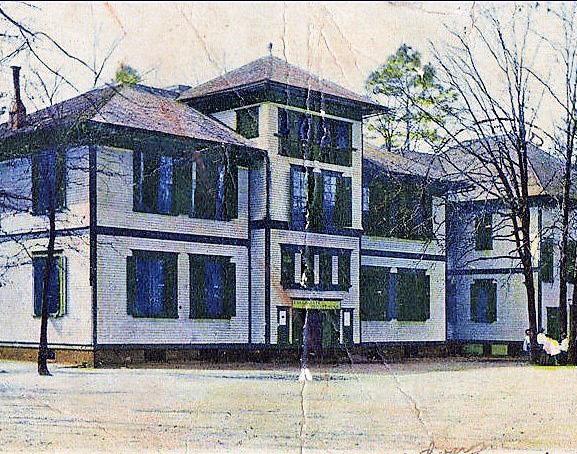
consolidation of Decatur County schools. Numerous one room schools were closed, and nine modern brick structures were built to replace them. Also during the 1920s, more consolidated schools opened at Attapulgus, Bell-Dixon, Bethany, Brinson, Climax, Faceville, Fowltown, Pine Hill, and Mt. Pleasant.
In 1939, the Bainbridge Inde-
pendent School District merged with the county system under the leadership of Superintendent Andrew Avery. E. G. Elcan, who was first employed as superintendent of the Bainbridge system in 1917, and then became principal of the schools in the Bainbridge District of the county system.
THE POST-SEARCHLIGHT 59
Submitted Photo
OFF TO COLLEGE: High schools were not the only offering in Bainbridge. Pictured above is the Georgia State Military College of Bainbridge in 1906.








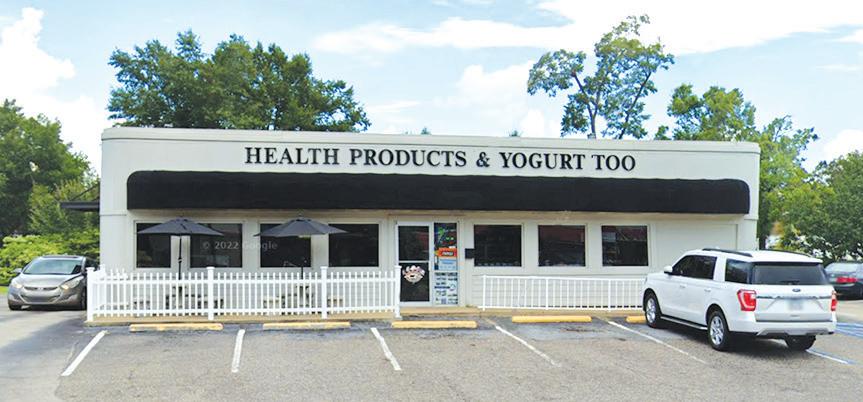
BICENTENNIAL EDITION 60
Proud of Decatur County’s History, Excited About the Future.
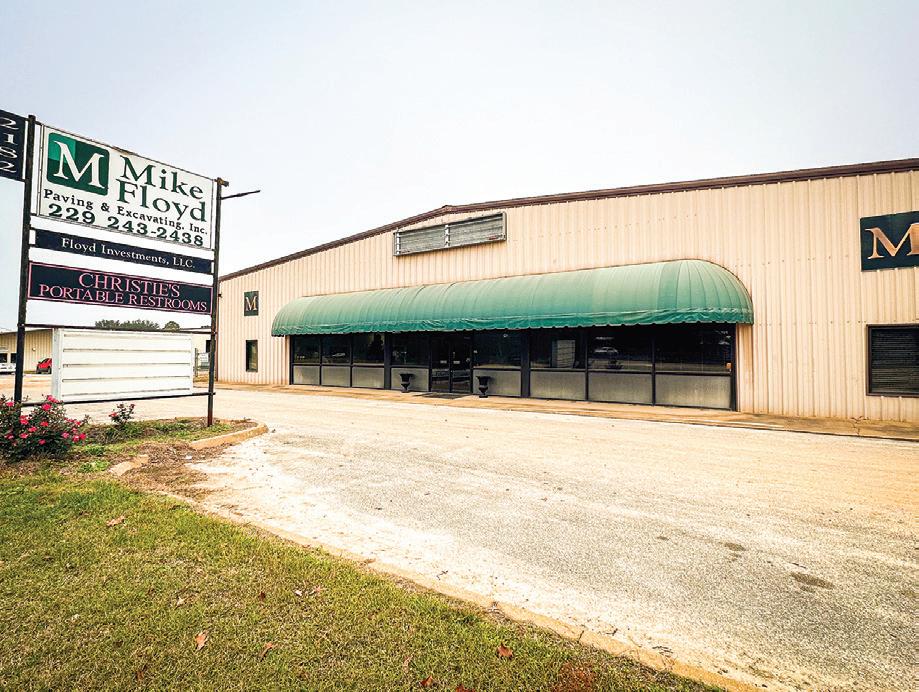








From Southlands to the Earle May Boat Basin, Decatur County’s outdoors have changed drastically over time

Southlands was located just outside of Bainbridge. In the early 1900s, amateur archeologist Charles Moore discovered the first sign of human life at what became Southlands Experimental Forest. Since then, Southlands has had several owners, and has provided important knowledge in many areas like timber, soil, and other related areas.
Moore had found evidence of human habitation: a two-foot by nine-inch sand and mud hill, about fifty feet across at its circular base. This turned out to be an ancient burial mound, rising up in an old deserted field about one-quarter mile south of what used to be Munnerlyn’s Landing. This find was significant since, even though the mound had spread out
somewhat through the many years of its existence, it was almost entirely free from previous digging. Moore and his team thoroughly excavated the site, except for a small portion of land that was around a fruit tree.
Sixteen burials were found in this mound, which, in some places, had less than one foot of dirt covering the skeletons. Even though the bodies were very close to being exposed, none of the remains had been touched. However, some bones were badly decayed, almost beyond recognition as being human, but still, some were fairly intact, lying together, in a flex position.
Along with these bones, artifacts were also found. As was the custom of these Indians, the person who passed
on took with them what was believed to be needed in the afterlife. Earthen water bowls, cutting instruments and charcoal were considered important items. Most important were the water vessels. Some of them were fragmented, but some were whole. However, what made them important were the pictures painted in red paint. The most distinct of the markings was that of a human eye. These finds were dated as being some 8,000 to 10,000 years old.
Next, the Creek Indians inhabited this area, and after them, the farmers. They began moving down to southwest Georgia, even before the 1830s.
Undeterred by the fact that the Seminole Indians were still raiding homesteads, they began to clear their land, preferring
BICENTENNIAL EDITION 62
DECATUR
COUNTY LAND
Submitted Photo
THE EARLE-Y DAYS: The Earle May Boat Basin once had certain areas for certain activities, one for skiiers, and one for swimmers.
DECATUR COUNTY LAND
the fertile river banks that also provided a means for transporting their crops down to the markets in Apalachicola.
During the years before the War Between the States, Charles Lewis Munnerlyn came to southwest Georgia. Originally from South Carolina, Munnerlyn first settled in Florida in 1833. Then in 1837, he gathered his family and workers together and traveled to southwest Georgia, where he found that the banks of the Flint River were ideal for him to set up his homestead.
After the original purchase, Munnerlyn kept buying parcels of land until 1860, when the plantation was made up of more than 3,000 acres on the west bank of the Flint River. Here is where they built their grand home, known as the “Refuge.” It has been described in several history books as having, “…broad verandas, wide halls and airy rooms. All of this surrounded by well-kept lawns, a huge English flower garden, and a kitchen garden”.
The mansion was between two vinecovered cottages which were used as guest houses, where everyone was made to feel at home. Several historians think the Munnerlyn estate was also a stopoff for the Alligator Stage Line, which operated between 1830 and 1865.
Charles Munnerlyn’s wife, Hannah Shackelford Munnerlyn, was the descendant of a large, wealthy family who owned many thousands of acres along the Chattahoochee River, by present day Saffold. However, Hannah had sorrows to bear. She gave birth to several children, but only one lived to adulthood, Charles James, born in 1822, in South Carolina. Having passed away in 1857, at 71 years of age, Charles Munnerlyn did not live long enough to see the tragic loss of his mansion in a devastating fire in 1883. This disaster was caused by a crack in the chimney that spread quickly to the second floor. A huge loss was
the extensive library that Charles had accumulated. After his father’s death, Charles James took over and increased the land holdings. He also was interested in politics and held several offices, both local and in the state house.
Many times, workers at the Southlands’ Forest searched the area for the location of the Munnerlyn manor house. It was believed to have been about 500 feet from where the Munnerlyn Cemetery sits. Workers found a place where the planting of magnolia trees and certain bushes seemed to frame an area where a large structure had once stood. They searched with metal detectors, but ultimately did not find any artifacts.
Surrounded by a wrought iron fence, the Munnerlyn Cemetery is the only evidence on this land that the family lived here. Hannah Munnerlyn, having passed on November 8, 1866, rests beside Charles. Also are the graves of Charles James, who passed in 1898, and his wife, Harriet Eugenia Shackleford Munnerlyn, who passed in 1887. There are also graves of several children and some folks that are believed to have been workers that the Munnerlyns were very fond of.
Through the years, the property was successfully sharecropped by the workers. One family, the Binfords, accumulated a sizeable amount of land. So much so, that the area now became known as the Munnerlyn plantation and the Binford lands.
However, the children and grandchildren of Charles James decided to sell the property. In August, 1925, the entire plantation was sold to the JeffreysMcElrath Manufacturing Company. Then, in December of 1925, the property was sold to Ludwick Gaissert, O. M. Peden, H. R. Garrett and W. R. Layson for $100,000. The only land not included was the one-acre Munnerlyn Cemetery and the 3 ½ acre Sereen Emanuel Cemetery, which was for the workers and their
descendants. Both are very well taken care of and up until recently, descendants of the original workers on the plantation were still being buried there.
These latest owners had a lumber company known as Hancock Lumber. When this company decided to dissolve their partnership, each man claimed a piece of the property. Garrett became the sole owner of the land in Decatur County. He and his family moved to Faceville in the early 1930s.
Garrett set up what became a profitable lumber mill, it’s success due mainly to the fact that he had portable saws and moved from site to site. However, this left behind a vast number of sawdust piles. This practice proved to be a fire hazard because, in the fall of 1934, a huge fire engulfed his land. It burned continuously, despite the efforts of many people to stop it. Finally, when it had run out of fuel, workers went out to investigate how much damage was done.
All along, Garrett had been buying more land, cutting down and selling the lumber on it. It was speculated that when the saleable timber was gone, Garrett decided to sell this huge parcel. This is when Houghton P. Metcalf entered the picture.
Being an avid sportsman and conservationist, this wealthy industrialist was looking for a large tract of land on which to have a plantation that would be a paradise for folks that loved the outdoors. He was put in touch with Richard Tift, a realtor who specialized in getting together large pieces of property.
Most of the land that belonged to Garrett was perfect. After seeing the potential there, Metcalf found this was just what he had been looking for and purchased the 26,000 acres, on the west side of the Flint River, in 1937. He decided to call his huge estate, Southlands.
Also, during the 1930s, Southlands
THE POST-SEARCHLIGHT 63
DECATUR COUNTY LAND
was home to many other enterprises. There were kerosene and natural gas pipelines constructed by Southeastern Pipeline Company. It started in Port St. Joe and went to Tennessee by way of Southlands, and thru Bainbridge. Oil speculators had also drilled test wells. Then, a rather large whiskey still was discovered in a remote, wooded section of the property. Some say that this was at the location of the saloon called the Pirate’s Den. Finally, there was the man named John Murray, who was said to have lived in these woods and was constantly searching for gold. However, no gold or oil was ever found in the area.
By 1943, Metcalf had added many more acres across the Flint River, which he named Silver Lake. With this purchase, the east side contained onethird of his holdings, and the west side, the other two-thirds.
Meanwhile, at Southlands, Metcalf constructed a house, which he called the Lodge, for his family and their many guests. It was situated on a bluff, overlooking a curve on the Flint River, which during Indian times, was called Lover’s Leap. The trees and shrubs were kept trimmed so that you could see up and down the river from the back porch.
The outside was white with green shutters. On the inside, there was a main hall which, on one side, led to a gun room and den. On the opposite side, there was a large living room with a fireplace and several bedrooms for the family. The dining room was adjacent to the living room and the kitchen. Upstairs were bedrooms for the workers, a sewing room, and guest bedrooms with adjoining baths. An unusual feature of this house is the basement, which most Southern homes don’t have because of the high-water table. This is where a steam boiler for heating the house was installed. This home was still in use in the 2000s.
Also on the plantation were homes for the manager and dog trainer. Behind these were a large kennel and an area for treating dogs that were sick or injured during hunts. Also, there were equipment barns, a dairy barn, and a horse stable. Close by, there were three duplexes that could accommodate six guest families. A plantation this size had many employees, and many homes were built that dotted the landscape like a settlement.
Part of the property was planted with bamboo, mainly around the Lodge and outbuildings. On the east side, the land was enclosed by a white fence, beyond which was a firebreak. From the point where the fence started at the Flint, then wound around and back to the river again, was a distance of eight miles.
Perhaps Metcalf grew tired of his hunting estate, but most likely, his health was declining. Again, Richard Tift made arrangements for the land sale. Tift knew that the Southern Kraft Timberland Corporation, a division of International Paper Company, was buying land, so he contacted them. In the end, a portion of the land was sold to the State Highway Department for a right of way, but the major portion was sold to Southern Kraft in 1947. Houghton Metcalf died in Miami Beach on January 30, 1948.
Not much is known about the Southlands area between 1947 and 1957. It’s known that the livestock and most of the equipment were sold, but the horses and the hunting dogs were kept for the visiting officials. The homestead houses were sold and moved. Some of the furnishings in the Lodge disappeared, and changes were made to accommodate more guests.
Then, in 1957, several executives were responsible for encouraging the idea of making Southlands a research forest. Their reasoning was because, at Southlands, all four major southern pine species: loblolly, longleaf, shortleaf and
slash all grew there naturally. Another plus for the research was the fact that the terrain at Southlands is varied. There are swamps, sandy places, and areas where hardwoods grow.
The research at Southland expanded through the years and took on many forms. However, the first objective was to see if certain agricultural practices would increase the yields of trees. Also, certain sites produced trees faster, and they wanted to find out why. They found that the type of soil in these places had a lot to do with this type of growth.
In 1967, the land was sold to International Paper Company, and it became Southlands Experimental Forest. The next event that took place on these lands was the construction of a wilderness trail. It was very popular with the local folks. Community groups, as well as school groups and clubs, had planned activities using the trail. Many folks have fond memories of having marathon runs, wilderness classes, and just plain fun. It existed from 1967 to 1985, when Hurricane Kate destroyed it beyond repair.
Southlands made its first milestone when, in 1971, the one-millionth acre of Southern pineland was planted, and in 1995, the four-millionth acre was planted.
Also, in the 1980s, modern research techniques were introduced, as Southlands turned its emphasis to technology. From 1996 to 1997, two more new sections of International Paper opened for research in the field of natural resources, which has been expanding every year.
Silver Lake
When talking about Southlands, we mentioned Silver Lake, an area that has its own unique history. Now we turn our attention over to that side of the Flint River, where Houghton Metcalf had set
BICENTENNIAL EDITION 64
DECATUR COUNTY LAND
his sights on developing a sportsman’s paradise, somewhere that fishermen would be king and hunters could enjoy a day in the outdoors.
Some names do fit their area well. For example, Silver Lake may remind one of a shimmering pool of molten silver, surrounded by the emerald green of the primeval pine forests.
It seems that Silver Lake has always been set aside to be a special place for fishermen. The lake’s water always teemed with fish, as do the numerous ponds which surround it. The woodlands were home to many deer and many places where a hunter could set up his stand. All of this combined makes it now, and in its past, one of the area’s top hunting and fishing grounds.
The person believed to be the first owner of this tract of land containing Silver Lake is Isaiah Lovett. He must have fallen in love with this area, because he walked all the way from Brinson to buy this land - four parcels, one of which contained Silver Lake. This appears to be the only time that Silver Lake was used for something other than an area for outdoor recreation because, in the early 1900s, Lovett used it as a hog farm. These animals spent a lot of time rooting, trying to get down into the cooling water that ran close under the ground. Many of the ponds which now dot Silver Lake’s landscape came from their love of digging.
Eventually, Isaiah divided his property among his children, one being his daughter, Lois. She became the mother of Phillip Davis, who was the owner of a large holding of adjoining land, which included a part of what is now Silver Lake.
The next mention of Silver Lake was in 1937. This is when industrialist Houghton Metcalf was searching for a large tract of land that he could purchase and use exclusively for hunting and
fishing. He was interested in preserving the wildness, while increasing the number of game birds that lived there. He was also interested in reforestation as well as other forms of conservation. Plus, he was an avid sportsman himself, who always entertained large groups of friends. This is when Lois’s brother, Luther Lovett, sold his share of the land to Metcalf.
By 1942, Metcalf had added many more acres at Silver Lake. Now, on both sides of the river, there were two different activities. Most of the conservation and environmental studies were done at Southlands, while Silver Lake became a playground for hunters, fishermen and outdoor enthusiasts.
There was one drawback to this situation. The trip from Bainbridge to Silver Lake was a very time-consuming and uncomfortable ride, especially when people had been hunting and fishing all day. This was when Metcalf decided to build a ferry across the Flint River from Southlands to Silver Lake.
He called his boat the “River Duck.” Its size made it easy to carry supplies and passengers across the river. The cable was 20 to 25 feet above the water and covered the entire span, from bank to bank. Large bells were placed on each side of the Flint, so you could ring the bell for the ferry to be sent over to your side.
In an effort to control the type of fish that lived in Silver Lake, Metcalf had the chemical rotenone dumped in the water. This was to kill off the carp, buffalo and drum fish. It was done by the Fisheries Authority at Auburn University. It is one of the earliest known uses of this chemical, and it was successful in its mission. When the water was safe, the best game fish were stocked.
At some point in time, Metcalf built a home at Silver Lake. However, in 1947, Metcalf decided rather suddenly to sell his sportsman’s estate along with his
holdings at Southlands. A major portion of the land was bought by the Southern Kraft Timberland Corp. a division of International Paper Company. The sale included the few buildings that were at Silver Lake and the “River Duck.” Eventually, Paul Wingate bought the ferry and displayed it behind his restaurant until he sold it. The “River Duck” was then dismantled. There are some remains of the ferry dock that Metcalf built, on the Silver Lake side, at the end of State Route 310.
Also, sometime in the 1950s, Phillip Davis found the house Metcalf had built, covered over by the encroaching woods. He bought the house for $50 and tore it down with the idea of reusing the lumber in the subfloor of his home. He also used some lumber to construct a small store on the corner of Silver Lake Road and State Route 310. Its remains are still there, but you can easily miss them.
All that is known about Silver Lake from 1947 to 1957 is that it was an excellent fishing spot. However, after the construction of the Jim Woodruff Dam in 1958, Silver Lake and the surrounding area changed dramatically. The backed-up waters from the Flint and Chattahoochee Rivers and Spring Creek enlarged the lake to 350 acres, which now supports such wildlife as the osprey and bald eagle. Much of the lower-lying land became flooded wetlands that now hosts a large number of ponds that were dug by those industrious hogs. Also, some smaller ponds seemed to just pop up out of nowhere. This isolated and beautiful area once again became a wilderness paradise.
When Dr. Carroll Perkins was hired by Southlands Experimental Forest as wildlife project leader in 1959, it was decided to tear down any of the old buildings that remained at Silver Lake, and build a new house for Dr. Perkins and his family. When the materials were
THE POST-SEARCHLIGHT 65
DECATUR COUNTY LAND
bought, in Dr. Perkin’s words: “The house went up in nothing flat”.
Many of the ponds that now existed were named by the Perkins family and the staff. For example, one located behind the house became the Pond Behind the House. One year, a pond became covered with red algae and became known as Red Pond. Frog Pond was named this because there were no fish in it, just frogs. Cut Off Pond was just that, a pond cut off from Silver Lake by a field.
The Perkins family enjoyed going on picnics at a particular place, where there was a grassy meadow shaded by trees and two ponds that were close together. So naturally, this became Picnic Pond. John’s Pond was a favorite spot for Dr. Perkins’s son, John. However, one of the most famous was Panic Pond. It was called this because, if you didn’t catch any fish in Silver Lake, don’t panic, for you surely would catch them in Panic Pond.
Several tracts of land were also given names. The First Year Block was land between the Pond Behind the House and Spring Creek Pond. This was developed for quail hunting. Some roads were also named. The Tunnel is a road that has huge dogwood trees growing on either side, which come together, shading the whole road.

The officials at International Paper discovered what a great fishing hole Silver Lake was, and that Dr. Perkins was a very astute guide. He knew how to catch fish, along with telling interesting fish tales
and stories about the property.
Because there were no facilities at Silver Lake, once again, the visitors stayed at the Lodge. This was still a problem because they had to get up early and drive to Silver Lake via Bainbridge, as now, the Metcalf ferry was gone. Then, after a full day of fishing, they had to make the return trip. This is when Dr. Perkins was given permission to build a camp house at Silver Lake. Part of an old home was moved from one of the company’s other tracts out to Silver Lake. Dr. Perkins added onto this structure, and it became the Silver Lake camp house. Later, additions to it included a bathroom, bedroom and, a screened-in porch that overlooked the lake. A favorite “end of the day” routine was to either gather around the bonfire or pick a favorite rocking chair on the porch. These became the ideal setting for the swapping of hunting and fishing tales. It was said that milliondollar deals were negotiated on this porch during the 1980s.
Now, the Silver Lake tract has been used for forestry research for more than 50 years. Here there are now extensive longleaf pine and wiregrass forest stands estimated to be more than 60 to 90 years old.
In 1994, Silver Lake became the sight of a biological study that was supposed to help pine trees grow quicker. This was called the Field of Dreams and was near Silver Lake. The name came because universities across the South were invited to “dream up research” ideas
to be tried and studied. Living quarters were constructed on the site, and the experiment began.
Nutrients, ground water and soil chemicals, as well as pest and weed control, were monitored for a stand of loblolly pines and sweet gums. The growth rate of the trees on this site became very impressive. Still today, Silver Lake has most of the fastest-growing pines in the South.
Silver Lake is still providing a haven for wildlife and sportsmen. It was chosen as one of six priority areas by Georgia’s State Wildlife Action Plan. They recognize wildlife species of concern and their habitats. Then they identify the threats to their future and require the development of action plans to support their conservation.
In January 2008, the Georgia Department of Natural Resources, along with many other organizations, purchased the Silver Lake 8,430-acre tract. This was not done all at once but proceeded in stages which ended in December of 2008. The Department of Natural Resources owns the property and manages the area as a wildlife area for outdoor recreation, with the emphasis on conservation. It is currently home to 18 family groups of red-cockaded woodpeckers, as well as an increasing number of the endangered bobwhite quail. There are also rare and now protected snakes like the hog nose and eastern indigo. It also provides a habitat for wood storks and other wading birds.
BICENTENNIAL EDITION 66
DECATUR COUNTY LAND
This valuable tract of land is adjacent to a portion of the Lake Seminole Wildlife Management Area, which the Department of Natural Resources, along with the Army Corps of Engineers, take care of. Prior to this acquisition, this part of the Lake Seminole WMA was only accessible by boat. Now it is also accessible by land.
Earle May Boat Basin
The Earle May Boat Basin began when the Corps of Engineers was constructing the Woodruff Dam, which created Lake Seminole. These entities brought many new opportunities to Bainbridge and Decatur County. This is when the idea of making a 35-acre boat basin came about.
Quite a bit had to be changed to make this possible. The land had to cleared and then sloped in a certain way, and there had to be at least five feet of water in the small lake, at all times. A fifty-foot channel was also needed to connect the basin waters to the Flint River. All of this was accomplished, and this area for recreation became a reality.
At this time, swimmers were allowed to swim only in roped-off areas. Also, there was a designated area of river bank that was made to be used as a ski beach, and skiers were encouraged to use this area. However, even with the roped-off areas for swimming, there was still not enough room for safe skiing.

Now, the Earle May Boat Basin is filled with river and spring water, as it affords many opportunities for fun. Since this park opened in the 1960s, even more ramps and docking space have been added recently. Now, boats are coming in and going out at a regular pace. The parking lot is filled with vehicles simmering in the hot sun.
The Boat Basin is named after the local man Earle May. He was born on June 2, 1908, with the full name of Earle
Benjamin May, and was known by his friends as Early B. He was said to be a man with a great sense of humor, who could be counted on to put a smile on your face.
May was a man who was very involved in the community. He was a member of the Lions Club, the Elks Club and also served on the Georgia Rural Roads Authority, along with other civic organizations. May was on the board of directors for the Chamber of Commerce, and was a city councilman in 1950 and 1956 to 1960. As a councilman, he took on the very involved task of developing and drawing up the plans for the boat basin. Also, he was known for his love of his community and for making sure that people were having a good time, especially when it came to the Flint River. Therefore, it was only fitting that this park be named after him. Earle Benjamin May
died on June 17, 1984, at the age of 76. He now rests in Oak City Cemetery.
One structure at the Basin that always gets a lot of attention is the mansion that was originally known as the McKenzieReynolds home, where now there is the Chamber of Commerce office.
In 1917, James Guy McKenzie moved his family to Bainbridge so he could operate a sawmill on a track of timber he had purchased in the Eldorendo area. He spent the five years in the timber business, during which he hand-picked prime heart of pine from this stand of timber, from which he built his new home. This was in 1921, at 1015 Shotwell Street.
McKenzie, his wife Sara and their five children (Guy, Edison, Stuart, Margaret and Thom) lived there until 1943. Additions to the original house were made in 1927, to accommodate their
THE POST-SEARCHLIGHT 67
Submitted Photo
FISHING ON THE FLINT: Fishing was a popular activity for many early and current residents. Silver Lake was a common destination for many to visit and spend the day at.
DECATUR COUNTY LAND
growing family, one being a bedroom and bath added on to the first floor.
In 1943, the home was purchased by Leonard Franklin Reynolds Sr., who was in the turpentine business. He and his wife, Gertrude, had four children: Kenneth, Leonard Jr., Frankie (Willis) and Bill. Further renovations were done by them in 1946. These included a breakfast room and the sun room, which was created from a porch when it was glassed in and paneled. A den was created by paneling a first-floor bedroom with timber that was hand-picked from the Reynolds farm. In the 1950s, the upstairs bath was tiled and the dramatic front porch and Doric columns were added.
Then, in 1982, Mr. and Mrs. Clyde Arnspiger purchased the home from the Reynolds family. The Arnspigers were the last family to occupy the house.
Next, a group of local businessmen purchased and subsequently donated the house to the Chamber of Commerce for use as the Visitor Information Center for Bainbridge and Decatur County in 1989. Then, through the efforts and sacrifices of many volunteers, the home was moved from its original lot on Shotwell Street, to its present location at the Earle May Boat Basin. This was in 1990. After extensive restoration, the house was dedicated in September, 1990.
Now, when one walks into the Chamber of Commerce Mansion, on the left are pencil drawings by Bainbridge’s famous historical artist, Mary Barber Cox. They depict the beautiful McKenzieReynolds home as it first looked, and as it is now.
Willis Park and Courthouses
A town square tells a lot about those that live in the area. This is also true of the square in downtown Bainbridge, for this is a very historic part of Decatur County, and its story goes much farther back
than the oldest of the memorials that this piece of land contains. Why, even its name goes way back in time. All of the statues, plaques and monuments in Willis Park serve as reminders of many of the folks and events which have shaped this county.
The park contains a wide variety of memorials; among them are a time capsule, a steamboat bell and two historical markers all tucked in among the shade trees and benches. Every one of these memorials holds inside its heart its own story, some with promise, and some with tragedy.
Before there was a Willis Park, there were three courthouses here. However, at first, the business of the law was held at the residence of George Gaines. This was until in 1824, when bids to build a structure were submitted, and the town square was to be the place. As with most buildings during this time, it was built out of logs, and the cost was $110. It sat in an unconfirmed location in what was the town square. No one is sure how long this building was there, but it was mentioned in the “Georgia Gazetteer”, written by Reverend Adiel Sherwood in 1827. Using the facts found in this publication, it must have been torn down between 1827 and 1829.
There is a legend that goes along with this courthouse being torn down. It says that when it was demolished, the wood was thrown in the Flint River by friends of a man who was accused of forgery. This “accident” occurred the night before the trial was scheduled. However, the legend does not say whether or not these actions prevented the trial of the accused from being held. One thing that is for certain is that the first courthouse disappeared in some way, as the Grand Jury for the November term was displeased that there now was no courthouse for trials to be held, and strongly recommended that a new one
be built.
In 1830, Decatur County began accepting bids for a new brick courthouse to be constructed. County records confirm the price to have been around $7,000 and the place of the new building was to be in the center of the town square. This contract was signed in 1854. Finally, construction began on the two-story structure, and was completed a year later.
The third courthouse was also a twostory brick building, and was directly in the middle of the square. It was in use until 1904, when the work on the present courthouse, which stands at the corner of West and Water Streets, was completed. While the third building was being dismantled, the south wall completely fell down on some workers, who were completely covered by the bricks. Thankfully, no one received serious injuries.
When the old structure was torn down, the land was sold to the city of Bainbridge. Although few details remain concerning when or how the decision was made, corner markers which read, “Willis Park 1904”, were placed at each of the corners of the square and seem to confirm that in that same year, when the land was purchased by the city, and it was designated to be a park in 1911.
BICENTENNIAL EDITION 68


THE POST-SEARCHLIGHT 69
Theatres and Opera Houses offer music, laughter and dramatic performances
In the olden days, down the stagecoach roads, there traveled many types of theatrical troupes. They brought music, laughter and drama to those who founded Bainbridge and Decatur County. When these traveling actors came to our opera houses, they found audiences eager for entertainment. These plays became very popular, and often the opera houses had standing-room only. The performers would stay in town for two to three days, and the shows would change daily so patrons could come every day and not see the same performance.
Originally, the opera was a form of theatre in which music played the leading role, and the parts in the drama were performed by singers. Sometimes, the plays would even feature ballet. Typically,
the performers were accompanied by an orchestra or a smaller musical ensemble. These plays and operas were performed by dancers that whirled around as the singers serenaded the crowd with the popular songs of the day. Some of these were sentimental, some told of love, and others were very upbeat. Beneath the muted glow of the gas lights, actors presented a variety of plays. Some were mysteries, some brought tears to the eye, and some were melodramatic. Also presented were comedies. This was when vaudeville became a part of the performances. It first appeared as a fill-in between acts, while scenes were moved and the actors changed costumes.
Also presented in the opera houses were minstrel shows, specialty acts like
poetry readings, and lectures on modern topics. While the entertainers usually came from all over to perform, opera houses also sponsored hometown talent shows. However, all of these variations from opera and the invention of movies eventually brought about theatres, which then replaced most opera houses, especially those that did not convert their stages to accommodate a movie screen and make a place for the equipment needed to show movies.
The first mention of a live performance in Bainbridge was reported in the “Bainbridge Democrat” newspaper, on March 15, 1884. This was at Blount’s Opera House, which was built at the corner of Water and Clay Streets. Here, the newest talent discovery in Georgia,

BICENTENNIAL EDITION 70 DECATUR COUNTY ENTERTAINMENT
Submitted Photo
ON THE BIG SCREEN: The Ritz Theatre was a popular hangout and fun way to watch stage shows and first views of movies.
DECATUR COUNTY ENTERTAINMENT
Lula Hurst, nick-named “Georgia’s Wonder Woman,” performed her soonto-be popular feats of strength.
The next mention found was also in the “Bainbridge Democrat” on December 6, 1886, where a performance was being held at Brown’s Hall. This was not the usual place for plays to be presented, and a stage and special chairs had to be brought in.
Time never stands still, and things were changing in the entertainment field. Along came the new invention, silent motion pictures. Naturally, they became an instant success. This new innovation was introduced to the public in 1890. These films were made by a series of still pictures brought together quickly on film so as to make movement possible. In these shows, actors had to use exaggerated body language and heavy make-up, and extreme facial expressions to convey what they were feeling. At many showings, people would walk across, in front of the movie, with cards that had dialogue printed on them. During the show, there was music that conveyed to the audience the scene’s tone.
At first, these movies were jerky and somewhat hard to watch, but no one cared about that, and when “talkies” came about in the late 1920s, sometimes the sound did not match the picture, but no one cared about that either. They just enjoyed the show. However, it was many years before the movements of the people were smooth and the sound matched the actor’s lips.
When this style of entertainment became popular, Bainbridge opera houses became part theater, and offered a more relaxed and varied type of entertainment. Some had live performances on the weekend and films during the week.

The first establishment that consolidated both the opera and the theater was built in 1897, on the west
side of Broad Street, between Broughton and Troupe Streets. There were stores on the street level that included, among others, a grocery and a clothing store. The performances were held on the 2nd floor. Seating for those who attended consisted of a main floor and a loft called the “peanut gallery.” This theater was owned by I. Kwilecki and Mrs. Flora Krause. It was first called the Kwilecki Opera House. Later, it was renamed the Grand Opera House and Theatre. One of the most memorable opera performances came in 1911, when the Manhattan Opera Company performed there.
Another very popular name at the Grand was Mabel Paige, who was known as the “Sweetheart of the South.” She
performed her most popular pioneer life play, “The Lost Trail,” on September 25, 1928. When she brought her show to a close, Mabel performed her most celebrated comedy, “Billy.”
In the late 20s, a screen was installed, and a projection booth near the top of the theatre was constructed. A piano and an organ were used to add sound effects. The Grand was now fully equipped to be able to show silent films.
The first silent film that was shown in Bainbridge was in a tent that was set up by Walter Bracken on the southeast corner of West and Broughton Streets. Mack Turner was the man who ran the movie projector, and a lady from town played the piano for the silent films. This
THE POST-SEARCHLIGHT 71
Submitted Photo
SEE IT IN COLOR: The Martin Theatre was located at the current home of Bank OZK and showed several movies in technicolor.
Flight school expands program, bringing airbase to Decatur County
When William Lynn thought of bringing prosperity to the west side of Decatur County by building a railroad station there, he couldn’t have imagined an airbase, a POW camp, and a training school for jet pilots, especially since the airplane and the jet engine had not yet been invented. However, Lynn was right about this being an industrial area because it has grown to be just that, and provides many jobs for Decatur County.
The Bainbridge Air Base played a vital part in World War II and the Korean War. It all started in 1941, when this site was chosen to be a flight training school by the Southeast Air Corps Training Center, which was based at Maxwell Field in Alabama. Here, on these 2,305 acres of
land, where once was located the small logging town of Lynn Station, there now was a flight school that wanted to expand its program and convert these acres of land, seven miles north of Bainbridge, into an airbase.
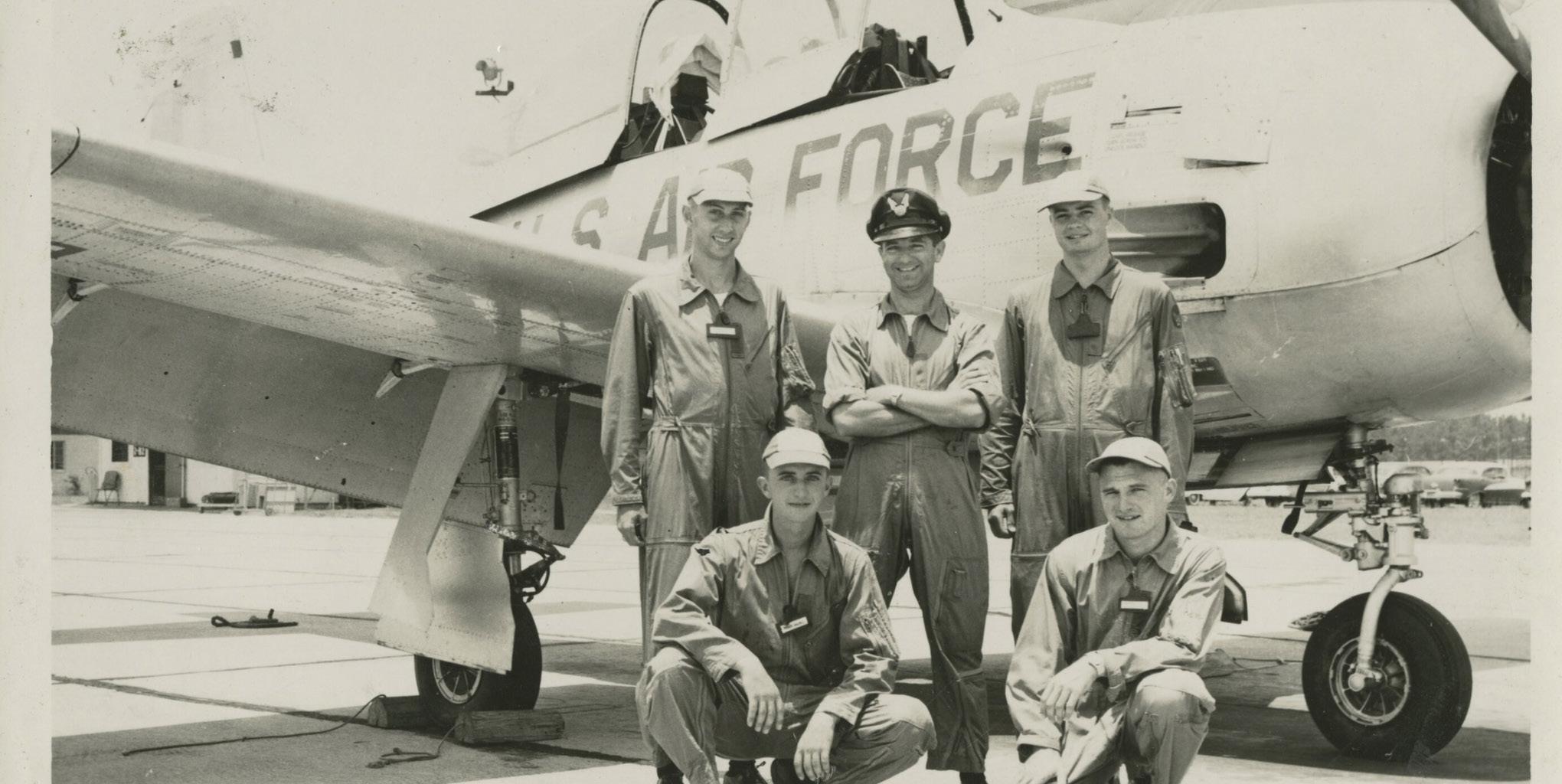
The land was purchased in January of 1942, and construction began on April 3, 1942. Partial completion was on August 25, 1942, with the first troops moving in on September 4, 1942. At this time, all of the buildings still needed to be completed, and it was necessary to have administrative offices in the city of Bainbridge.
The landing field was placed in the southern section of the land, using the flattest terrain in the area. This consisted of three asphalt runways, every 50 feet by
5,000 feet and two asphalt and concrete runways, 50 feet by 5,100 feet and 16 taxiways made of asphalt, varying in size from 50 feet by 325 feet to 50 feet by 3,938 feet, and one concrete aircraft parking lot, 600 feet by 3,900 feet.
The technical area was located in the center of a group of warehouses that the lumber companies once used. There were 53 buildings constructed from local timber, which included a rather large hospital and a chapel, as well as machine shops, maintenance shops, and an operations building. The only metal buildings were three hangers, a motor pool, and water storage tanks. Also, there were base engineering shops and other miscellaneous structures.
For relaxation, there was a student
BICENTENNIAL EDITION 74 DECATUR COUNTY AIRFIELD
Submitted Photo
PROTECTING OUR COUNTRY: Several pilots in training pose in front of the U.S.Air Force jet.
DECATUR COUNTY AIRFIELD
center, mess hall, store, basketball court, volleyball court, golf course, woodworking shop, and gymnasium. This created a “home away from home” atmosphere.
The base was a bustling place as thousands of pilots trained in this field, then flew worldwide. In addition to flight training, thousands of men attended navigation, administration, and aircraft maintenance schools. The entire area was fenced in, and paved roads stretched out to every part.

The first military man assigned there was Commanding Officer Colonel Choates. He rented a room from Francis Kwilecki, and the local residents got to know him well. He was very popular and made many public relations talks to local groups.
A ceremony was held, hailing the arrival of the first plane, and Colonel Choates was the pilot. Unfortunately, it crashed on landing, and he was severely injured. After months of hospitalization, a special service was held to honor him for what he had meant to Bainbridge.
By this time, the base was home to several thousand men. Local residents made many friends from among the base personnel. The USO operated a service club in the Callahan Building, complete with a live band and dancing.
However, around 1943, the Air Force started construction of a larger base in Florida for B-29 bombers. They were grading hills and draining swamps for the runways. Our local leaders went to the Pentagon to plead for the Bainbridge Air Base to be expanded, but lost, and the base was eventually closed. It was then partially fenced in with barbed wire and became a German POW camp for 200 men, an off-chute of Fort Benning. The German soldiers were brought here to help the farmers harvest their crops. With most local young men in the military,
there was a shortage of workers. Also, at this time, most farmers did not have much equipment, and they relied on manual labor to get the job done. The German prisoners provided this muchneeded service.
Researching this era is difficult, and there is not much known about the camp. However, some long-time residents did share their memories.
A small child during World War II, one lady recalls seeing the prisoners come to work on her farm each morning around 6 AM. Traveling in pickup trucks, which had high wooden sides, they would go out into the fields with her father. Then, just before dark, they were taken back to the airbase.
She remembers not being allowed to talk to the men or give them food. This was against Southern hospitality, and was especially hard for her mother to accept. She loved cooking and serving her fried chicken and cornbread. However, the
prisoners would bring their own lunches in paper sacks, as well as drinks and water from the base.
When the seasonal work was done, her father had gotten permission to have a large fish fry for everyone. He brought out his accordion, and everyone sang and laughed, enjoying the get-together. The German men would sing along in their home language, making an unusual type of music.
Most of the prisoners were young and homesick for their families, and seemed to adopt a family member from the farms where they worked. She remembers that they enjoyed playing with her little brother, who she said loved all of this attention.
A gentleman remembered that when he was around fifteen years old, he met one prisoner, another young man of eighteen, who knew some English. Together, they would talk of football and soccer, a game which was unheard of at
THE POST-SEARCHLIGHT 75
Submitted Photo
SIR YES SIR: Soldiers salute their commander at the Air Force Base located in Decatur County.
Theatre chain of Columbus, the Ritz showed a wide spectrum of movies such as “Little Women,” with Kathryn Hepburn in 1934, along with the most popular Westerns.
The Ritz came under new management on June 17, 1943, and remained popular until it closed in 1949. Some longtime residents recall memories of the Ritz, describing fun times going to see the movies and the sloping floors of the theater, which made it easy for everyone to see.
The Coca-Cola Bottling plant near the northwest corner of Shotwell and Broad Streets, in downtown Bainbridge, was once the site of a movie house. On April 6, 1950, The Martin Theatre chain opened its new theatre with the showing
of its first movie: “Jolson Sings Again,” starring Al Jolson. This theatre was located across the street from the Hart - Rollins building. It was next to the Callahan Building, on the same side where the Callahan Theatre used to be located. Now, where the Martin Theatre was, is the driveup window for the OZK Bank. This theatre had air conditioning and a newly designed, modern front. Customers came and filled up its six hundred fifty seats. Apparently, the Martin Theatre had some racy movies for the times. Its marque in 1969, states: “Jack Lemmon and Catherine Deneuve are ‘April Fools’in Technicolor. And beginning Thursday to Saturday, ‘Hell’s Belles.’ Meet the debutante in a leather skirt. Too young,
too tough, too itching for action to look for it, she’ll make it where she is!”
The Martin Theatre chain expanded to build the Azalea Drive-In in West Bainbridge. Clarke Gurley loved his job and became the manager of the Azalea, as well as the Martin Theatre. He did this for many years. However, another invention became popular: the television, and the theatres eventually closed. The Martin Theatre was demolished in May of 1973, when the First State National Bank sought to relocate its main office to this location.
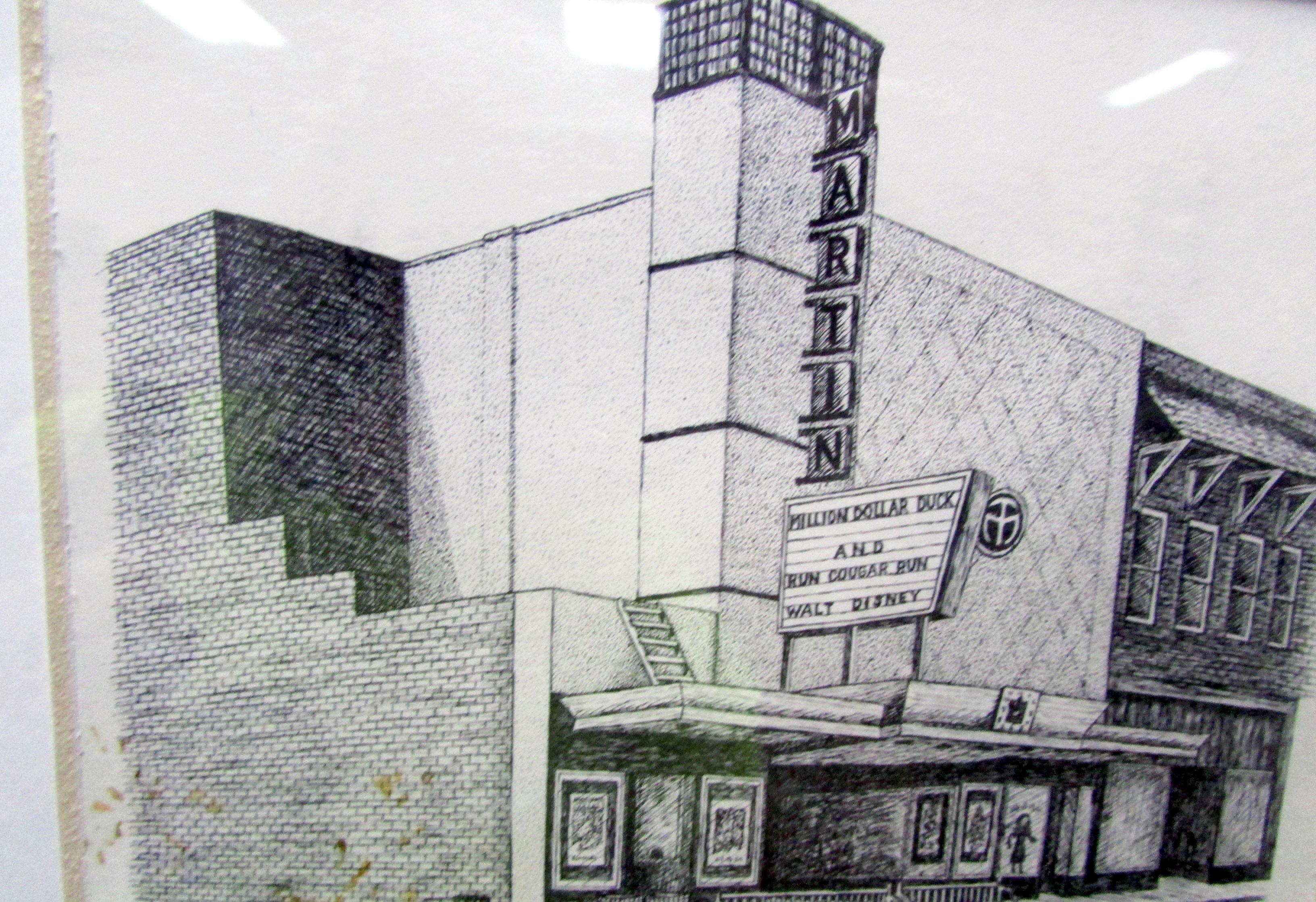
THE POST-SEARCHLIGHT 73
DECATUR COUNTY ENTERTAINMENT
DECATUR COUNTY AIRFIELD
this time. He was very interested in learning about their different way of life. The young man taught him the rules of soccer, and he taught him the rules of football. Soccer did not quite make sense to the young American, because, as a football fan, he thought that the ball should be thrown, not kicked.
Using the prisoners to help in the harvest was seen as a good solution. Thus, the men had something to fill the time, and they earned eighty cents a day, which they used to purchase items at the camp store. There was one guard for every thirty prisoners. None tried to escape.
From 1942 to 1945, the airbase was a busy place, but after World War II, and the closing of the POW camp, the base was closed. In 1951, at the beginning of the Korean War, the Southern Airways Company came and breathed fresh life into the airfield by opening a pilot training center for jet planes, as well as a glider school. The Hercules Construction Company began building new structures: brick barracks, a new mess hall and a chapel, as well as renovating others. The Hercules Company stayed until January 1952, when base maintenance took over their job. Students began arriving in September, and flight training officially started. However, not all of the buildings were completed, but by the time two more classes arrived at Christmas, they were ready to be occupied.

One situation that the men learning to fly always commented on was the fact that when they took off and landed, they went over workers who were harvesting peanuts or picking cotton from the fields located inside the boundaries of the airport.
On December 21, 1961, at 11 AM, Southern Airways Company ceased. One hundred seventy men received their diplomas as the last class graduated from the school at Bainbridge. While a training
base, our airport amassed an incredible safety record, with 32,280 safe take-offs and landings.
Now, only a skeleton crew remained on base to take care of the buildings. In March of the following year, Decatur County took over the airbase.
At the modern Decatur County Airport, nothing remains of the barracks where the prisoners were housed. They were torn down a long time ago. However, many of the other buildings are still in use, including the brick barracks built by Southern Airways. Also, many warehouses are still being used by other manufacturing businesses in Decatur County’s Commodore Perry Industrial Park. The oldest existing structure is a hanger that was constructed during World War II.
Now, this double hanger has been renovated and is available as rental space for private planes.
The Decatur County Airport also offers Phillips 66 fuel, available by self-service with Visa or Master Card, 24 hours a day. The terminal also has a lounge for pilots and crews that is open 24 hours a day. Also, there is a snack area and a kitchen, a meeting room for small conferences, a courtesy car, and up-to-date weather information.
Not only did the airbase train pilots, many of which became flying aces, it was also home to many men who fought and died in World War II and the Korean War, to keep the world free.
BICENTENNIAL EDITION 76
Submitted Photo
A VIEW FROM ABOVE: An aerial view showcased just how large the Bainbridge Airfield was for a community of its size.









Newspaper provides snapshots of historical moments through the years
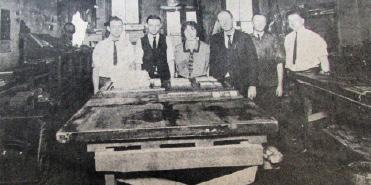
The history of newspapers born in Decatur County is almost as numerous as the number of families who have worked hard, giving their hearts and souls to create progress in southwest Georgia.
Beginning with the establishment of the first newspaper here in 1829, the many publications serving our area’s people are remarkable. Although weekly publications have dominated the field, there have been, for brief periods, some daily newspapers in our past, and at least one publication published three times each week.
The first newspaper of record was the Southern Spy, published by Marshall Smith for the first time on May 26, 1829. Smith came to Decatur County from
Baldwin County and published his newspaper for a period of about two and a half years. Also, former Congressman Mason O’Neal obtained photostatic copies to be placed in our Gilbert A. Gragg Library.
Marshall Smith wrote his newspaper every Tuesday, which included both county and town affairs as well as state, national, and world events, from his office at the corner of Water and Early (Now West) Streets. It gave me chills when I had the honor to read what the original masthead said: Southern Spy Newspaper, Vol. 1 No. 1 Library of Congress, and May 26, 1829. Marshal M Smith – 8 pages”.
Additional published copies were on June 23 and 30, July 28, August 4 and
25, September 1, October 12 and 20, November 10, December 15 and 29, 1829; and on January 5, 1830.
In an editorial written by Smith, he stated his dream to be that the Southern Spy was a: “No party paper. It shall illustrate and defend the right of man. It will undeviatingly maintain an independent character, be free for the explanation and defense of the opinion of any party on political, religious or philosophical subjects.”
A very easy-to-follow history of our area of Georgia and west Florida was in the first issue. At that time, the counties that existed down here were Thomas, Decatur, Early, Baker, Lowndes, Ware, and Appling.
The historical account started in 1497
BICENTENNIAL EDITION 78 DECATUR COUNTY NEWSPAPERS
Submitted Photo
THE EARLY YEARS: This picture was taken in 1921 at the office on Troupe Street when Pat Griffin was publisher.
and went to what was then the early 1800s. There also was a report on what was going on in the meeting of the Climate Creek Indian Council.
The first edition also had this story about the arrival of the steamboat Robert Emmett. “The Emmett was 125 feet long, 22 feet wide, and had berths for 18 passengers. However, on this trip, it had 16 passengers.” The article says that the steamboat carried enough merchandise “to open a cotton gin.” It then continued, “There is a prospect that cotton will improve as the stack of cotton from America in England does not exceed 50,000 bales”. Captain Wood, Peter Cohen, and Captain Simpson were mentioned as the steamboat owners. Spirits and wine could be bought at Dr. Ridley’s house at Porter’s Ferry on Chattahoochee River. There were recipes and a poem in memory of Bugler Hughes, who was killed in 1817 and buried at Fort Hughes. Features included were about an up-and-coming Festival Dance for the 4th of July. Admission was $1.
Classified ads included items for sale, sheriff sales, and the sale of lands such as seven town lots and one hundred acres of pine land. There was a report on what was being covered on the court docket and stories from other parts of Georgia and other states.
At first, The Southern Spy was primarily read in the Southern counties of Georgia. However, because of its varied content, it became popular, and its circulation spread into Alabama, Florida, and North and South Carolina.
The Southern Spy existed for two and a half years. Then, sometime in 1831, Smith moved to Alabama, where he continued to write a newspaper.
Although it was published briefly, the Southern Spy has been noted by editors and publishers through the years as a:
“journal of high standards, accuracy, and exceptional style.”
The Georgia Reporter joined the Southern Spy in 1830. Jared Averitt, who published the newspaper, only did so for a year, then moved to neighbor Thomas County.
Another newspaper that claimed to be the first one in Bainbridge was the Southern Sun. Believed to have been started by Jared Averitt, the date of its publication could never be proven, and the date of the Southern Spy had been verified. Therefore, historians are sure that the Southern Spy was our first paper.
From the 1830s to the 1850s, there were several papers in Decatur County. Some were clear about their names and editors, but others presented a challenge as their history resembled spaghetti.
The addition of newspapers in Decatur County came relatively quickly. Some left quite quickly, making the timeline about their names and editors, and publishers needed to be more specific and clear. Some papers existed for such a short time that they never took the time to establish themselves. Then others operated for a brief period and either were discontinued, were bought out by other publications, or were succeeded by other newspapers which changed the name. In addition, some of the more popular newspapers stopped publication at various times. One of these interruptions took place during the War Between the States. However, after it was over, some were reestablished. Most papers now became more area wide in their circulation while others wrote primarily about the county.

THE POST-SEARCHLIGHT 79
COUNTY NEWSPAPERS
DECATUR
Submitted Photo
A FAMILY AFFAIR: Sam, along with the love of his life, Mary Ann, and their daughter, Ginger, who is in front, at the bi-centennial celebration in 1973.
DECATUR COUNTY NEWSPAPERS
The Southern Sun, reestablished itself in 1869 with John R. Hayes as editor. After being printed for a short time, it was then published under the editorial supervision of R. M. Johnston.
By the mid-1850s, the American Standard was being published in Decatur County. However, on March 4, 1856, the Bainbridge Argus replaced the American Standard. Edited by William M. Russell and published by John T. Wimberley, the Bainbridge Argus had four pages and sold for two dollars a year. It had an unusual motto: “Riotousness Exalted a Nation, but Sin is a Reproach to Any People.”
Russell and Wimberley were both native Georgians. Russell was a good writer and proclaimed this new paper independent in politics, although it was more democratic than the American Standard had been and was adamantly anti-republican. Russell was described as a tireless champion of education, including education for women, a supporter of the church, and a man very concerned about the economic progress of this town and county.
Between 1856 and 1858, the Bainbridge Argus was the official Decatur, Early, Calhoun, Baker, and Miller Counties newspaper.
Sometime in 1857, Wimberley sold his part in the Bainbridge Argus to become co-editor of a new paper, the Southern Georgian. Wimberley’s co-editor now was a young bachelor still in his twenties, named Alexander N. Murphy. A native of Scotland and only recently naturalized, Murphy had a fiery temper. He was unrestrained as a writer and as a speaker. His talent in the latter field led to his election as secretary of the Bainbridge Debating Society. “The Union as It was – The Constitution as it Is” became the motto of the Southern Georgian.
Murphy was forever baiting and
criticizing the Bainbridge Argus but has yet to draw a reply from the more moderate Russell. Although Murphy had admirers, you can imagine that he rapidly accumulated enemies. Among them were two men, one of whom, according to Murphy: “was a man of many words about nothing.” The other he described as a: “self-conceited, puffed up heroicmilitary aspirant.”
In 1857, the Southern Georgian, or the Southwestern Georgian, came on the scene. J. T. Wimberley wrote it. He was succeeded as editor by A. N. Murphy. In 1859, The Southern Georgian was purchased by Reverend George Bright, who changed the newspaper into a church publication that favored religious and family matters. Also, in 1859, another new paper came on the scene. The Southern Gazette was also published in Bainbridge.
In March 1861, Murphy’s paper, the Southern Georgian, was merged with the Bainbridge Argus to form the Southern Press. Owned by the firm of Colonel Hugh M. King and Mr. Williams, this new newspaper’s motto stressed: Southern Honor, Southern Rights, and Southern Interests.
Even though now they worked together, Murphy’s bad feelings for Russell lingered. A prominent member of the Russell family, Benjamin H. Russell, and Murphy got embroiled in a heated argument in May 1861. Murphy then carried this argument to the limit, ending with Murphy ultimately killing Benjamin H. Russell. A sardonic observer who attended Murphy’s trial remarked that the difficulty originated from politics.
Then, with the start of the War Between the States, few newspapers were printed because men, paper, and ink had to be put towards the War effort.
After the War, here in Bainbridge, The Chart and Compass, edited by William
M. Russell, began printing in 1865. Then, in 1866, Russell reestablished the Bainbridge Argus. Also, in 1866, the Southern Georgian was reestablished by George A. Padrick, and the Southern Sun began printing once again. This was in 1869, with the editor being John R. Hayes. Later he added R. M. Johnson, who was in charge of the newly established editorial pages. In 1870, the Bainbridge Democrat came on the scene with local hero Benjamin Ellsworth Russell as editor and a man named Jones as assistant editor.
By 1877, the Bainbridge Democrat was the only remaining paper in town with Russell and R. M. Johnson as editor and co-editor. However, with Johnston as a co-editor, Russell became the publisher of the paper.
These stories were in the Bainbridge Democrat, on March 19, 1891: The Globe, a weekly newspaper, was sold to the leaders of the Populist, or Third Party, on September 8, 1892, C. H. Thomas as editor and the Bainbridge Argus was being revived with the first issue having been on the previous Thursday.
Then on April 28, 1898, the Bainbridge Democrat announced the beginning of a new weekly paper, the Search Light, with Russell Brinson as editor and Johnson and Hines being the owners.
The year 1907 was active in the newspaper business; it saw Wyche Linton become the editor of the Weekly Tribune on March 22. Then on July 13, 1907, the Weekly Tribune changed into the Daily Tribune with a man whose last name was Fackler become the owner and editor. On March 8, 1907, this story was in the Daily Tribune: Vol. 2 No. 16. It stated that E. H.” Pat” Griffin was now editor of the Search Light. Just a month or two later came the story of “Pat” Griffin and the founding of the Bainbridge Post. It didn’t take long for this paper to become the tops in
BICENTENNIAL EDITION 80
advertising in the area.
Then, on March 25, 1915, came the news that had the whole town talking: The Search Light and The Post had merged. In April of 1915, the name of this new paper was to be the Post Searchlight, with E. H. Griffin, as owner and editor. Also included in this merger were the assets of several earlier Decatur County newspapers, including the Daily Tribune, the Globe and the Bainbridge Democrat.
Bainbridge was not yet acquiring newspapers and in 1932. the Decatur County Advance was started by Mrs. Zula B. Toole. I was not able to find out any more
about this paper.
A change came in 1933 to the Post Searchlight when S. Marvin Griffin, “Pat” Griffin’s son, was named publisher of the newspaper. He held this post until 1972, except for a four year period, from 1955-59, when he served as Governor of Georgia. Then, in 1972, S. Marvin’s son, Sam M. Griffin Jr. was named publisher and served in that capacity until May, 2008, when Bainbridge Media LLC sold the Post Searchlight to the newspaper conglomerate, Boone Newspapers Inc. of Tuscaloosa, Alabama.
Not one of the papers published in
Bainbridge before the War Between the States could have been considered mediocre. When lookng at all of the editors, their news was intelligent, they wrote in a skillful styles and were committed to their profession. The newspapers were reasonably accurate and never dull.
In the twentieth century, there was a lot of activity and competition going on between the many papers that were being published in Bainbridge. However, The Post Searchlight is the sole survivor of the skirmishes and of time.
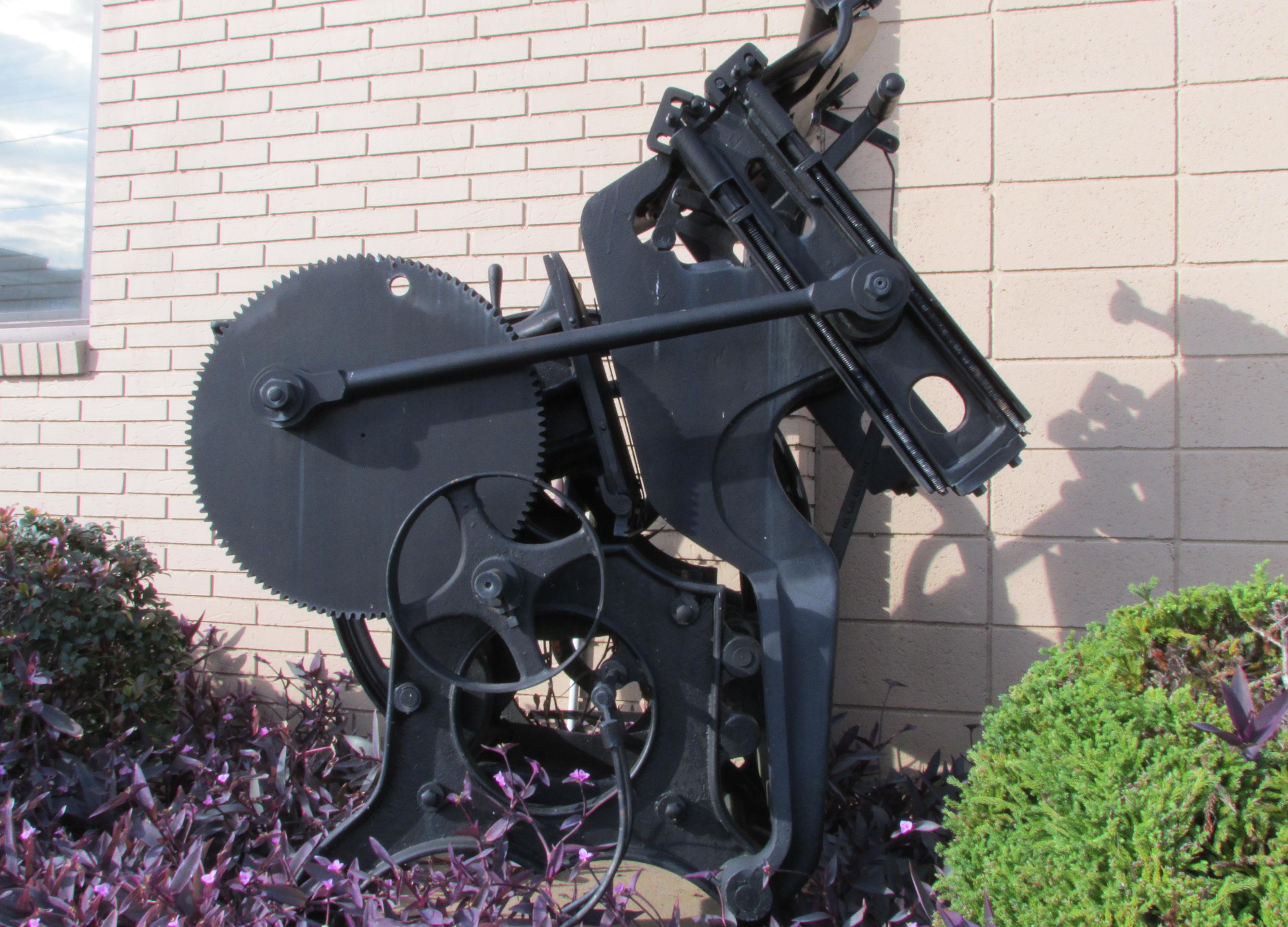
THE POST-SEARCHLIGHT 81 DECATUR COUNTY NEWSPAPERS
Joyce Kramer
ALWAYS IN USE: A printing press that was like this one was no doubt used in the late 1800s.

BICENTENNIAL EDITION 82 Since 2006, BASF Attapulgus has been proud to be a part of the Decatur County community. At our Attapulgus site, we produce catalysts which help fuel the world. www.basf.com
THE MOST RELIABLE RIMFIRE PISTOL FAMILY

Easy-to-rack slide
Double stack 13-round capacity
Slide-mounted optic ready

THE POST-SEARCHLIGHT 83 TaurusUSA.com
NEW









A-1 Industries is the premier building component provider for the Southeastern United States and the Caribbean. Our team members demonstrate our core values of ownership, passion, honesty, and respect, which makes A-1 an industry leader since 1977. 1400 BRINSON AIRBASE RD. | BAINBRIDGE, GA 39817 (229) 442.6500 A1IndustriesGA.com

























































































































































































